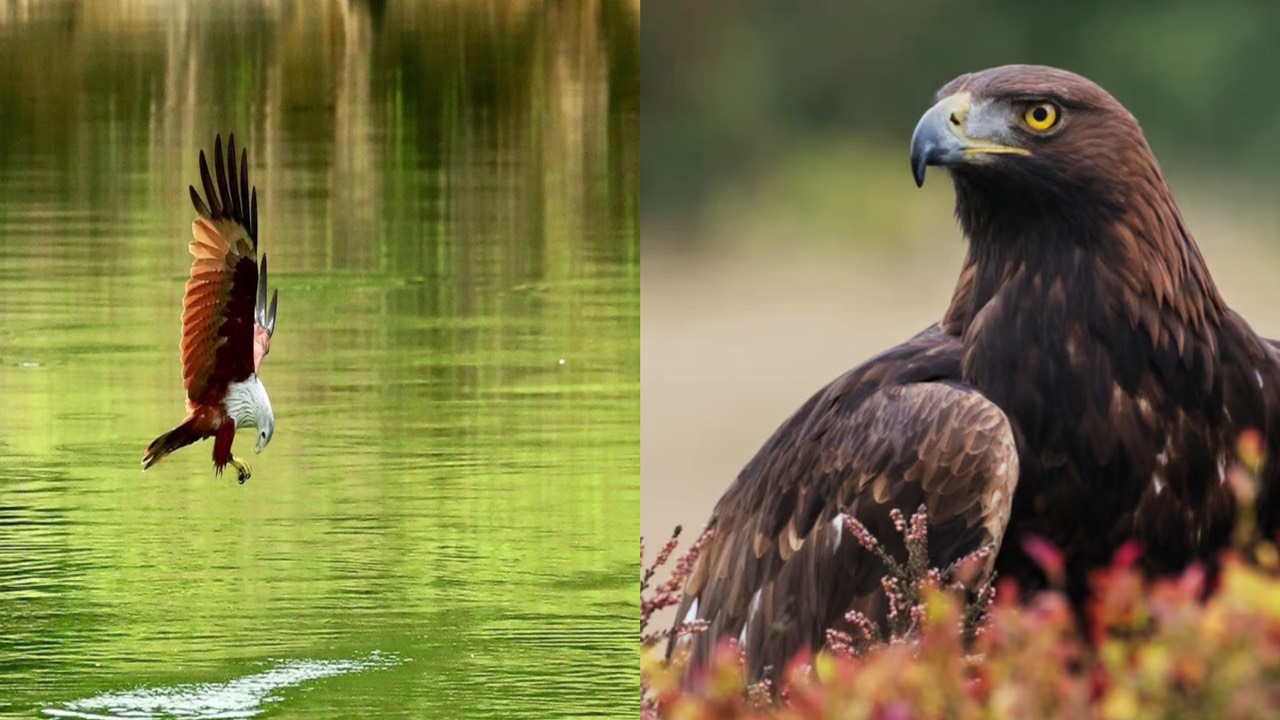
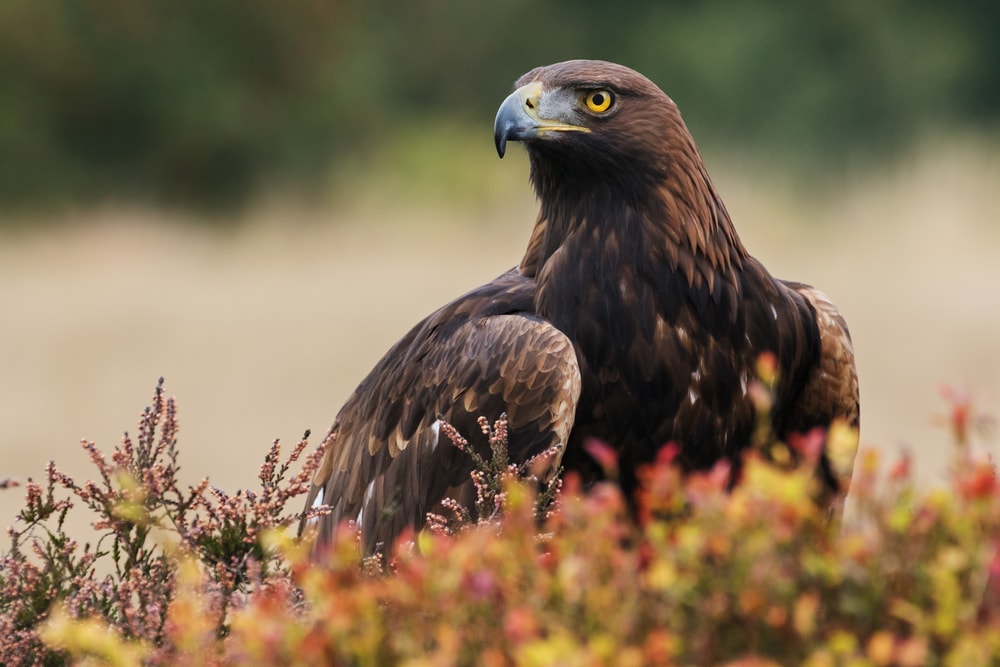
There are about 10,000 different types of birds in the world, and over 900 kinds of birds are found in North America alone. Although we have already found an incredible amount of birds, the Royal Society believes that there are between 25-100 birds yet to be discovered.
Birds are incredible creatures. They’re beautiful, they can mimic sounds, and they are designed to fly weightlessly through the air.
Instead of creating a very long list of all birds we’ve chosen some of the most popular and common kinds of birds throughout the world.
We’ll also discover how birds fly, why they’re important to cultures around the world, and how they may be affected in the future because of climate change.
Different Types Of Wings
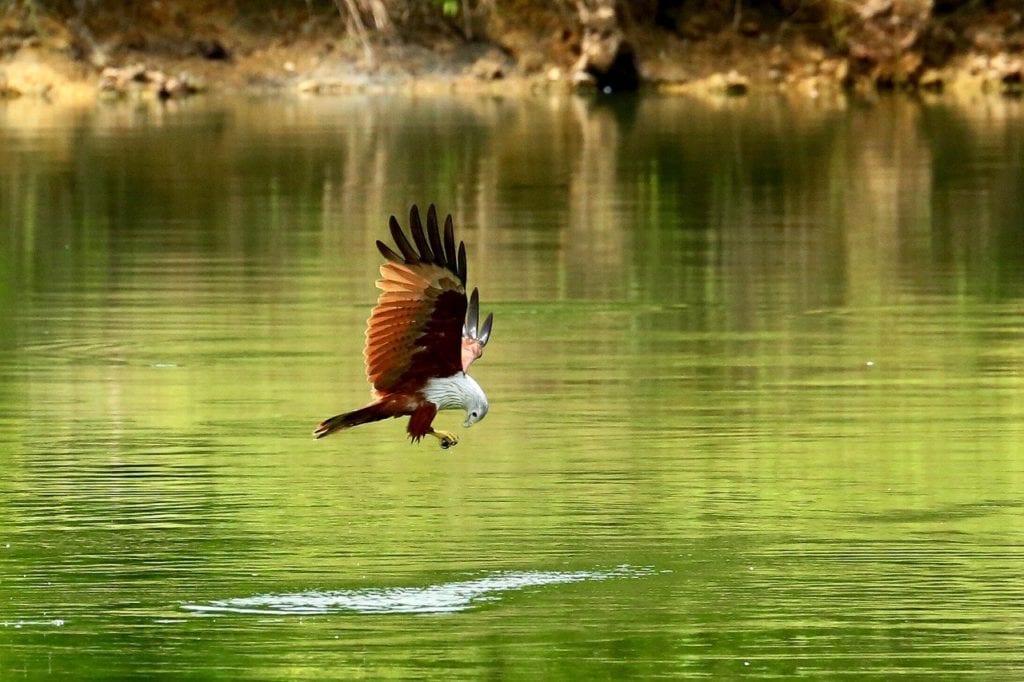
Different bird types are found all across the world. Just as different species of animal’s bodies have adapted to what they need to survive, so have birds.
Some birds are massive, while others can fit in the palm of your hand. Some have beaks designed for cracking open nuts, while others have beaks made for tearing flesh.
In the same way, a bird’s wings are designed based on their lifestyle and their specific needs. There are five major types of wing shapes:
- Passive Soaring Wings
- Active Soaring Wings
- Elliptical Wings
- High-Speed Wings
- Hovering Wings
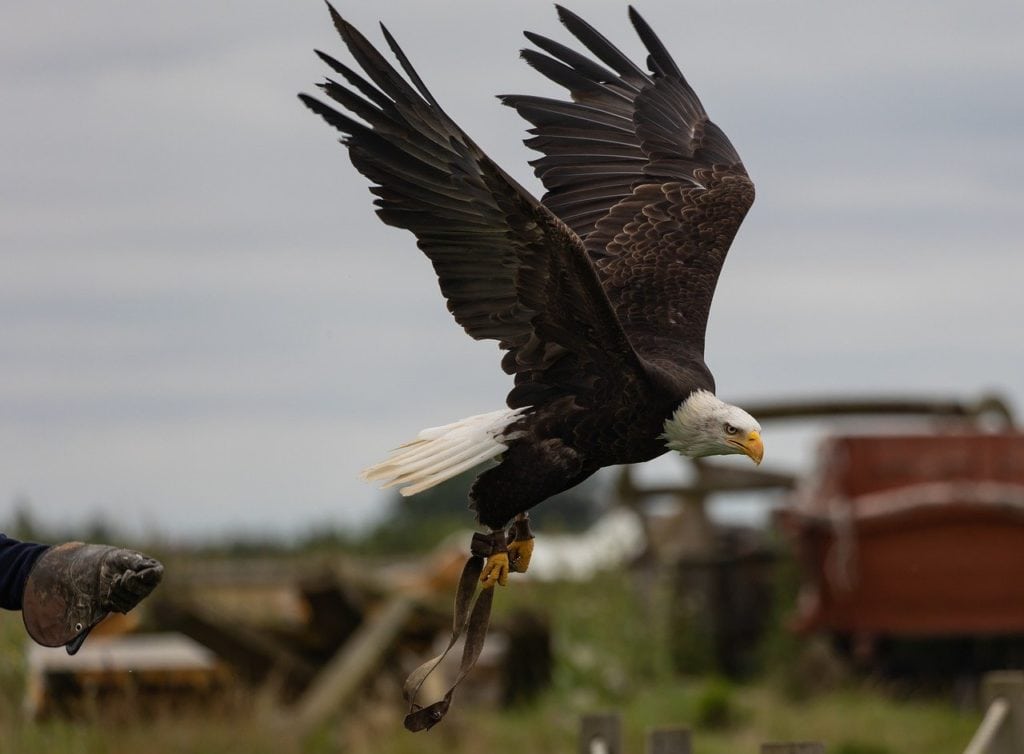
Passive soaring wings are designed to allow a bird to fly higher up in the air. Some birds that have these kinds of wings include Bald Eagles, storks, and most hawks.
The wings have long primary feathers. These feathers spread out widely so that there are spaces between each feather. These spaces allow for vertical columns of thermals, or hot air, to catch on the wings. These thermals then allow the bird to rise higher in the air.
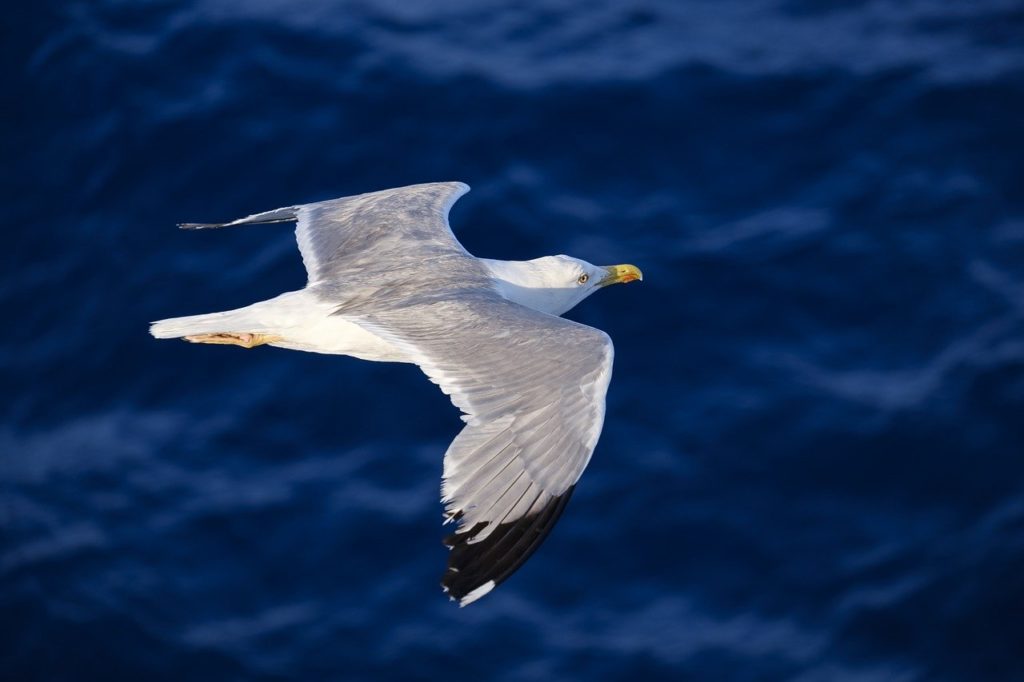
Active soaring wings are designed to help birds fly longer distances without constant flapping. Some birds that have these kinds of wings include gulls, gannets, and albatrosses.
The wings of these birds are narrow, and long. This shape allows the bird to fly for a long time without flapping its wings. Unlike “passive soaring wings”, active soaring wings rely on the currents of the wind. The birds use differences in the wind speed when moving up and down through the air to travel without using much energy.
For this reason, many birds with this wing shape may be found soaring over the ocean where the wind currents can become incredibly strong.
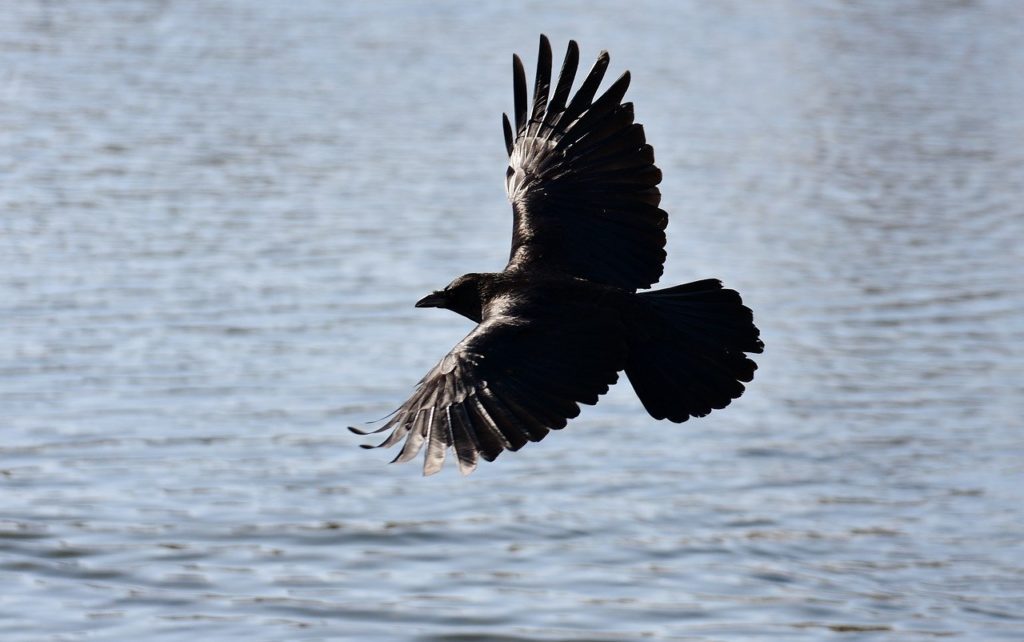
Elliptical wings are designed to allow birds to fly short distances at very fast speeds. Some birds that have these kinds of wings include blackbirds, crows, ravens, thrushes, and sparrows.
These kinds of wings ensure that the birds can have fast take-offs and are able to maneuver around difficult places. This is very important for these birds because they are often prey for other animals, so they need to be able to get away quickly.
Elliptical wings also allow for more difficult maneuvering, and you might see these birds rolling and twirling around in the air.
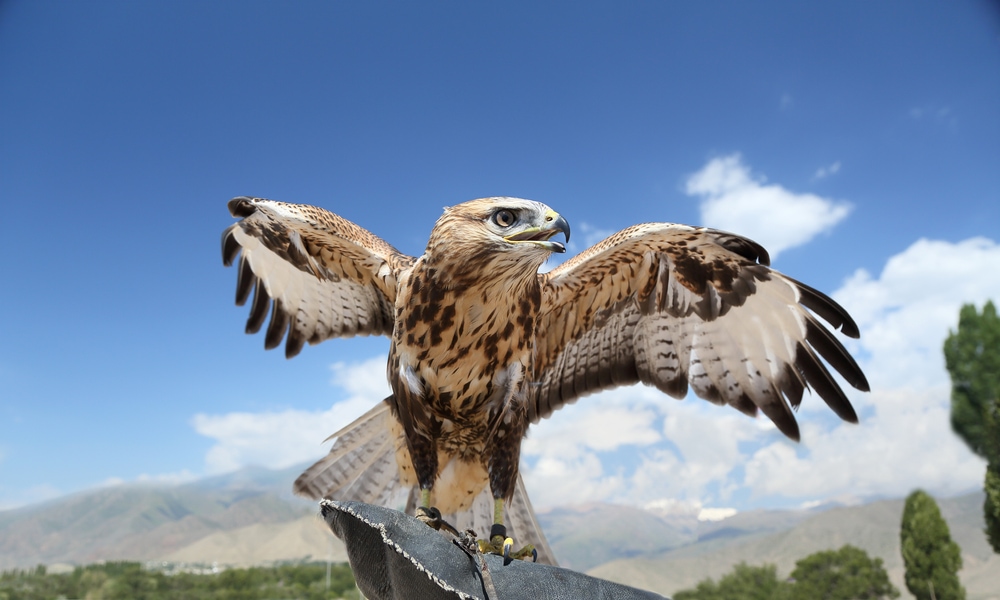
High-speed wings are designed to help the bird fly very quickly while also maintaining its momentum. Some birds that have these kinds of wings include ducks, falcons, swifts, terns, and sandpipers.
The feathers of these wings are thin and long, but they’re significantly shorter than birds with “active soaring wings”.
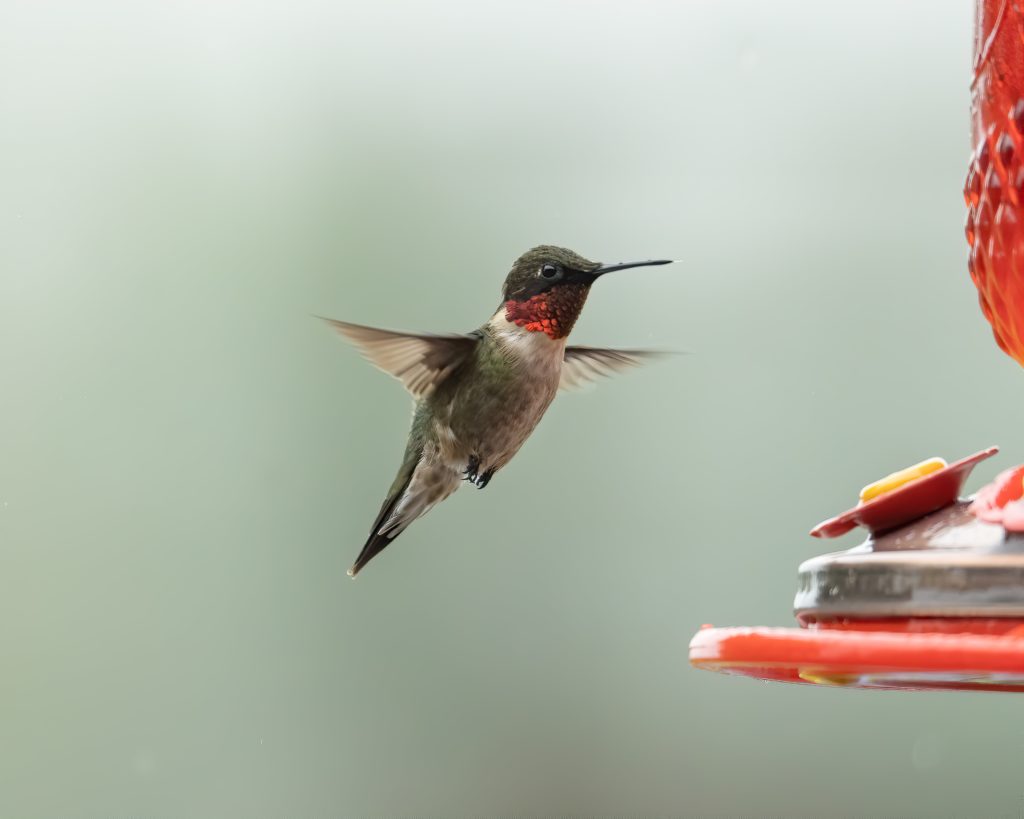
Hovering wings are designed to allow a bird to hover in the air. This means that the bird will not move backwards or forwards, and almost appears to be floating. A bird that has these kinds of wings is the Ruby-Throated Hummingbird.
The feathers of these wings are incredibly small and fast. The nerves and muscles inside the wings are specially designed to allow for rapid movement.
Wing Anatomy
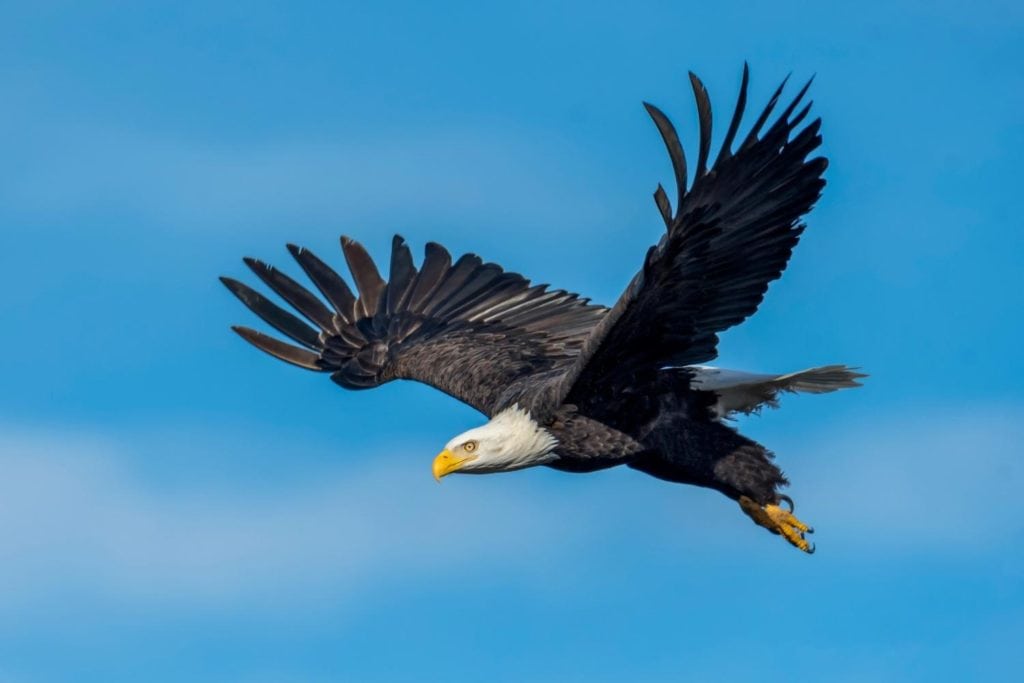
It takes something special for a solid being to be able to glide through the air. A bird’s body and wings are designed specifically to do this.
A bird’s body is very light, and the bones are hollow, allowing the body to stay in the air during flight. Still, birds need specialized feathers and muscles to get those hollow bones up in the air in the first place.
Birds have many different kinds of feathers in their wings, but not all of them are directly related to flying. In order to fly, a bird must have its primary flight feathers. Without them, they cannot fly.
In fact, many pet bird owners will clip the primary flight feathers of their birds to prevent them from flying to keep them safe.
The breast muscles are behind the power of flight. They are attached to the bird’s keel, a large ridge that goes down the center of their breast. When the muscles contract, the wings are pulled downward, which pushes the bird forward through the air. The bird’s wings will move back upward when the muscles are relaxed.
The shoulder joint is what allows the wings to move up and down. In some species, it also allows for backward and forward movements.
The elbow joint extends and folds the wing, depending on whether the bird is actively using the wing or not.
Likewise, the wrist joint extends while the bird is flying, and folds the wing against the body during rest.
Bird Migration
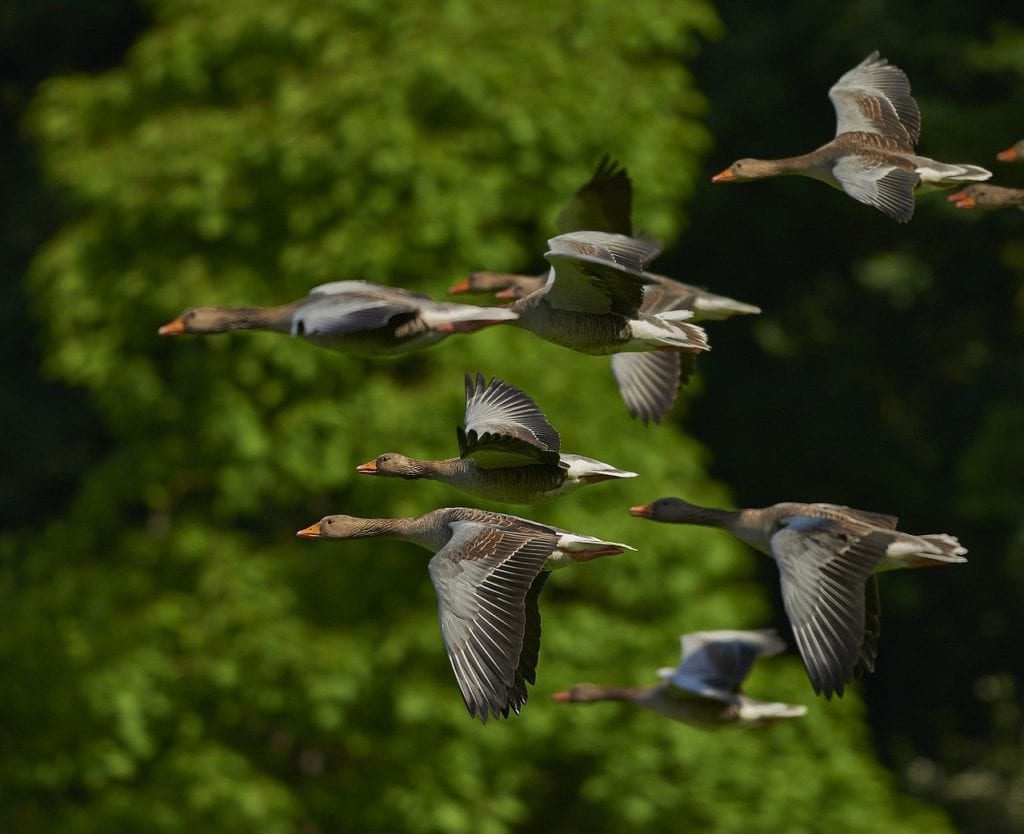
Many birds migrate between their main home and their breeding territory every year. It’s a dangerous journey, so why do they do it? Why is it worth it?

If no birds ever migrated, their food sources would quickly diminish. By migrating, food sources have a chance to regrow and replenish themselves before the return of the birds. Without migration, it’s likely that many birds could starve to death.
Even birds that stay in the same location their whole lives migrate to an extent. No bird ever truly stays in the same exact location for their lifetime. They will go where the food goes. If one location is becoming scarce, they may travel a short distance to find a new location with more food.
Also, nesting and producing young would be more dangerous than it is with migrating. If no birds migrated, then every bird living in the area would breed in the exact same location. This would cause the birds to fight and compete with each other for resources. The large groups of birds would also become easy prey for predators.
Besides this, some locations are simply better suited for breeding. Birds may travel to a certain breeding location because it has better food sources, shelter, and habitats for raising young.
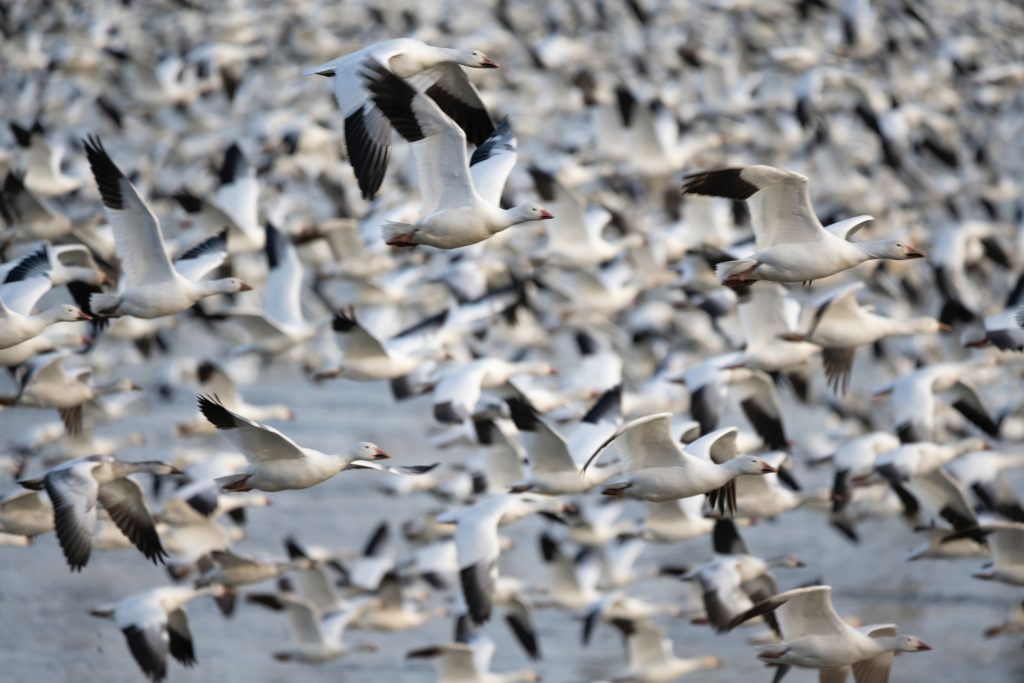
As I mentioned above, birds are all designed differently. This means that they will migrate differently as well. Some birds can make their migration in one flight, traveling extremely long distances in a several hours. Others will migrate for short bursts before taking breaks.
Birds also do not just “wing it” — pun intended — when migrating. Some species will rely on wind patterns to figure out where they need to go. Others will rely on other environmental cues. Some even utilize landmarks and stars.
There are 12 different kinds of migration in total, but 3 are most common:
Effects Of Climate Change

Like I covered above, the majority of birds migrate based on the season and what temperature it is during certain parts of the year. Climate change is driving the temperatures up across the globe, which is likely to negatively impact birds that are driven by the seasonal changes.
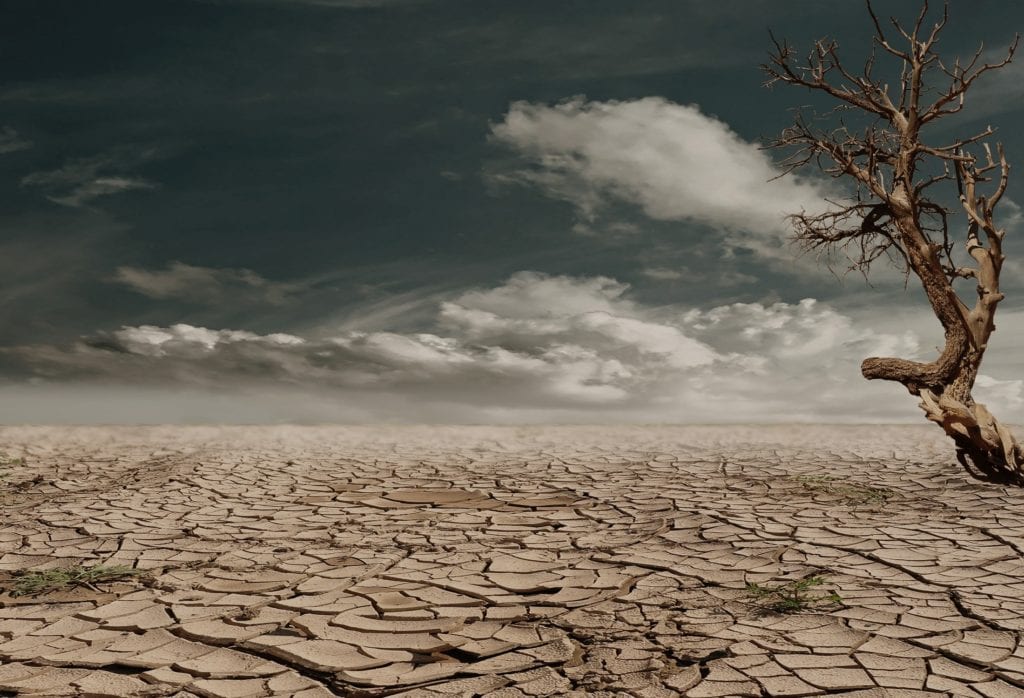
Temperature changes make it likely that birds will have to spend more energy on thermoregulation. By spending more energy on reproduction, they will have less energy for other needs, such as foraging and reproduction.
Increased temperatures may also mess with the breeding seasons. This, in turn, could lead to a lower rate of survival for birds as a species.
Not only will breeding be affected, but the ranges in which birds live is likely to change, too. As temperatures change, birds are likely to move to find habitats with more suitable temperatures. Generally, the higher in elevation you go, the lower the temperatures will be. So, researchers predict that birds’ ranges will shift further towards the poles.
This means that areas that once had certain species of birds will no longer have them, while other areas will receive an influx of birds.
It also means that, for birds very sensitive to heat, they are likely to lose all suitable range once the temperatures rise high enough.
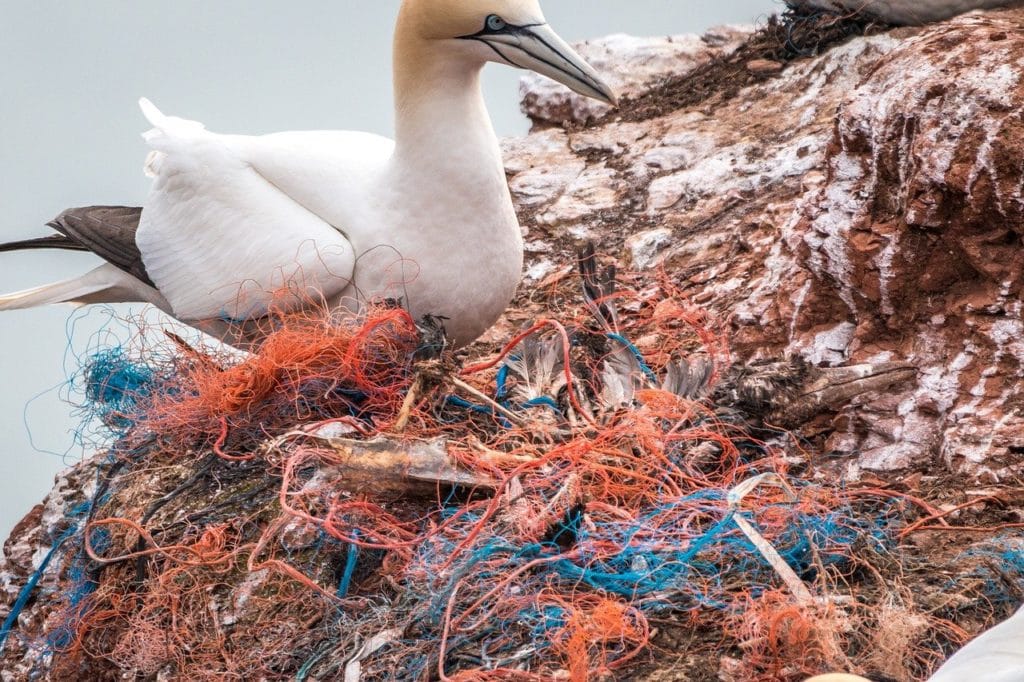
Likewise, it’s possible that temperatures could increase too quickly for vegetation to adapt. This could lead to vegetation dying out in the areas that it normally grows.
The less vegetation available, the more birds will be flocking to the same areas to feed. With less areas to feed, and less vegetation, birds will have increased competition with one another and are more likely to starve.

Along with increasing temperatures comes the increase of the sea level. Glacial melting is the direct result of increasing global temperatures and is causing an increase in the ocean’s water levels.
If sea level rises too much, this could mean a significant loss of habitat for water and shorebirds. Coastal habitats, like mangroves and marshes, will be wiped out from the increasing water.
Anthropogenic Dangers

Over the past 5,000 years, over 500 species of birds have gone extinct as a direct result of human activity. This means that approximately 1 species of bird was going extinct every 10 years.
However, since the 1500s, this rate has been increasing. In the past 500 years, bird extinction rates have increased to 1 bird species per year.
Since the 20th century, extinction rates have been increasing even further due to human activity. Researchers predict that the extinction rate of birds could increase to an additional 10 bird species a year. It is possible that up to 1,250 birds could be extinct by the year 2100.
Let’s put this into perspective. If there were no humans on earth, researchers predict that only one bird species would go extinct every century, or 100 years.
Conservation Efforts
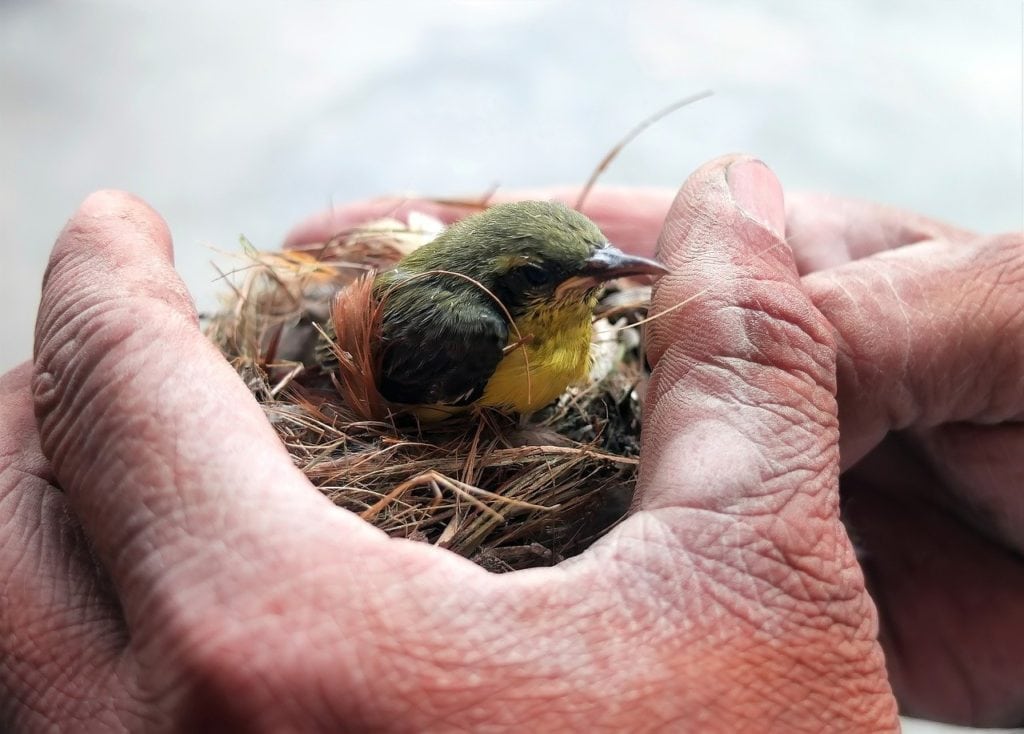
In an effort to save hundreds of bird species from extinction, researchers and policy makers have been working to put protections into place.
The biggest thing we are doing as humans to protect birds is to protect their habitats. When their habitats are able to thrive, so are the birds. To protect habitats, we are preventing forest fires, and regrowing trees where fires couldn’t be prevented.
We are also creating reserves so that bird habitats will not be in danger of deforestation. Deforestation causes excess carbon to be released in the environment, leading to 14% of the total human-caused greenhouse gasses created.
Effort is also being made to protect nesting sites, particularly in shore birds.
Work is also being done to slowly switch to more solar-based power. Fossil fuels are a danger to birds because they increase the global temperatures, leading to loss of habitat.
Other forms of power, like windmills, are also not good. The birds don’t realize they’re a danger and fly into them. Windmills cause many bird casualties every year.
Cultural Symbolism
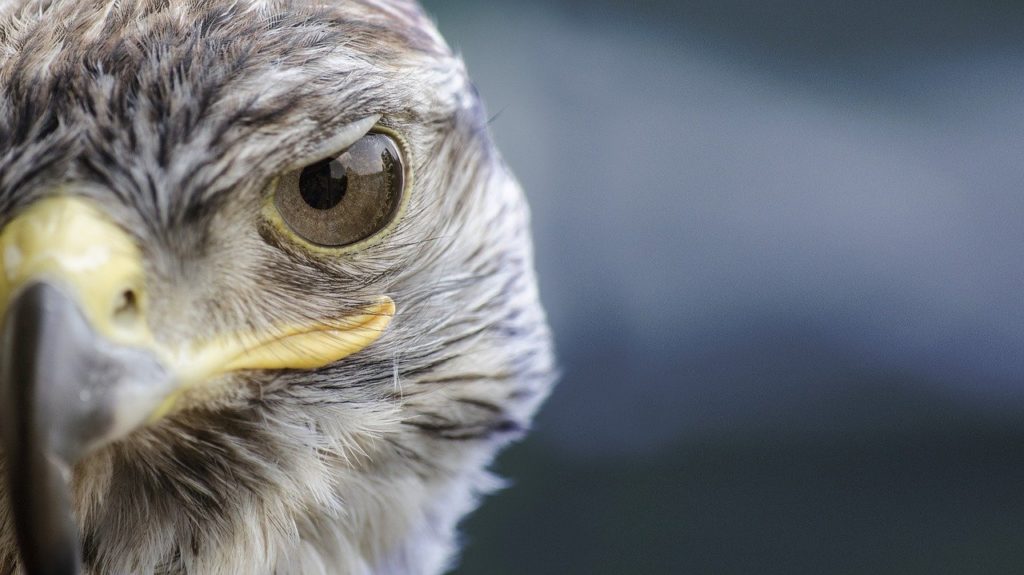
Birds have been revered for centuries and are found in myths and symbolism all across the world. Here are some ways in which birds have been celebrated throughout culture.
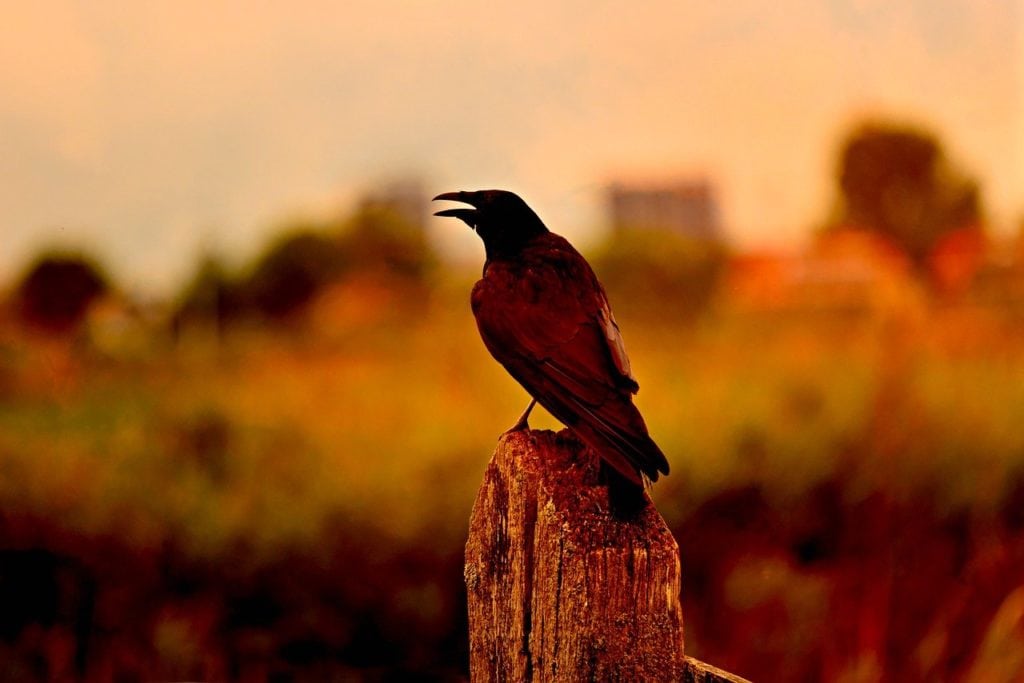
Crows have multiple meanings across different cultures. For many Native American tribes, the crow is considered to be the creator of the world.
In Japan, they are a symbol of love amongst family members. In ancient Egypt, they were seen as a symbol of faithful love.
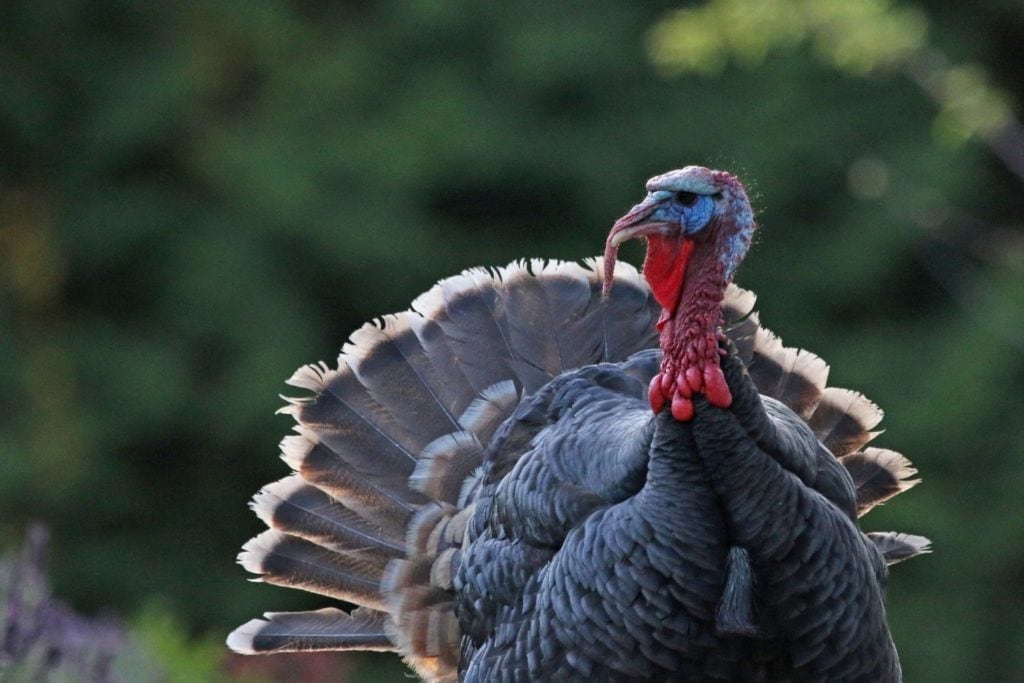
For some Native American tribes, the wild turkey was considered the “Earth-Eagle” and was a symbol of sacrifice. The wild turkey was tied to Mother Earth and was associated with fertility and motherhood.
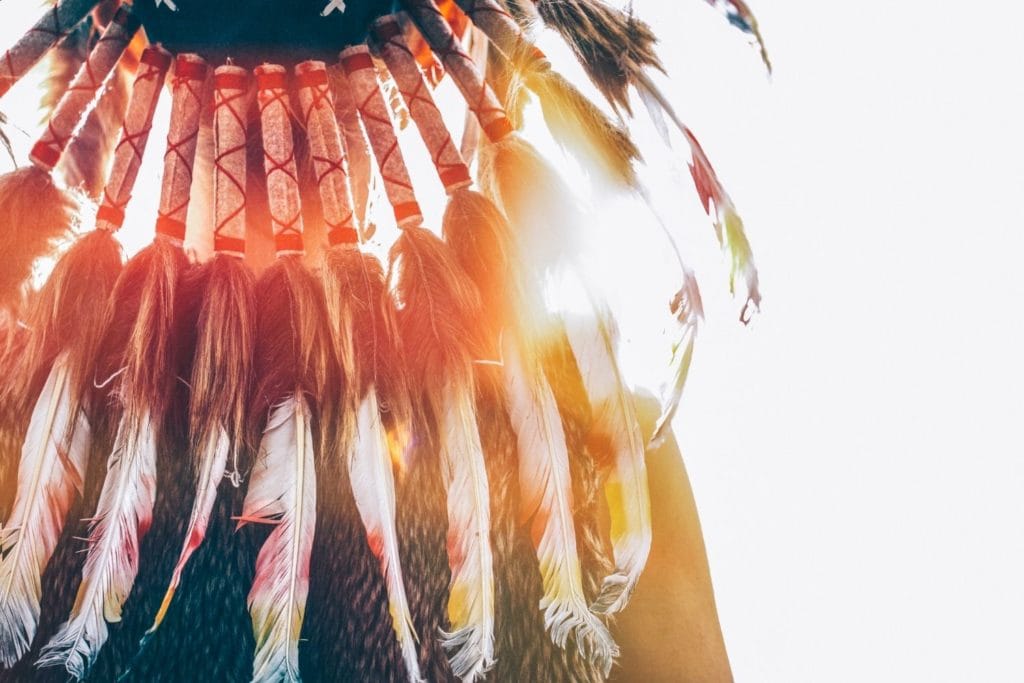
I know I covered crows and wild turkeys already, but the Native Americans revered so many other species of birds as well. Birds were believed to have a connection between the spirit and human world. The gods would use the birds to take messages to humans.
Many Native American tribes would choose a bird species as their clan animal and would dedicate themselves to the creature. Birds were also considered spirit animals, and they can be seen on many totem crests in the northwest.

In Christianity, birds represent hope, mercy, and divine intervention. For example, in the story of Noah and the global flood, it was a dove that brought an olive branch to Noah on the ark. The olive branch symbolized that the flood was ending and that it was soon safe for them to leave the boat.
In the New Testament, a bird came with Jesus while he visited the temple. They were also seen bringing bread to the prophets when they were experiencing trying times.
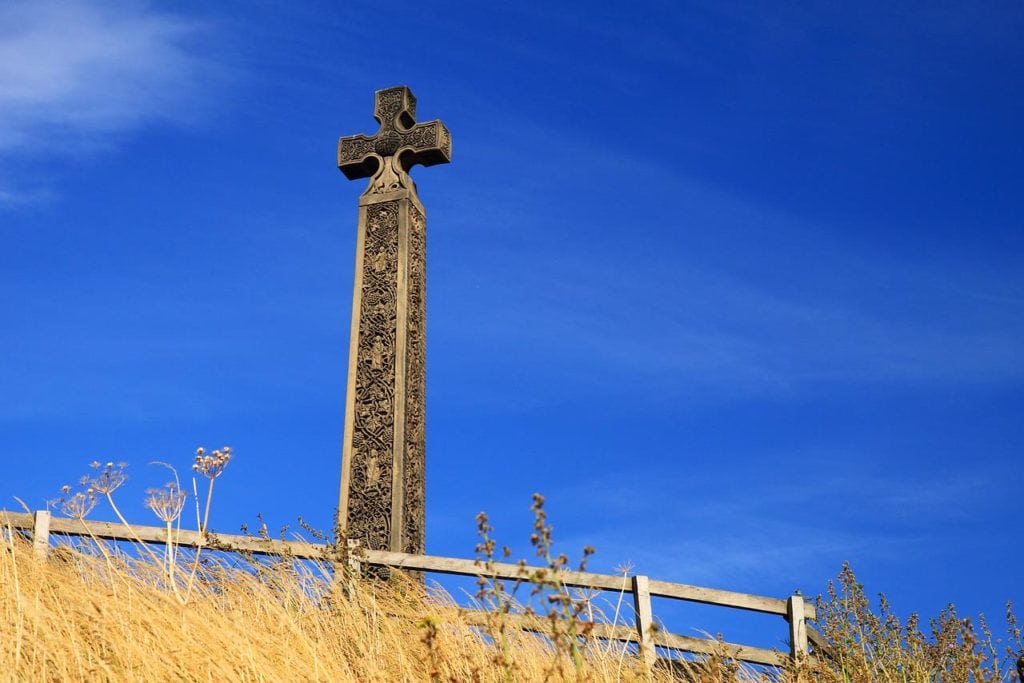
In ancient Celtic culture, birds were a symbolism of freedom and transcendence. The Celts worshiped birds they believed they were reincarnations of people that had passed.
Celts were big believers in reincarnation, and whatever animal you were reincarnated into was a reflection of your past life. Birds were considered to be reincarnations of very well respected and holy people.
Like the Native Americans, the Celts also believed that birds were messengers between humans and the divine. This is because birds have the freedom of flight, and Celts believed the birds could reach the heavens.
You may also like: Learn the 15 Different Species of Long-Necked Birds and Where to Spot Them: With Images, Facts, and More!
Perching Bird
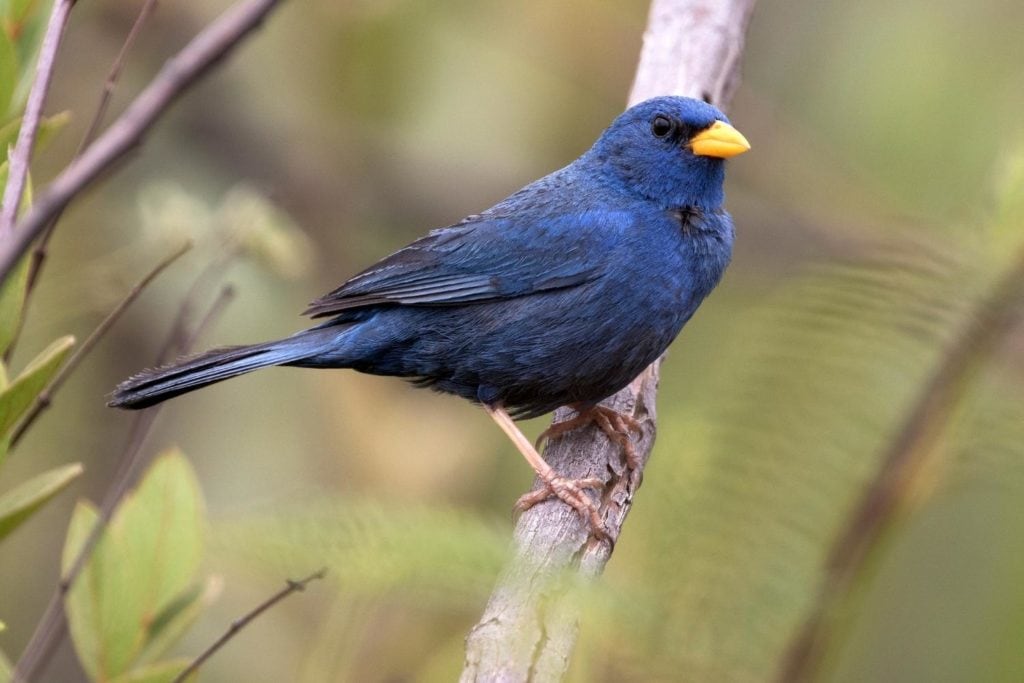
Perching birds, or Passeriformes, is the largest order of birds. There is a large variety of birds, with over 5,000 known species. They have three toes at the front of their feet that are unwebbed. They also have one toe, called a hallux, at the back of their foot. This allows them to easily perch onto things like branches.
Within the Passeriformes order, there are two suborders: Passeri and Tyranni. The Passeri are the songbirds, and the Tyranni are the tropical birds.
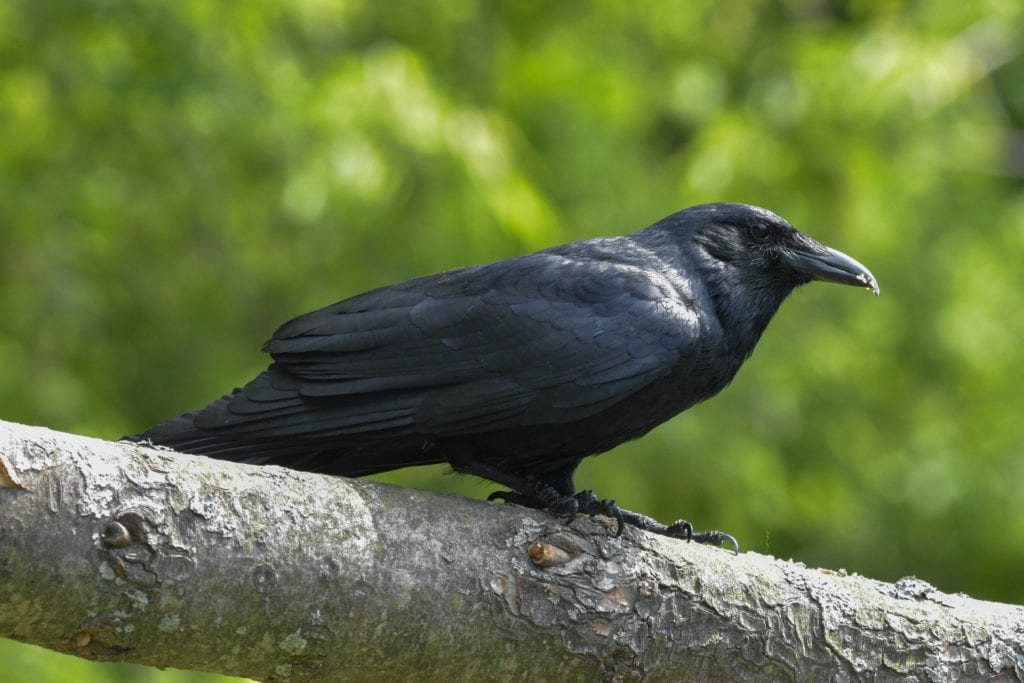
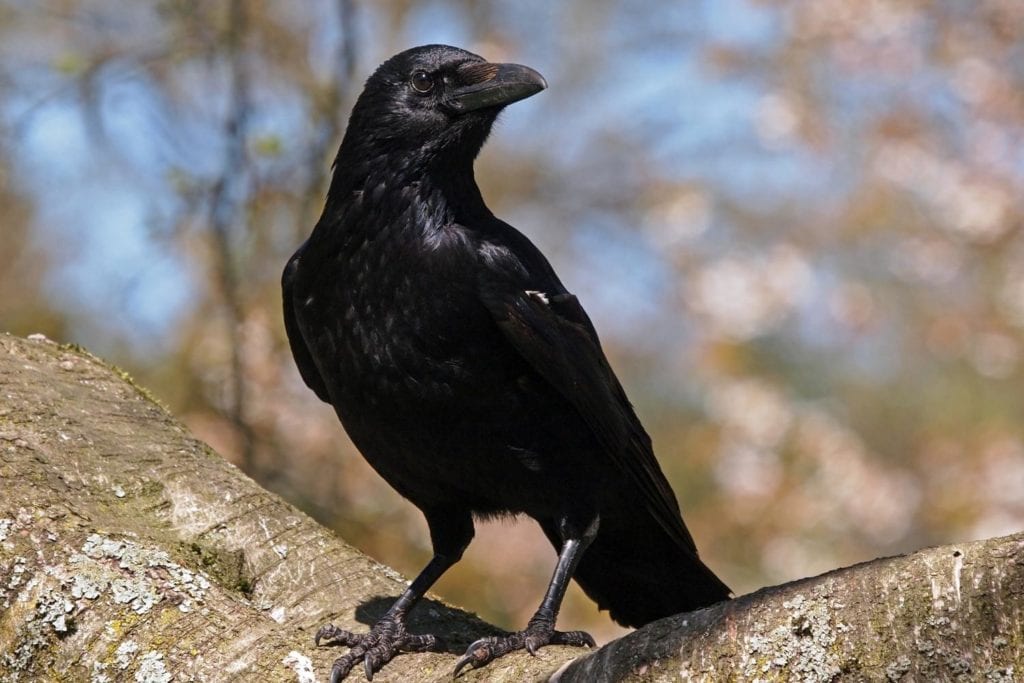
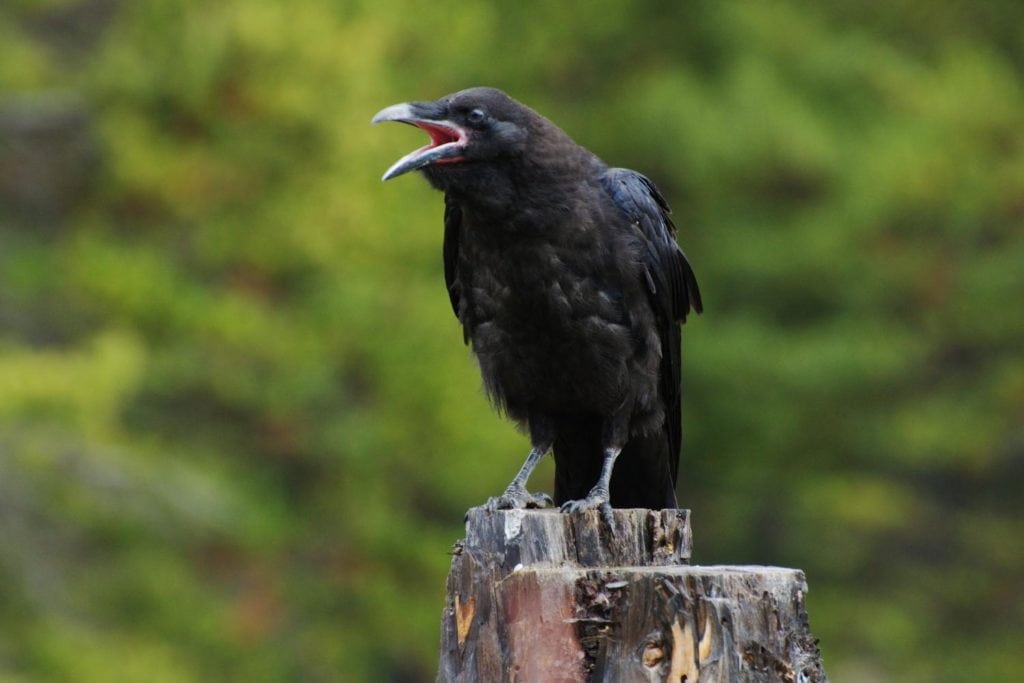
Classification:
Family: Corvidae
Genus: Corvus
Description: The American Crow is a medium sized bird with sleek, black feathers. The tail is slightly rounded, and the beak is short, but slightly hooked.
Diet: They are omnivorous and will eat seeds, grains, fruits, berries, nuts, insects, small rodents, fish, small turtles, eggs, carrion, and garbage.
Habitat: American Crows can be found throughout most of Canada and the United States. They like to live in open areas that are near trees. Some of their favorite locations are agricultural fields or grasslands.
Lifespan: Up to 14 years
Interesting Facts about Crows:
- A group of crows is called a murder
- They can have a wingspan of up to 36 inches/91.4 centimeters
- Crows recognize faces: they will terrorize people that are mean to them, but bring shiny trinkets to people that give them food
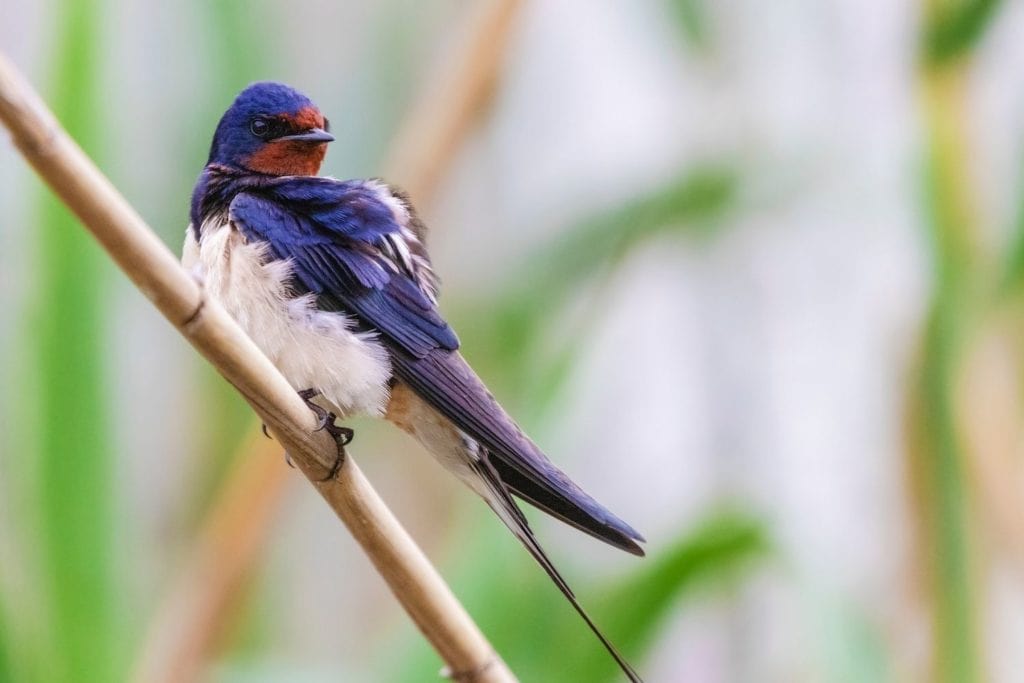

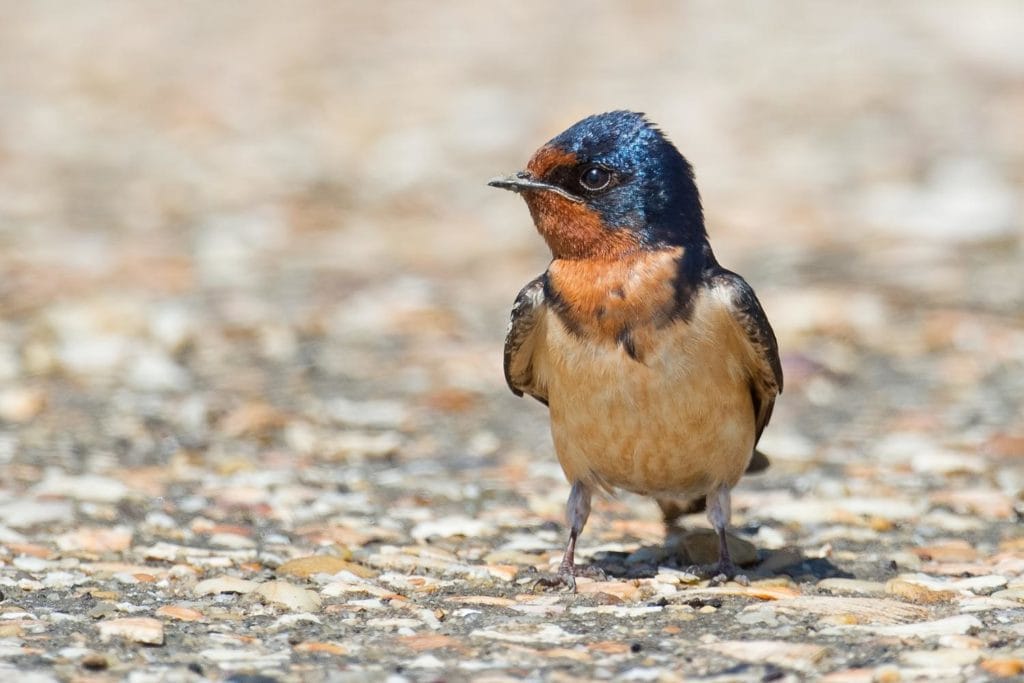
Classification:
Family: Hirundinidae
Genus: Hirundo
Description: The Barn Swallow is a small bird that has a dark blue head and wings. The throat and forehead is a deep orange color. The chest and underside is a lighter orange. The tail is forked.
Diet: They are insectivores who like to eat grasshoppers, beetles, moths, and other flying insects.
Habitat: Barn Swallows can be found as far north as Alaska and Newfoundland. They can be found throughout all of the United States, and are found as far south as Mexico, Central America, and South America.
These birds are very adaptable and can be found anywhere that has an open area for food, water, and a ledge for sheltering. They prefer open areas like agricultural fields, and are often found in barns, hence their name. They are also often spotted under bridges, on boat docks, in caves, trains, and the eaves of old houses.
Lifespan: Up to 8 years
Interesting Facts about Barn Swallows:
- Barn Swallows work with Ospreys. Ospreys will keep Barn Swallows safe in return for the Barn Swallows alerting them to predators.
- Barn Swallows are the national bird of Austria
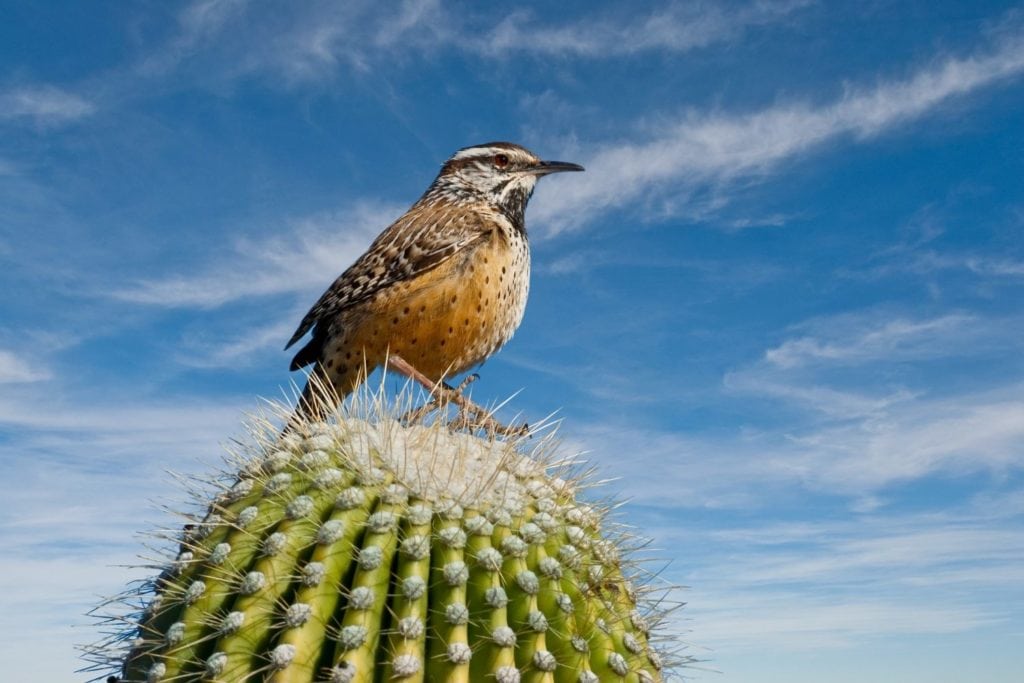

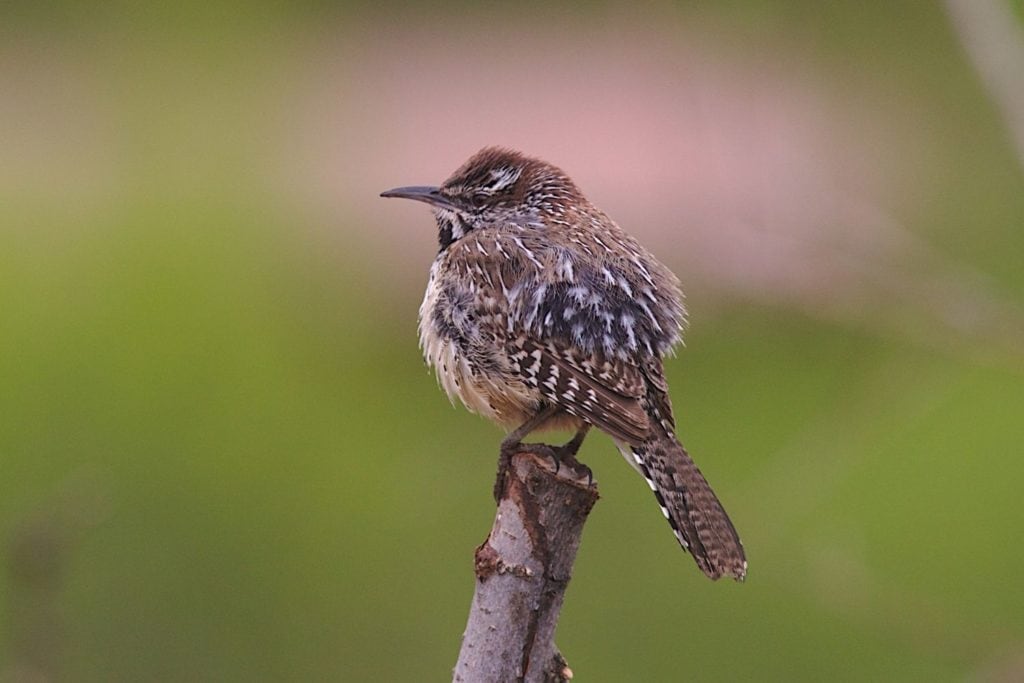
Classification:
Family: Troglodytidae
Genus: Campylorhynchus
Description: The Cactus Wren is a smaller bird that has brown spots over a white belly. Its back has brown, white, and black speckles. The throat has black feathers, and there is also a stripe of white across the top of both eyes. The bill is long and partially curved downward. It also has long legs.
Diet: These birds are omnivores. They forage for things like fruit, seed, ants, grasshoppers, beetles, and wasps. They have also been known to eat small frogs and lizards. They drink very little water and get most of their moisture from food.
Habitat: Cactus Wrens can be found in southwestern portions of the United States like southern California and Nevada, Arizona, Utah, western Texas, New Mexico, and parts of Mexico.
They like to live in areas with arid deserts that have lots of succulents and cacti. They are used to high temperatures and low humidity.
Lifespan: Up to 6 years
Interesting Facts About Cactus Wren:
- The Cactus Wren is the state bird of Arizona
- Female Cactus Wrens will build their nests in the thorns of cacti
- Female Cactus Wrens will also build two nests — one for her eggs, and one for herself
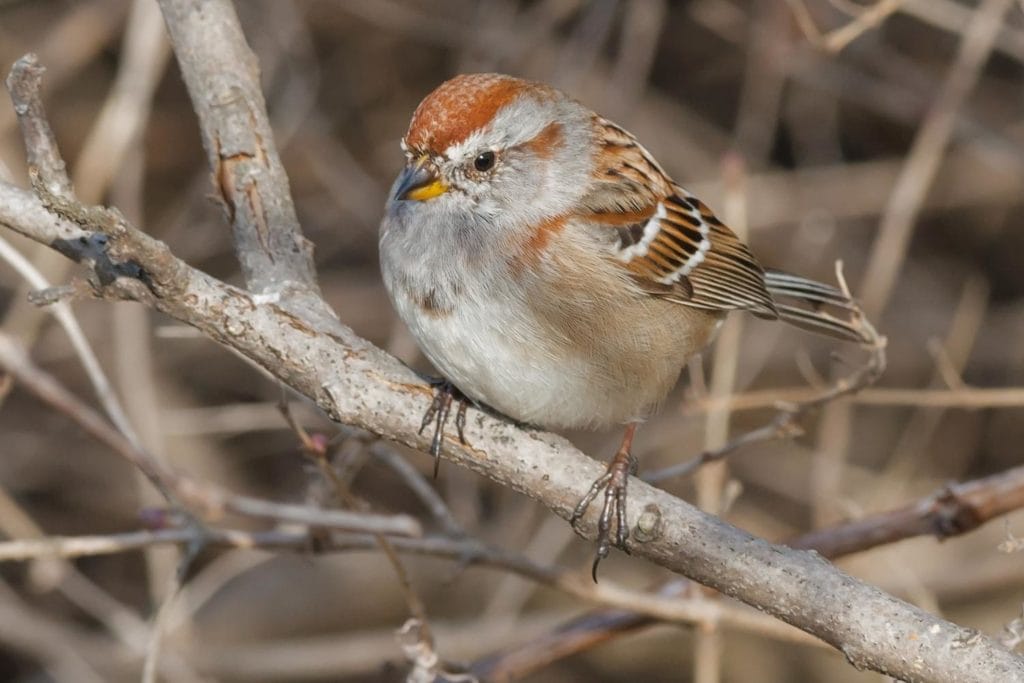
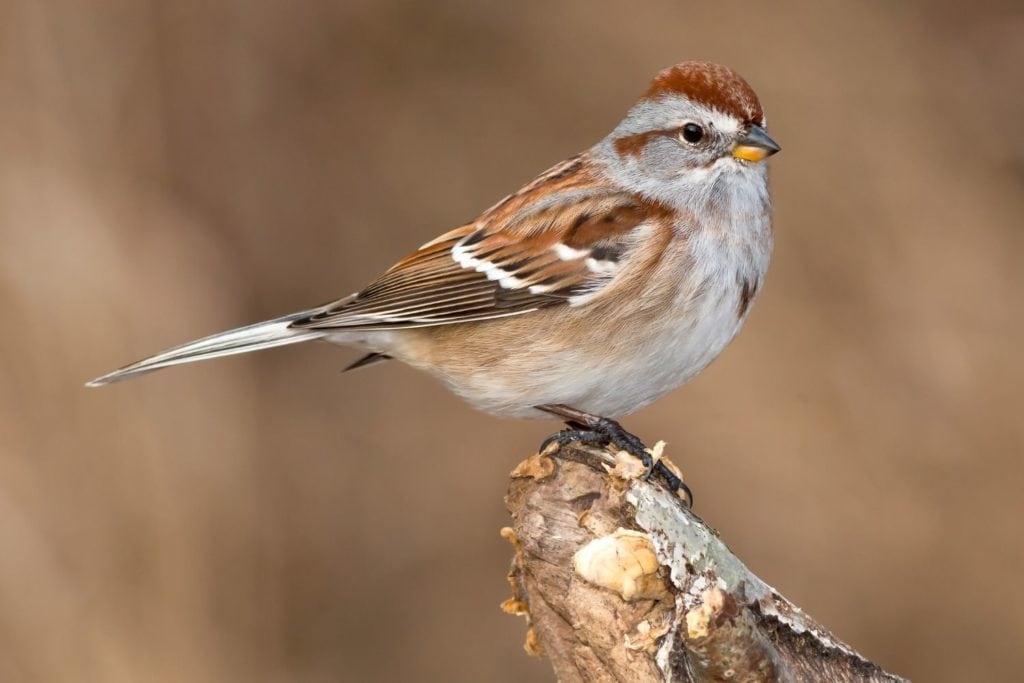
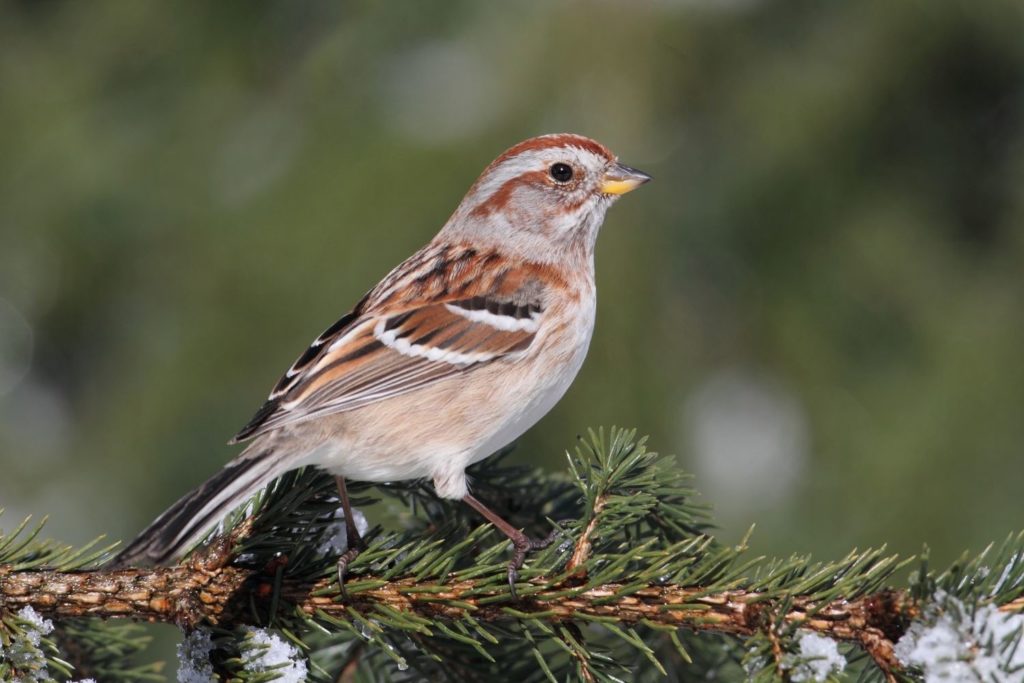
Classification:
Family: Passerellidae
Genus: Spizelloides
Description: The American Tree Sparrow is a small bird that has a gray underside. There is a black spot on the chest. The head is also gray, but there is a brown cap at the top. There are also chestnut colored stripes near both eyes. The wings are brown, but have two white stripes. The beak is small, and the tail is slightly notched.
Diet: They are omnivorous and eat things like berries, seeds, and insects.
Habitat: American Tree Sparrows can be found as far as northern Canada in the tundra. They can also be found throughout much of the United States.
You will usually find these birds at the tree line near open areas. They prefer trees that are birch, willow, alder, or spruce. You may also spot them near lakes, bogs, gardens, marshes, and fields.
Lifespan: Up to 10 years
Interesting Facts about American Tree Sparrow:
- These birds help farmers by removing the seeds of weeds from their fields
- The American Tree Sparrow migrates at night
- There is no correlation between where these sparrows breed and where they spend the winter months
You may also like: Learn the 10 Species of Birds That Live in Desert: Complete with Images, Facts, and More!
Owls

Owls, or Strigiformes, are an order of birds with about 200 different species. They have sharp and hooked bills. Their eyes are very large and face forward in their heads. The heads are also large and are round or shaped like a heart. Their necks are very flexible, and they have incredibly sharp talons.
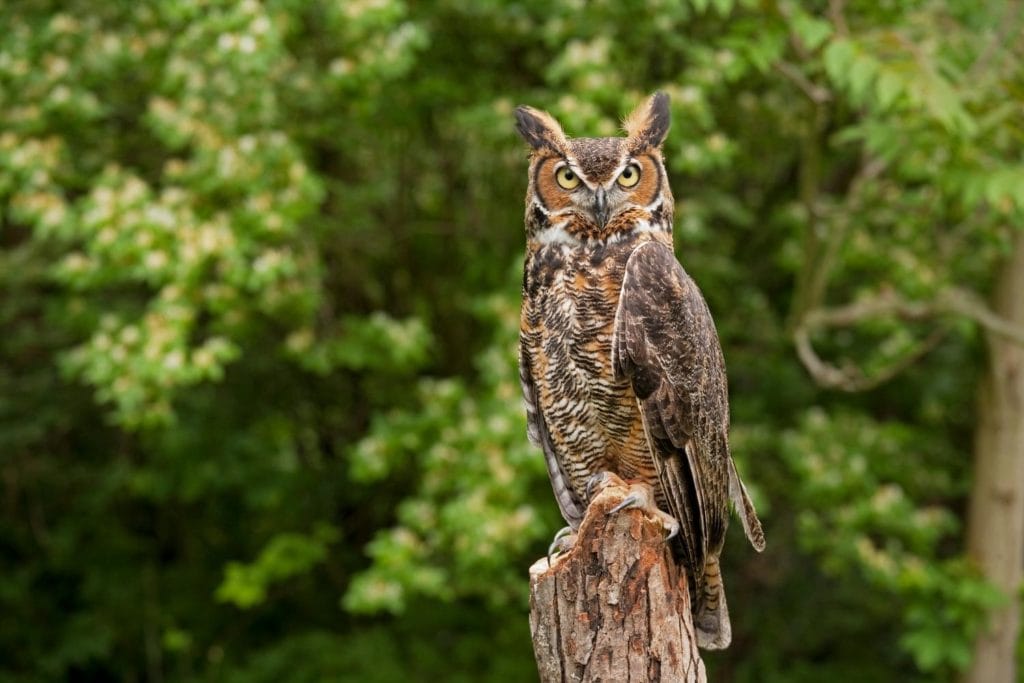
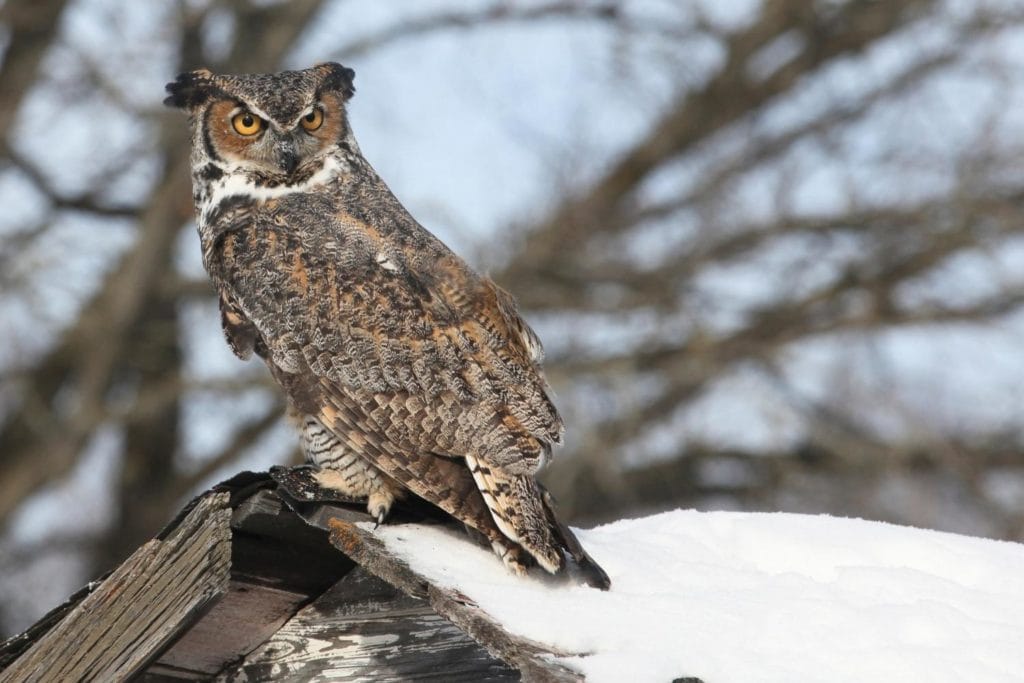

Classification:
Family: Strigidae
Genus: Bubo
Description: Great Horned Owls are named for the large tufts of feathers on the top of their heads. These tufts of feathers, of course, look like horns. The eyes of these owls are very large. The feathers are a combination of brown, gray, and white that helps it blend in with the surrounding tree bark. The wingspan is over four feet.
Diet: These owls are nocturnal and will hunt at night. They are carnivorous and will eat mice, rabbits, squirrels, skunks, ducks, and quail. They eat by tearing the meat into small chunks and swallowing them. It eats everything, including the bones, and then will regurgitate the undigested pieces into pellets.
Habitat: Great Horned Owls can be found throughout most of Canada, the United States, and Mexico. It is also found throughout much of South America.
They can be found in a variety of places, but are most often found in woodlands and open fields. You may also spot them in deserts, grasslands, swamps, mangroves, marshes, and around human settlements.
Lifespan: About 13 years
Interesting Facts about Great Horned Owls:
- Great Horned Owls can fly at speeds up to 40 mph/64 kmh
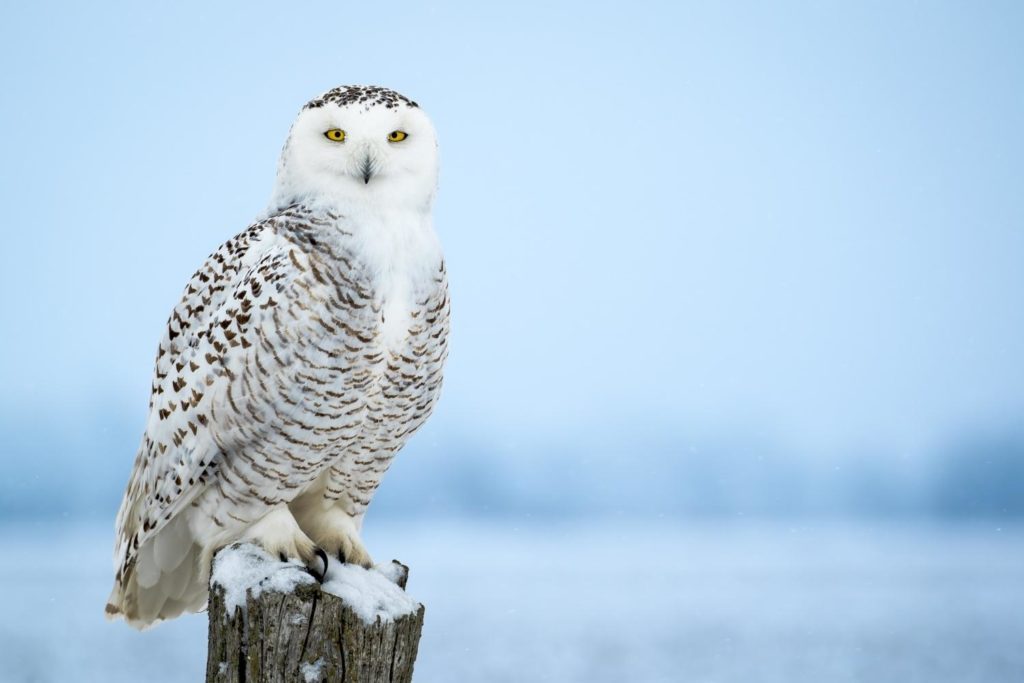
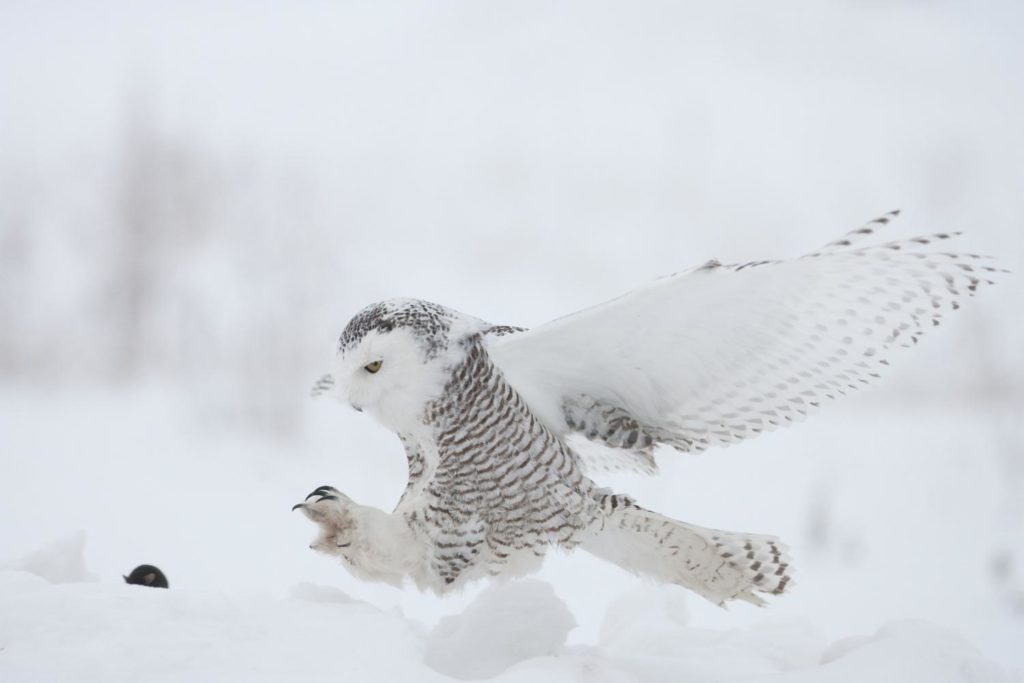
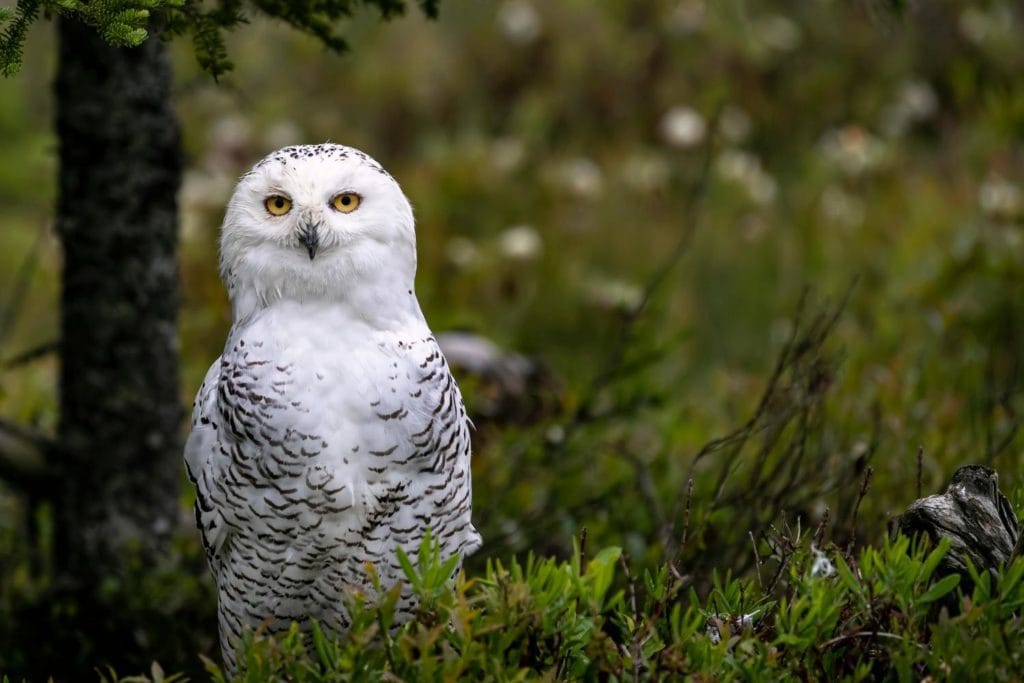
Classification:
Family: Strigidae
Genus: Bubo
Description: Snowy Owls are the largest species of bird found in the arctic. The average wingspan is 66.9 inches/170 centimeters. Their feathers are mostly white, but they also have brown spots and bars intermittently throughout their feathers.
Habitat: These owls can be found breeding throughout Alaska, Canada, Greenland, Scandinavia, Russia, Novaya Zemlya, and Siberia. In the winter, they are found throughout Canada and the northern United States. They can occasionally be found further south in the United States, Iceland, the British Isles, northern Europe, and northern China.
They prefer living in open tundra at sea level up to 984 feet/300 meters above sea level. You may also spot them in salt grass meadows.
Lifespan: Up to 28 years
Interesting Facts about Snowy Owls:
- Snowy Owl’s feet are covered with dense and fluffy feathers that aid in insulation against the snow
- They don’t like to perch in trees, instead choosing to perch on the ground
- Unlike most owls, they are not nocturnal, but are most active during dawn and dusk

Classification:
Family: Strigidae
Genus: Micrathene
Description: Elf Owls are incredibly tiny, and are the smallest owls in the world. They only grow up to 4.8-5.6 inches/12.4-14.2 centimeters in length. The tails of these owls are very short, and they have white feathers above their eyes that make them look like they have eyebrows. They also have a couple of rows of white spots on each wing. The backs are brown with mottling.
Diet: These owls are mainly insectivores, feasting on crickets, moths, and beetles. However, they have also been known to eat lizards, blind snakes, and kangaroo rats.
Habitat: Elf Owls can be found in the upland deserts of Arizona and Sonora, Mexico. They can also be spotted in parts of California, Texas, and New Mexico.
They most commonly are found in upland deserts, but they may also be found in subtropical thorn woodlands, evergreen woodlands, and canyon riparian forests.
Lifespan: About 5 years
Interesting Facts about Elf Owls:
- Elf Owls sometimes form symbiotic relationships with the blind snakes they’re meant to eat. They will bring the snakes to the nest as food for their young. Sometimes, the snakes escape, but remain near the nest. They eat the bugs around the nest that compete with the hatchlings for food.
- These owls do most of their travel through walking, hopping, and climbing
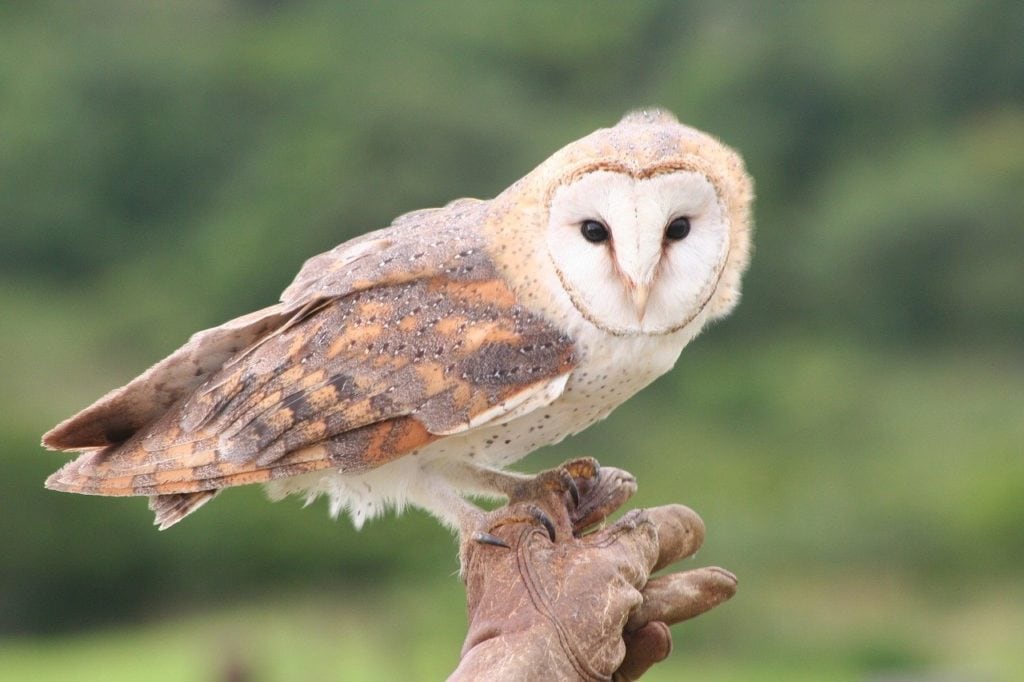
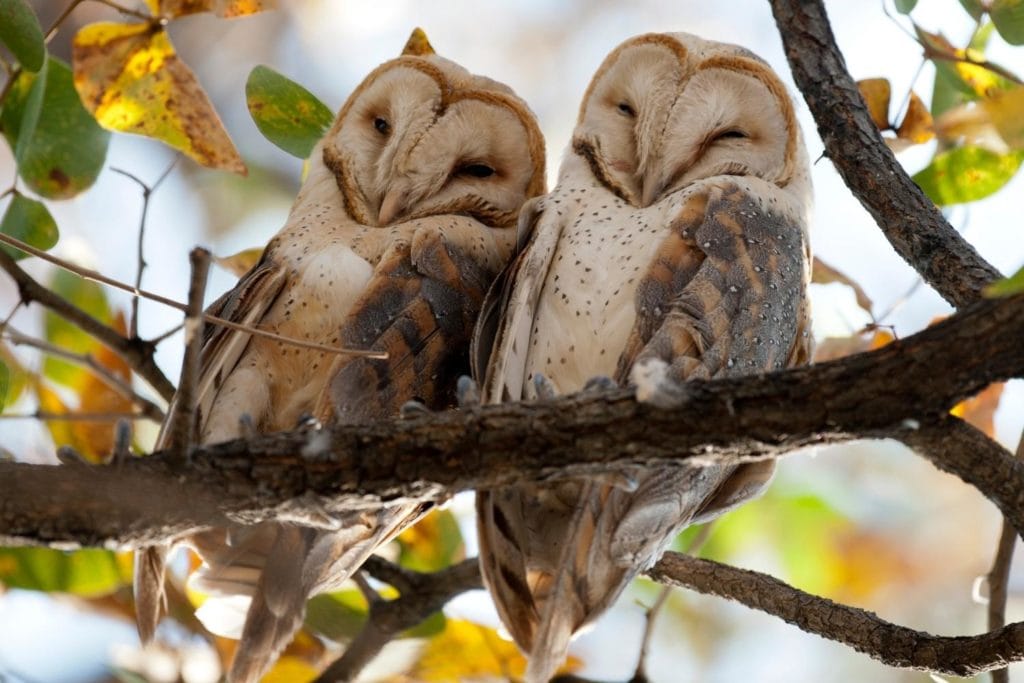
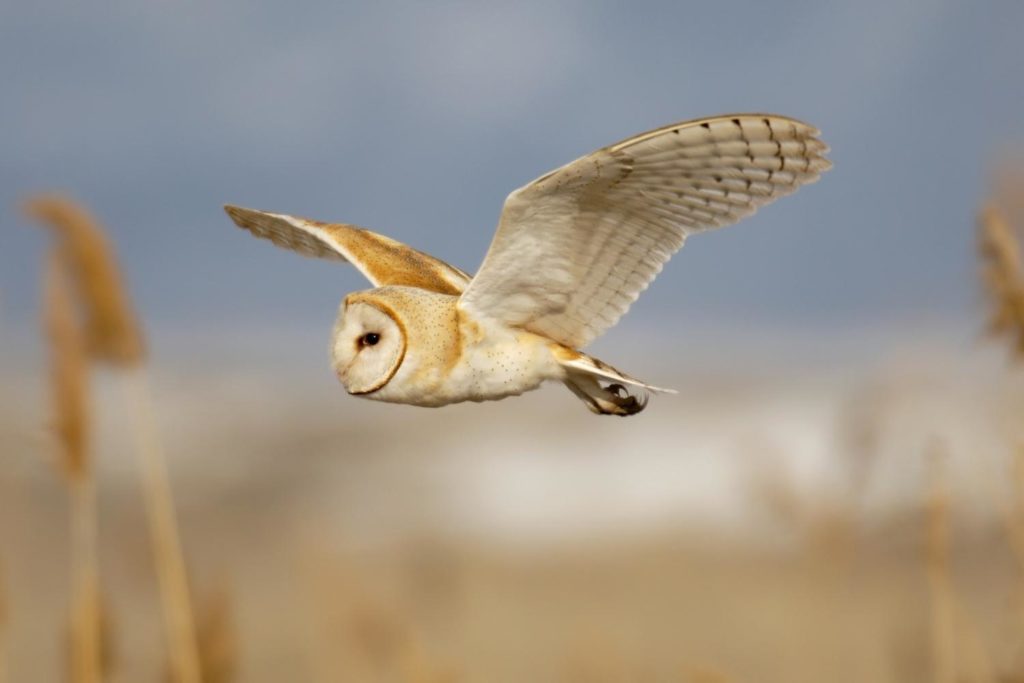
Classification:
Family: Tytonidae
Genus: Tyto
Description: Barn Owls are a pretty golden brown on their backs and wings. The belly is a grayish white. There are light brown speckles throughout the feathers on both the back and belly. The wingspan of these owls is about 4 feet/1.2 meters, and the face is in the shape of a heart.
Diet: These owls are carnivorous and will eat mice, voles, shrew, rats, and birds.
Habitat: Barns Owls are found throughout most of the United States, Mexico, and South America. It can also be found across Europe, Australia, Asia, and Africa.
They prefer areas of low elevation with lots of open space. They are commonly found in grasslands, marshes, deserts, and fields.
Lifespan: These owls generally have a short lifespan, usually not living more than 2 years. However, the oldest recorded wild Barn Owl was 34 years old.
Interesting Facts about Barn Owls:
- Barn Owls are often seen as an omen of death because they are commonly found living in graveyards
- The heart-shape of their face helps them hear sounds better
- Barn Owls mate for life
- Most captive-raised Barn Owls live about 20 years
You may also like: Learn the 7 Owls You can Find in Florida: Complete with Images, Facts, and More!
Raptors
Raptors are part of the order Falconiformes, and there are over 400 species of birds in the order. Types of birds include falcons, hawks, eagles, and ospreys. Raptors have hooked bills, eight incredibly sharp talons, and keen eyesight. They are carnivorous and hunt or scavenge for their food.
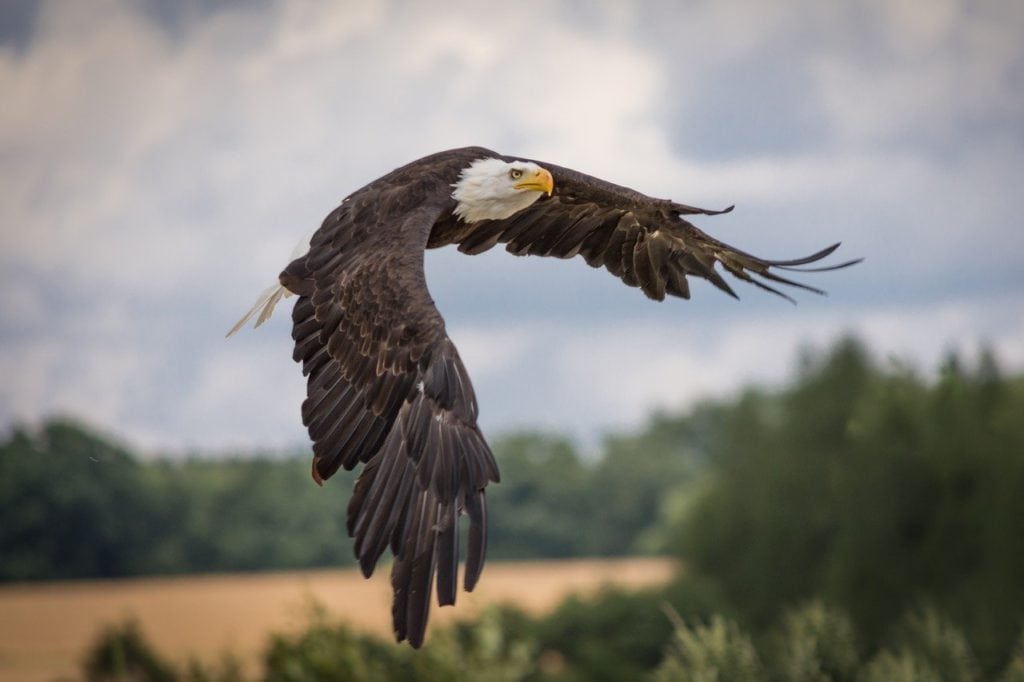
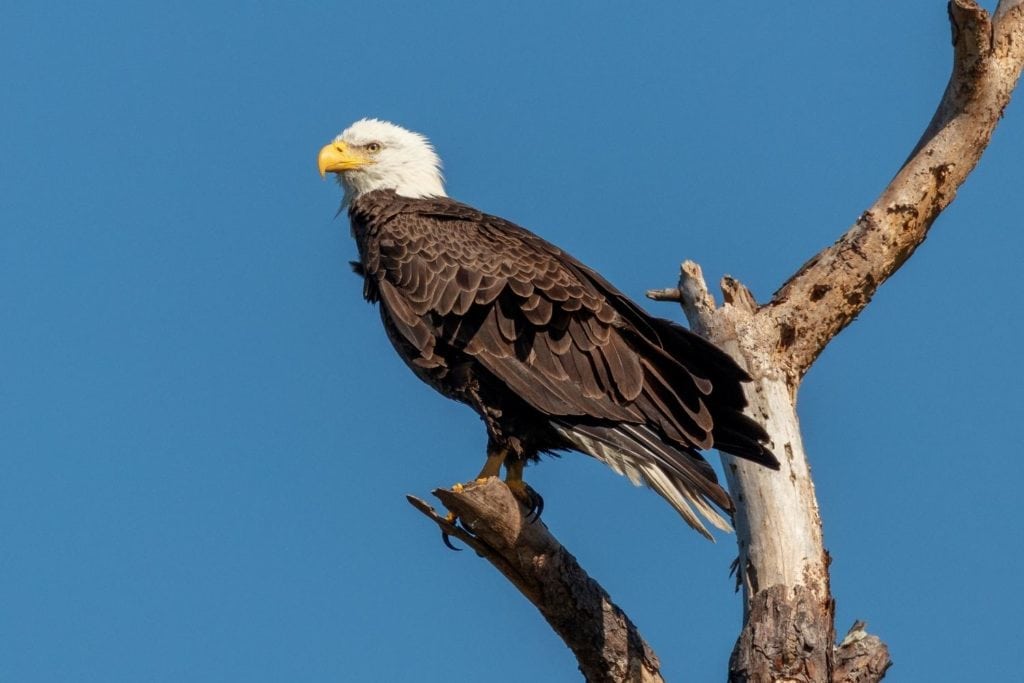

Classification:
Family: Accipitridae
Genus: Haliaeetus
Description: Bald Eagle’s are very large raptors with wingspans of 6-7 feet/1.8-2.1 meters. The bodies are dark brown, but the head and tail are snow white. The eyes are a very bright yellow. The beak is hooked, and the feet and talons are incredibly powerful.
Diet: Their diet consists mostly of fish, but they have also been known to eat smaller birds, small mammals, and carrion. They have even been known to steal food from other birds.
Habitat: Bald eagles can be found throughout Alaska, most of Canada, and most of the United States. It can also be found in some parts of Mexico, and across Newfoundland.
They prefer to live near large bodies of water like rivers, sea coasts, estuaries, and lakes. Their specific habitat usually depends on the availability of prey, but they are commonly found near tall trees in areas undisturbed by humans.
Lifespan: About 15 years
Interesting Facts about Bald Eagle:
- Juvenile Bald Eagles don’t develop their white head until about 5 years of age
- The vision of these eagles is 4-5 times better than a human. It also had a 340-degree view
- The Bald Eagle is the national bird of the United States

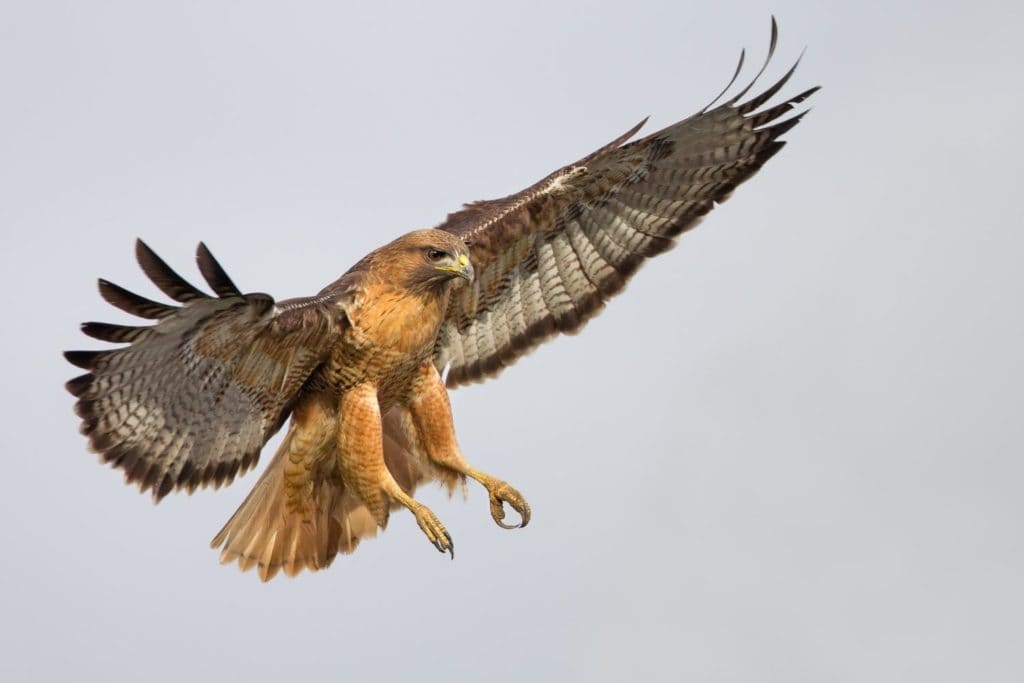
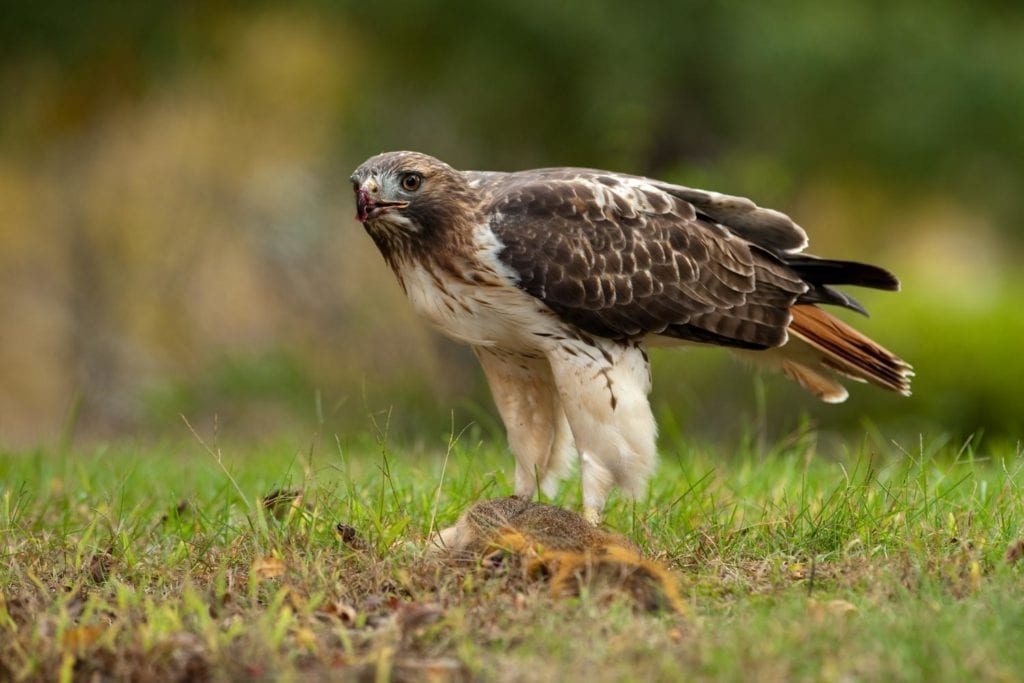
Classification:
Family: Accipitridae
Genus: Buteo
Description: Red-Tailed Hawks are larger birds with a wingspan of about 4 feet/1.2 meters, but they only weigh 2-4 pounds/907-1814 grams. Their feathers are dark brown on their wings and back, but a lighter cream color on their underside. They are, of course, called Red-Tailed Hawks because of their deep red colored tail.
Diet: They are carnivorous and eat mostly small rodents. They may also eat reptiles, birds, and fish.
Habitat: The Red-Tailed Hawk can be found across most parts of Canada, the United States, Mexico, and Central America.
These hawk species prefer to live in deciduous forests with open areas, as well as swamps, tundras, deserts, grasslands, and fields. They will choose tall trees or areas where they can sit up high and look for food.
Lifespan: Up to 22 years in the wild
Interesting Facts about Red-Tailed Hawk:
- They will pounce on prey to catch them, and then will begin to eat before the animal has died
- When Red-Tailed Hawks find a mate, they will stay together for years in the same territory

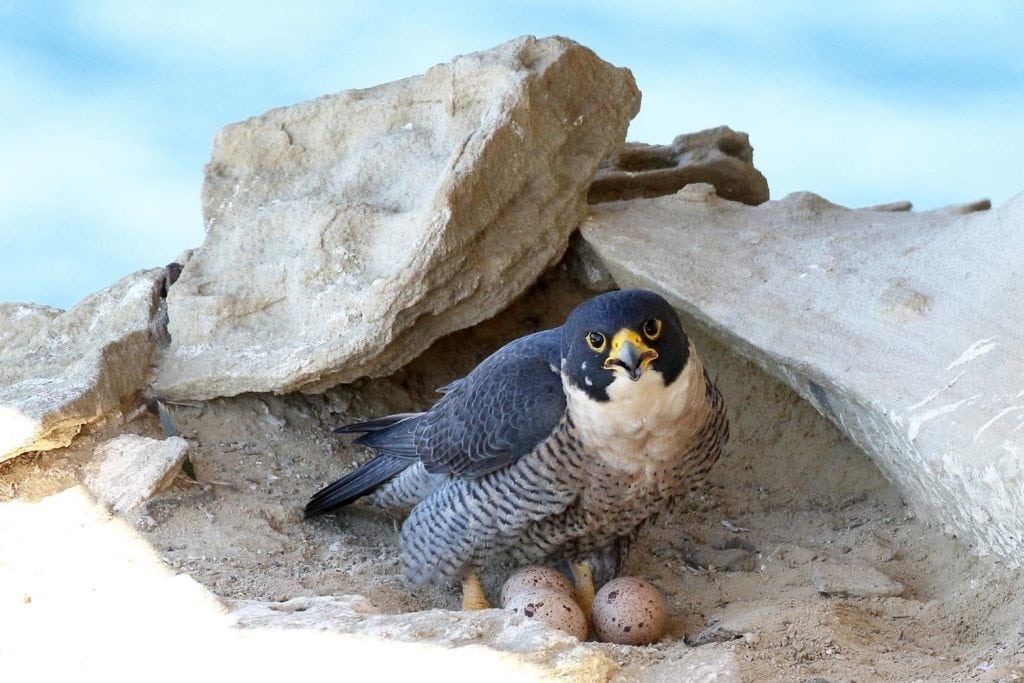

Classification:
Family: Falconidae
Genus: Falco
Description: Peregrine Falcons are a medium sized bird, around the size of a crow. The wingspan is about 3 feet/0.9 meters long. The wings of these types of falcons are gray, and the shape of the wings are long and pointed. The backs are dark brown, and there are dark bars across the underside and the tail.
Diet: These birds are carnivorous. Unlike most other raptors who eat rodents, the Peregrine Falcon dines solely on smaller birds. Birds that they eat include doves, pigeons, grouse, shorebirds, waterfowl, and songbirds.
They will hunt from the air, or from sitting somewhere high above the ground.
Habitat: Peregrine Falcons can be found on almost every continent, except Antarctica. In North America, you can find these birds along the western portions of Canada and the United States. They are also found at the northern points of Canada, along the east coast of the United States, and all the way down through Mexico.
They prefer to live in areas that are rocky and open. They will find cliffs to build their nests, so they are often found along the coasts of oceans, rivers, and on the sides of mountains. They usually choose rocky areas along grasslands, meadows, or tundras.
You may sometimes see it in urban areas as well where it will build its nests along high rises.
Lifespan: About 13 years
Interesting Facts about Peregrine Falcon:
- Peregrine Falcons can reach speeds of up to 242 mph/389 kmh when diving for prey
- They are the fastest animal on earth
- Peregrine Falcons are one of the most popular birds used by falconers
- Their nests are called “scrapes”
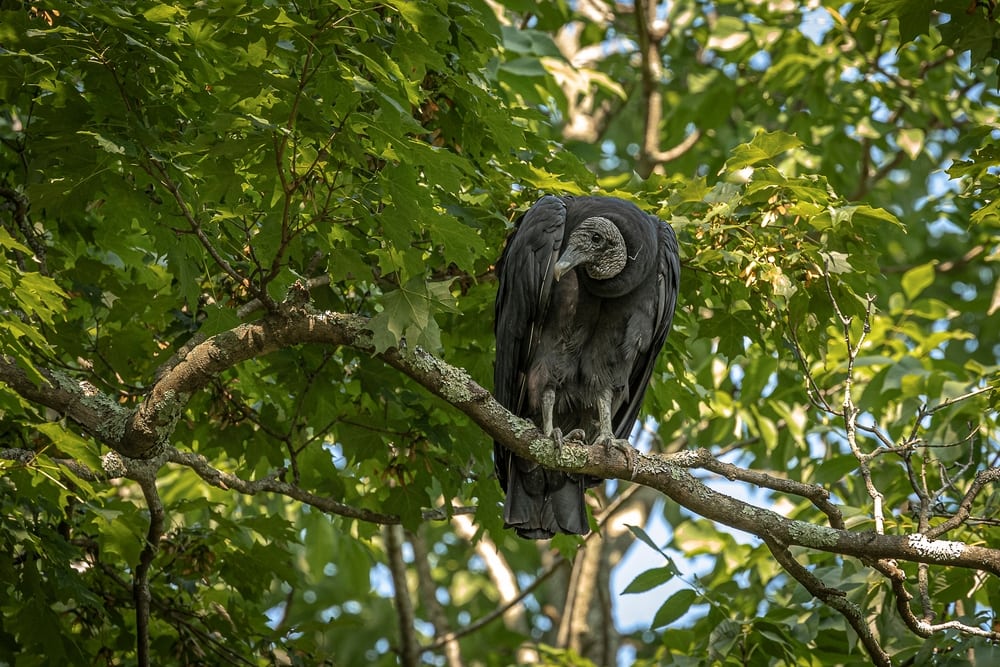
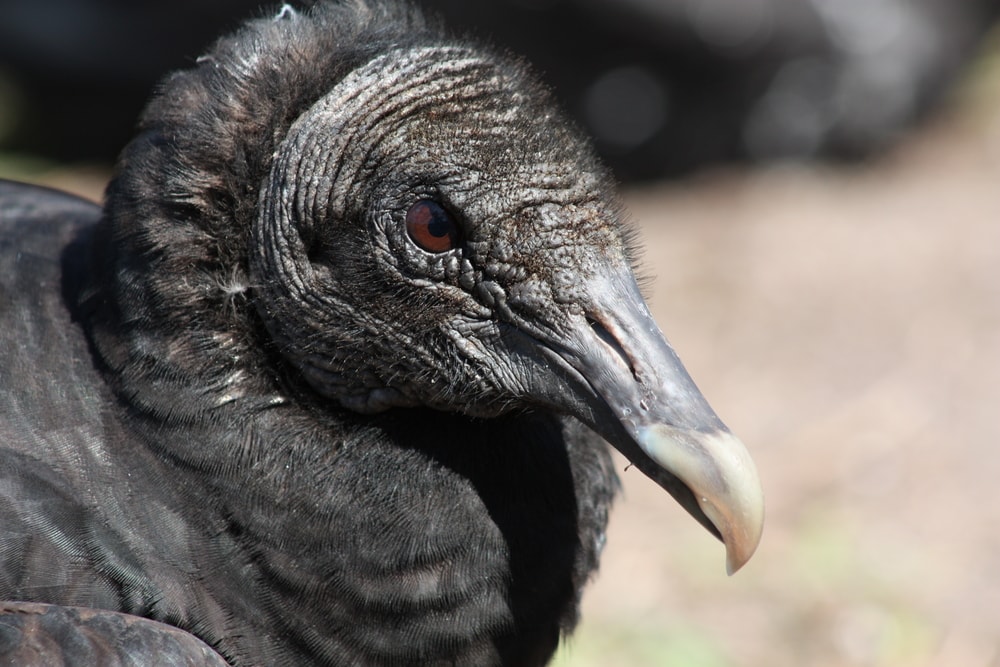
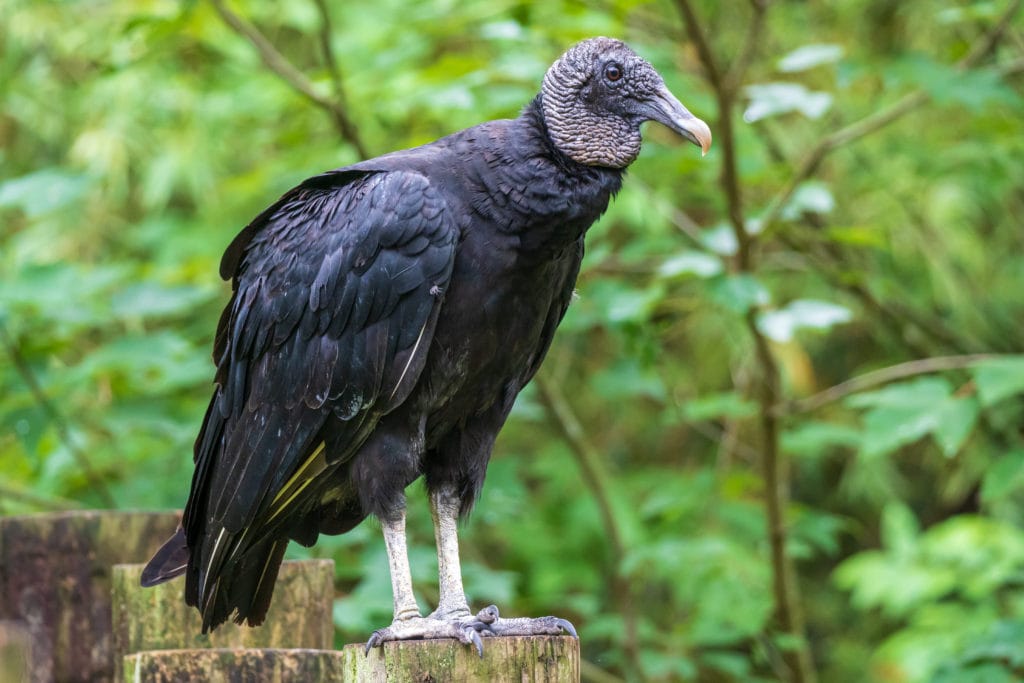
Classification:
Family: Cathartidae
Genus: Coragyps
Description: Black Vultures are large birds with a wingspan of about 54-59 inches/137-149 centimeters in length. The body is completely black, even the head, which is bald. The head is simply covered in grayish-black skin. The tail is also black, and is very short. The wings are broad and round, and there is some white underneath the wings.
Unlike most raptors, the beaks and feet of these birds are very weak. That’s because they don’t hunt for their food. Instead, they scavenge.
Diet: They are carnivorous scavengers and will feed on carrion. They hunt for food in groups, using their keen eyesight to find their next meal.
Habitat: Black Vultures are found in the southeastern portion of the United States as well as all of Mexico, Central America, and South America. They usually are found in states below Pennsylvania, but can sometimes be found as far north as Maine.
They prefer open areas and avoid forests. They can be found in lowlands like fields and deserts. They will hide out in trees or on fences, when not looking for food in the air.
Lifespan: Up to 25 years
Interesting Facts about Black Vulture:
- A Black Vultures bald head prevents dead meat from getting stuck in their feathers
- Black Vultures are very important to the ecosystem because they prevent the spread of disease
Parrots
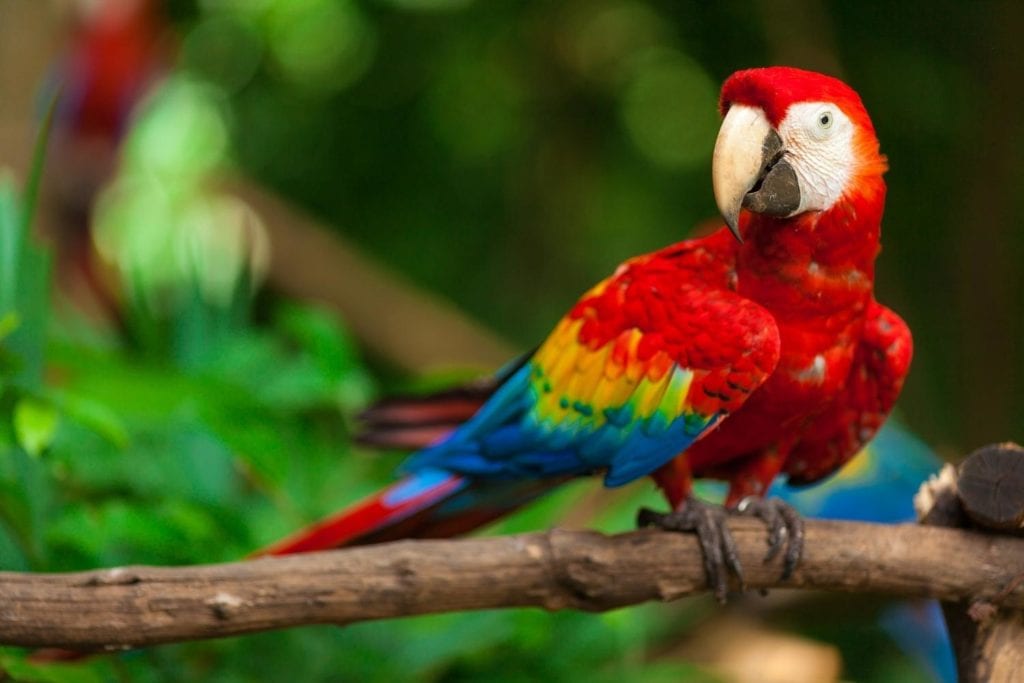
Parrots, or Psittaciformes, are an order with over 350 bird species. To be considered a parrot, a bird must have a curved beak. It must also have four toes, with two pointing forward and two facing backwards.

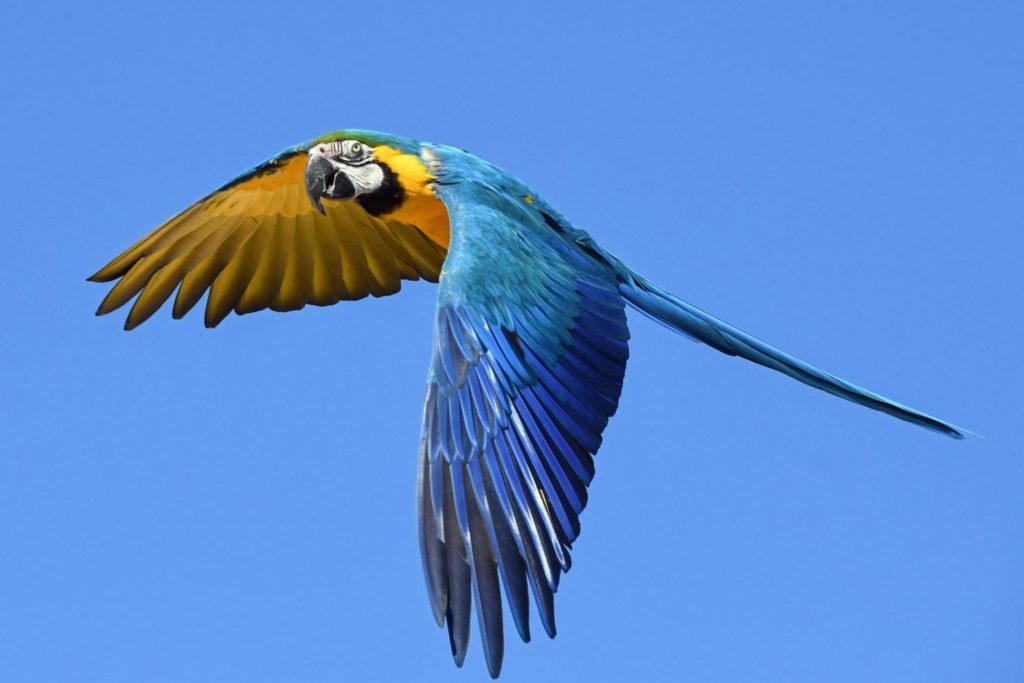
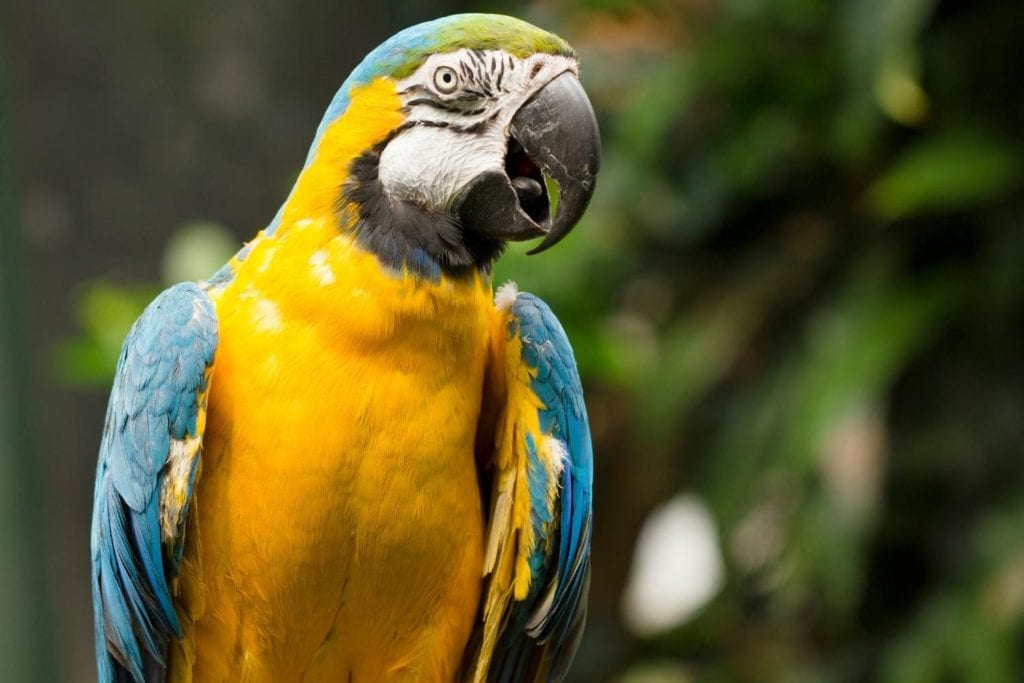
Classification:
Family: Psittacidae
Genus: Ara
Description: Blue and Yellow Macaws are very large parrots that have a wingspan of about 40.9-44.8 inches/104-114 centimeters. They get their name because they have very vibrant colors. The blue is found on their backs and wings, but their bellies are yellow, and their foreheads and tips of their wings are green.
Diet: They are herbivores who mainly feed on seeds, fruit, and nuts. Their beaks are very large and are able to easily break open the shells of nuts.
Habitat: Blue and Yellow Macaws can be found in South America from Venezuela, Brazil, Bolivia, Columbia, Paraguay, and the locations in between. They can also be found in Mexico, Panama, and Central America.
These types of macaws prefer areas that are subtropical and tropical forests, savannas, and woodlands. They like rainforests that are in riparian or swampy areas. You will find them hiding high up in trees, avoiding predation.
Lifespan: Up to 50 years
Interesting Facts about Blue and Yellow Macaw:
- Blue and Yellow Macaws are frequently predated by larger birds like the Harpy Eagle, Hawk-Eagle, and Orange-breasted Falcon
- They are one of the most popular birds kept as pets, although people sometimes don’t understand what they’re getting into with their large size and loud calling sounds
- Blue and Yellow Macaws are social and will usually be found in pairs, flying so close together that their wings almost touch
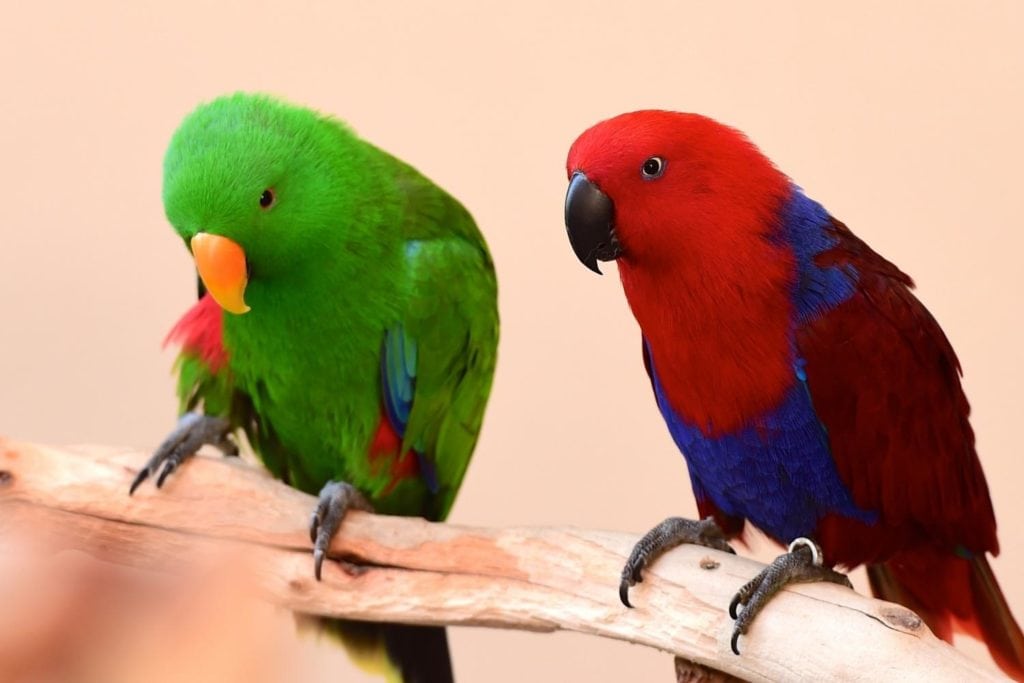
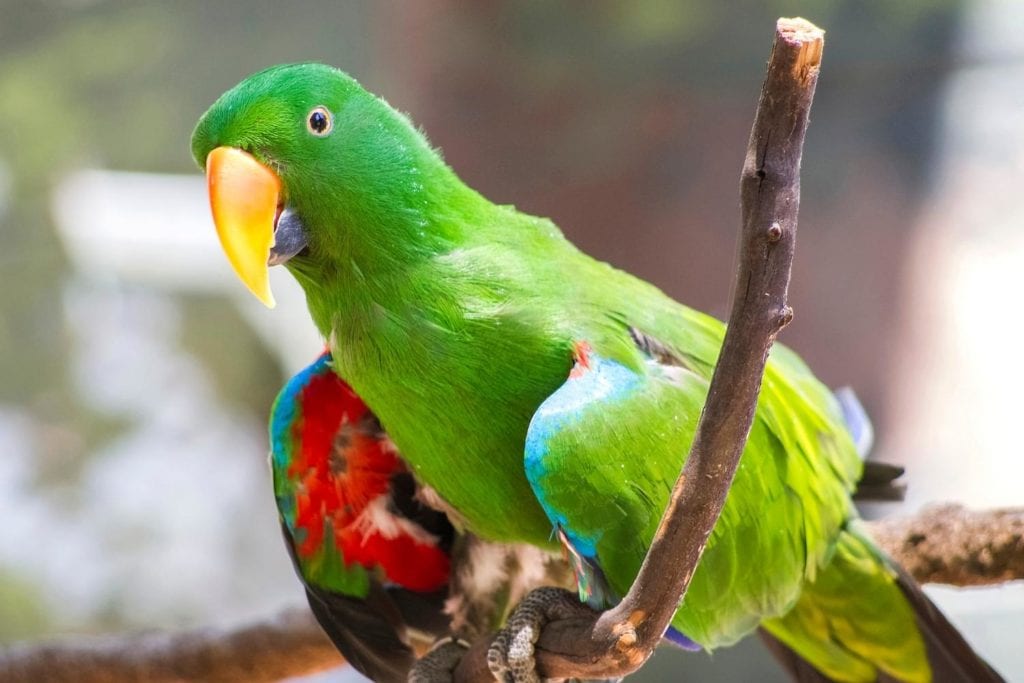
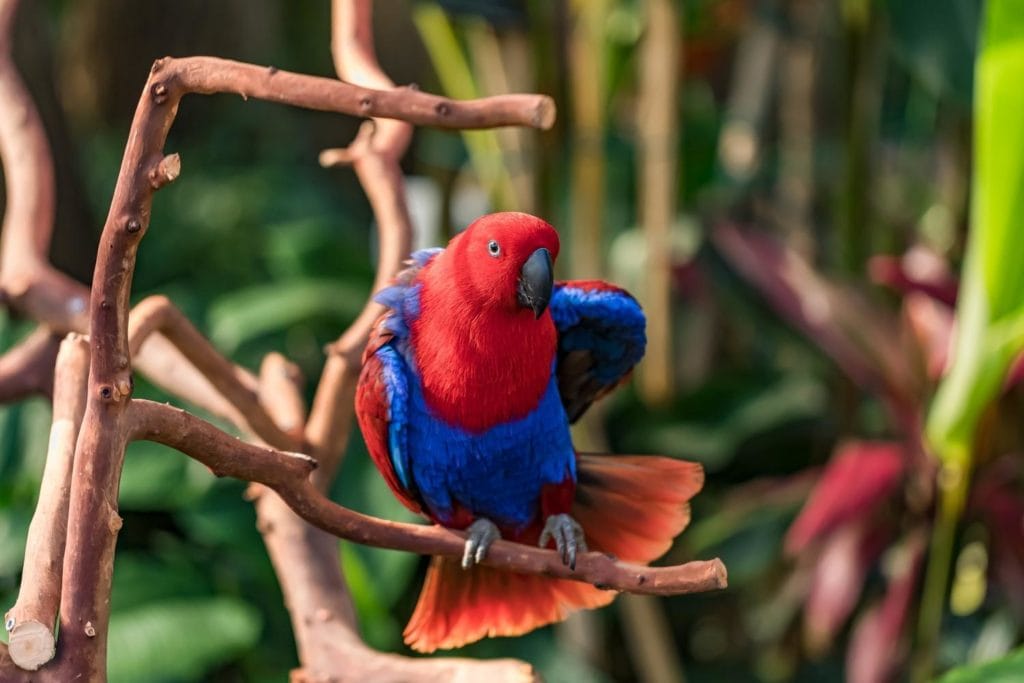
Classification:
Family: Psittacidae
Genus: Eclectus
Description: Eclectus Parrots look different depending on whether the birds are male or female. Unlike most bird species where the male has brighter colors, both the male and female are very colorful.
The males are mostly green, but their crown is yellow, and they have blue feathers mixed throughout the green. The wings have red feathers, but the tail is a mix of greens, blues, and yellows.
The female’s bodies are almost entirely red. Their wings are a darker red than the body, and the underside of her body is a dark purple. The underside of the wings is also a dark purple.
Habitat: Eclectus Parrots can be found in Papua New Guinea and Indonesia. They can also be found in Australia, Palau, Singapore, and the Goram Islands.
They prefer to live in forests that are densely packed in trees. They choose forests that are close to coastal areas or other bodies of water. They are found in tropical regions where there are many tall trees for them to nest and high from predators.
Lifespan: Up to 50 years
Interesting Facts about Eclectus Parrot:
- Because of their different colors, researchers believed males and females were different species until the 20th century
- Females are not afraid to defend their nests and will die to protect it, if necessary
- They cannot begin mimicking speech until at least one year of age
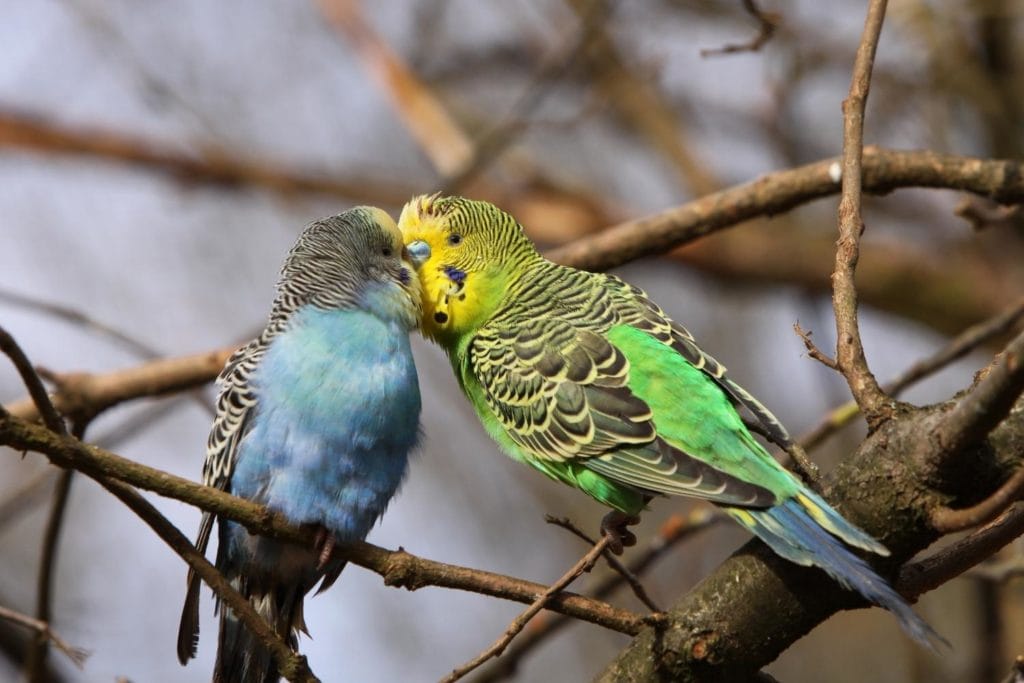
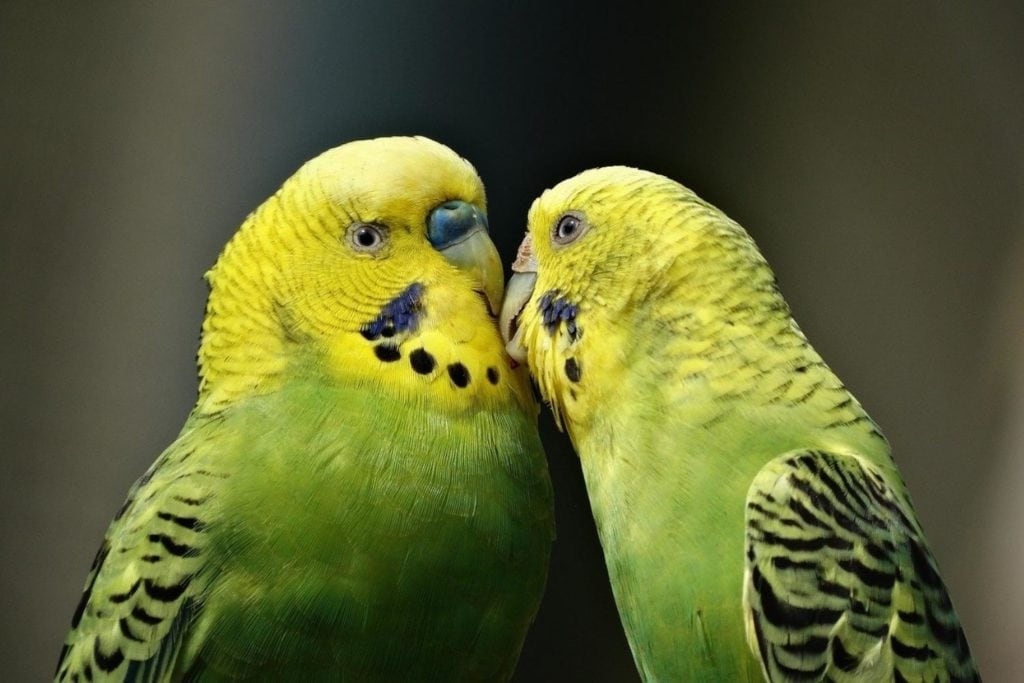
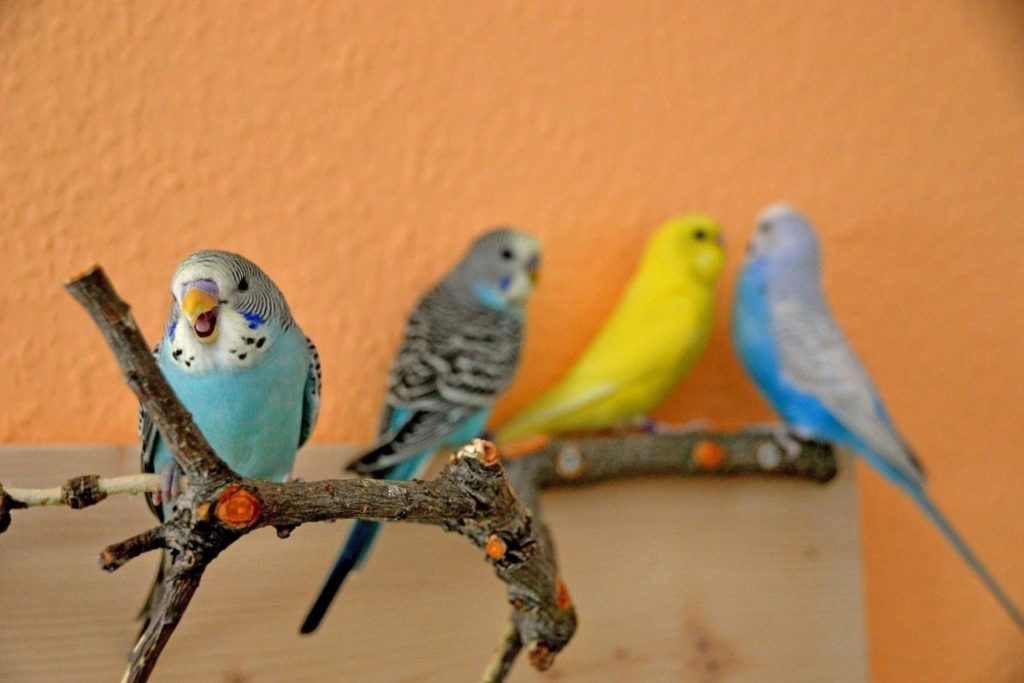
Classification:
Family: Psittacidae
Genus: Melopsittacus
Description: Budgerigars are very small parrots that only reach about 7-7.8 inches/18-20 centimeters in length. Their tails and wings are both very pointed, and they have incredibly colorful patterns.
In captivity, these birds come in all different colors. Most wild birds have yellow heads, and a yellow-green body. They also have black and white markings throughout their feathers.
Males and females can also be distinguished from one another. In mature animals, the cere above the nose is blue on males. The female’s cere is light brown.
Diet: They are herbivores who eat mostly seeds. They will scavenge on the ground for food, and drink about 5.5% of their body weight in water.
Habitat: Budgerigars can be found throughout Australia. It has also been introduced to South Africa, Japan, Puerto Roco, Switzerland, New Zealand, and the United States.
They prefer climates that are semi-arid or sub-humid. This describes most of the habitat in central Australia. They are also sometimes found in the grasslands of the southeastern side of the continent.
Lifespan: Up to 21 years
Interesting Facts about Budgerigar:
- They are very social birds and can be found in large flocks
- Budgerigars are the most widely kept pet in the world besides cats and dogs
- Researchers know more about their biology than any other parrot
- The name “Budgerigar” means “good to eat” in the Australian Aborigine dialect
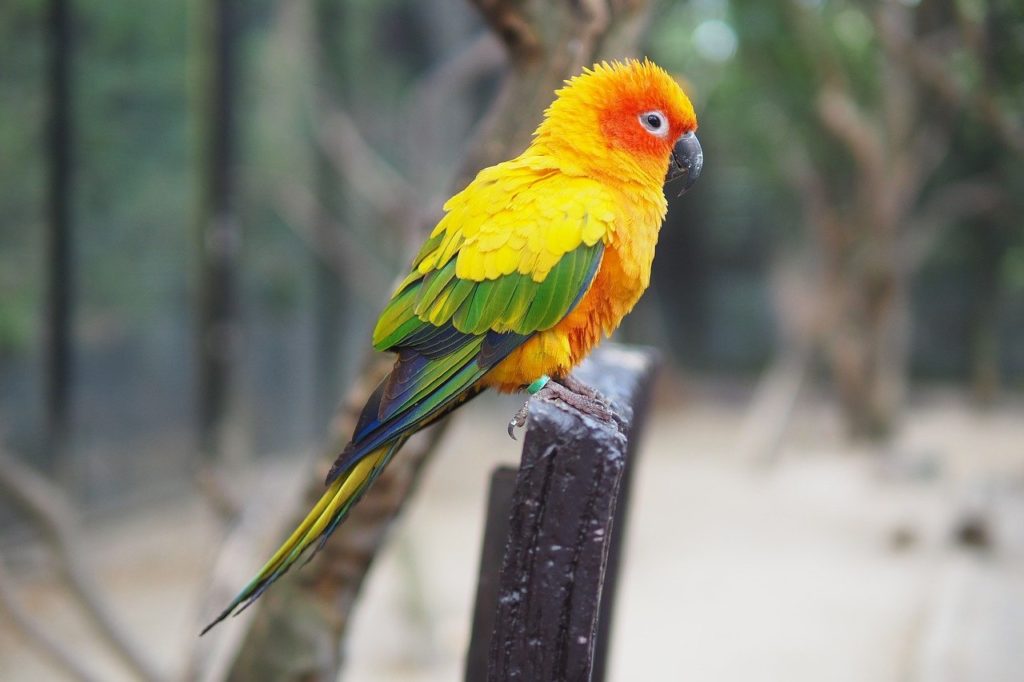

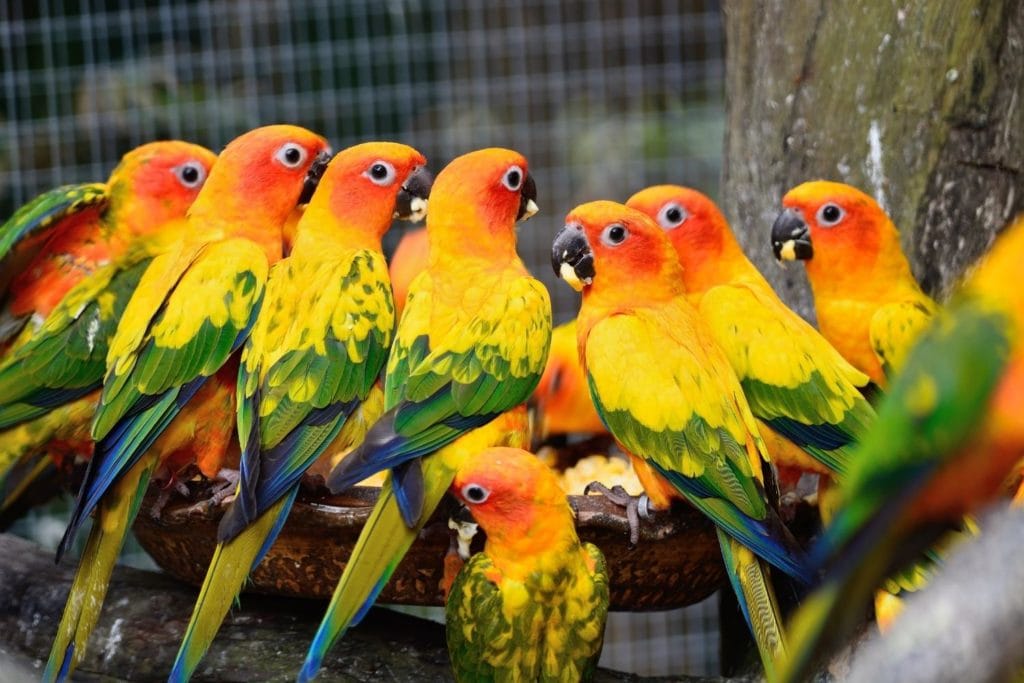
Classification:
Family: Psittacidae
Genus: Aratinga
Description: Sun Conures are incredibly beautiful parrots with a wingspan of 5.5-6.3 inches/14-16 centimeters. They are a bright yellow color with red markings on the head. There are light orange markings on the top of the forehead, the belly, rump, and back. They also have some green in their tails, and the wings are primarily green and blue.
Diet: They are herbivores who eat the seeds of fruit and berries, nuts, blossoms, and occasionally insects.
Habitat: Sun Conures can be found throughout most of South America. It is found mostly north of the Amazon River in Brazil.
They are only found in tropical habitats, and like to live in open areas like savannahs. They can sometimes be found in forested valleys, woodlands in dry savannah, or coastal forests.
They will seek out areas where fruit is actively growing, such as in palm groves. They live in areas that are mostly undeveloped and avoid human settlements.
Lifespan: Up to 30 years
Interesting Facts about Sun Conures:
- They generally live in pairs or in small flocks of up to 15 birds
- Sun Conures are very quiet while they eat, but extremely loud when they fly
- Sun Conures are popular pets, but they need a lot of mental stimulation. They bond well with owners and can be taught simple tricks, but without enough stimulation, they can get moody and bitey.
You may also like: Learn the Different Animals Living in the Amazon Rainforest: With Images, Facts, and More!
Waterfowl
Waterfowl, or the order Anseriformes, make up over 160 species of birds. To be considered a waterfowl, a bird must have a broad and flattened bill. They have short, but sturdy legs with webbed feet that can be used for walking or swimming.
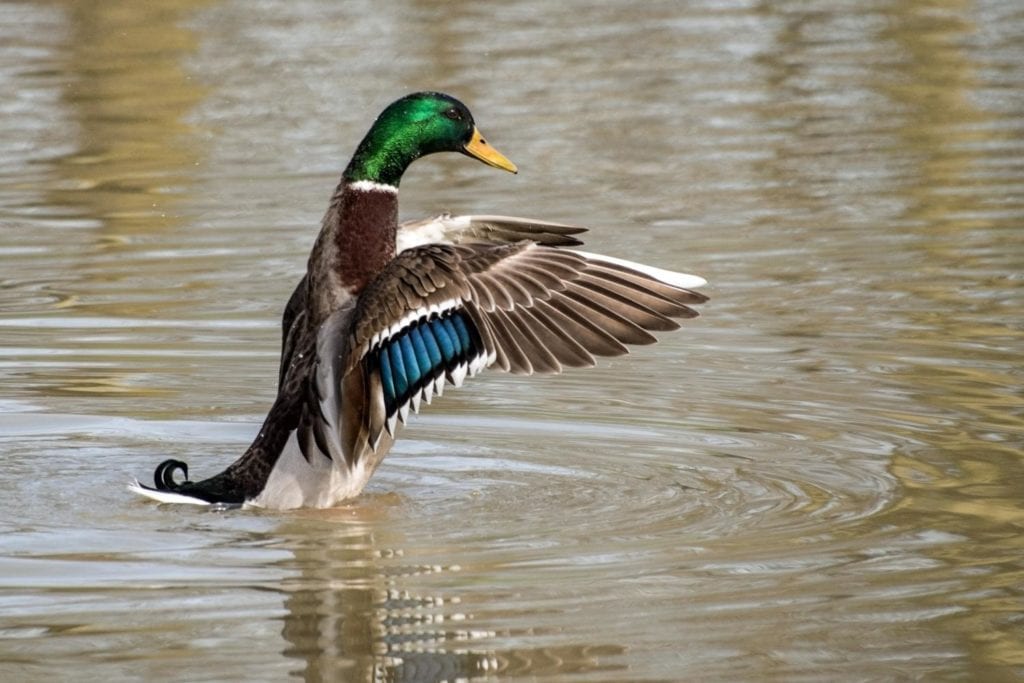
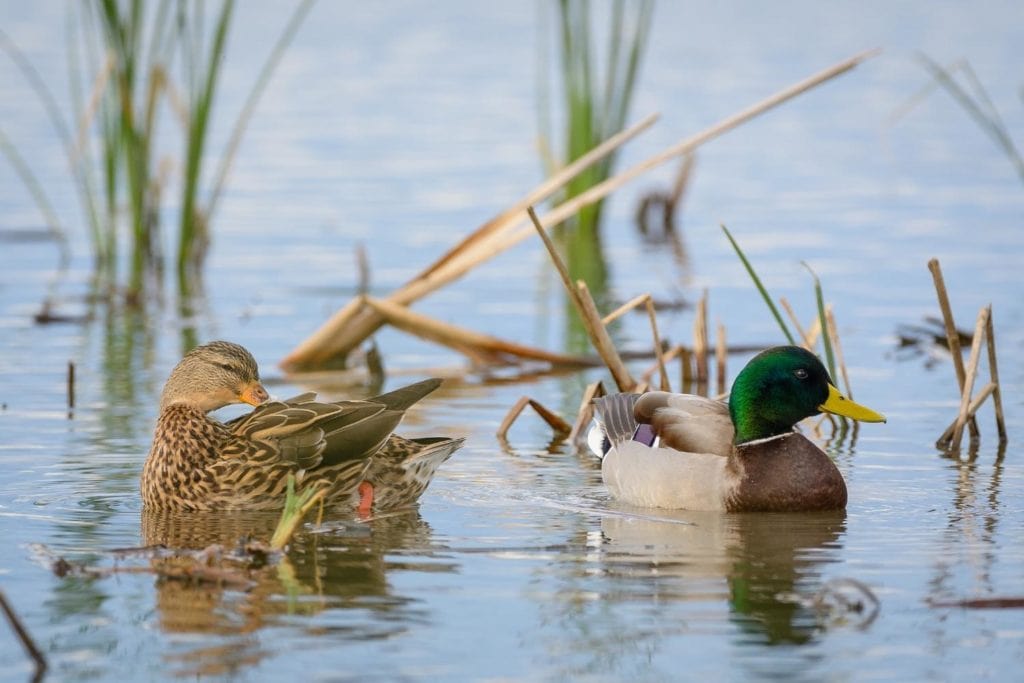
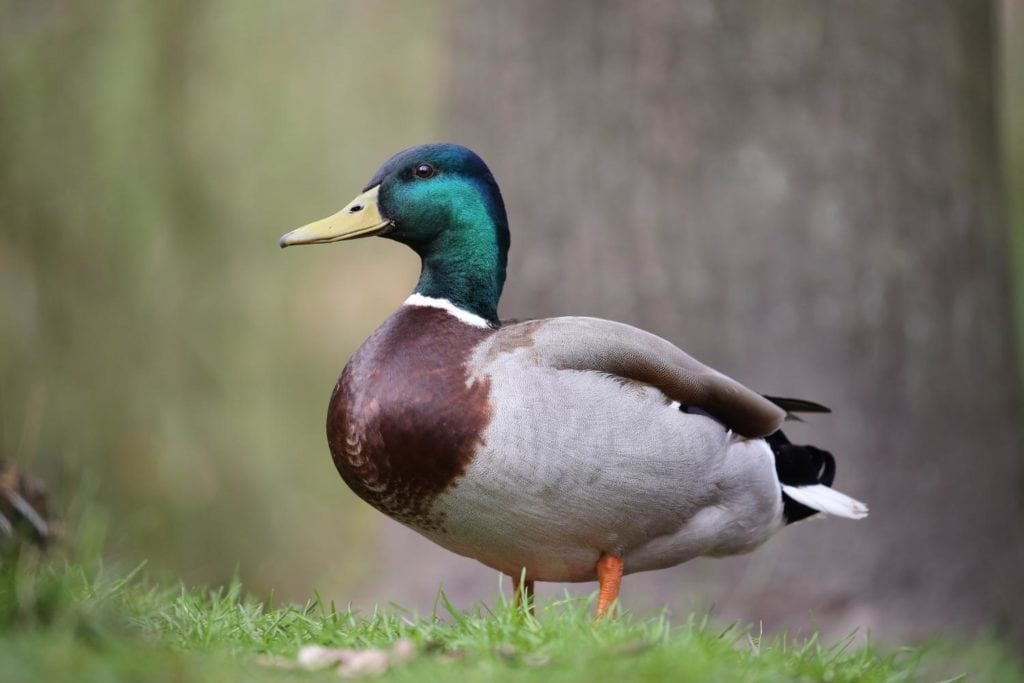
Classification:
Family: Anatidae
Genus: Anas
Description: Mallard Ducks have a wingspan of about 3 feet/0.9 meters. You will notice a spot of blue feathers on the top of its wings that has a white line circling it.
The males and females can be told apart. The males have a green head with a white band around the center of their neck. Their chest and wings are brown, the undersides are a lighter cream color, and the beak is yellow.
The female’s body is mottled brown, and she has a white tail. She also has an orange beak.
Diet: They are largely herbivorous, mostly eating seeds, grasses, and leaves. However, it will sometimes eat insects, small crustaceans, and mollusks as well.
To eat, they will forage in shallow water that is no more than 16 inches/40.6 centimeters deep. This allows them to turn themselves upside down to pick at grass under the water.
Habitat: Mallard Ducks can be found throughout most of Canada, the United States, Mexico, Central America, the Caribbean, Europe, and Asia.
They like to live near lakes, rivers, ponds, streams, swamps, and marshes.
Lifespan: About 26 years
Interesting Facts about Mallard Ducks:
- Most domesticated ducks are descendents of Mallard Ducks
- Domestic ducks were kept as pets by the ancient Chinese, Egyptians, and Romans
- Cooked ducked is a delicacy in many countries
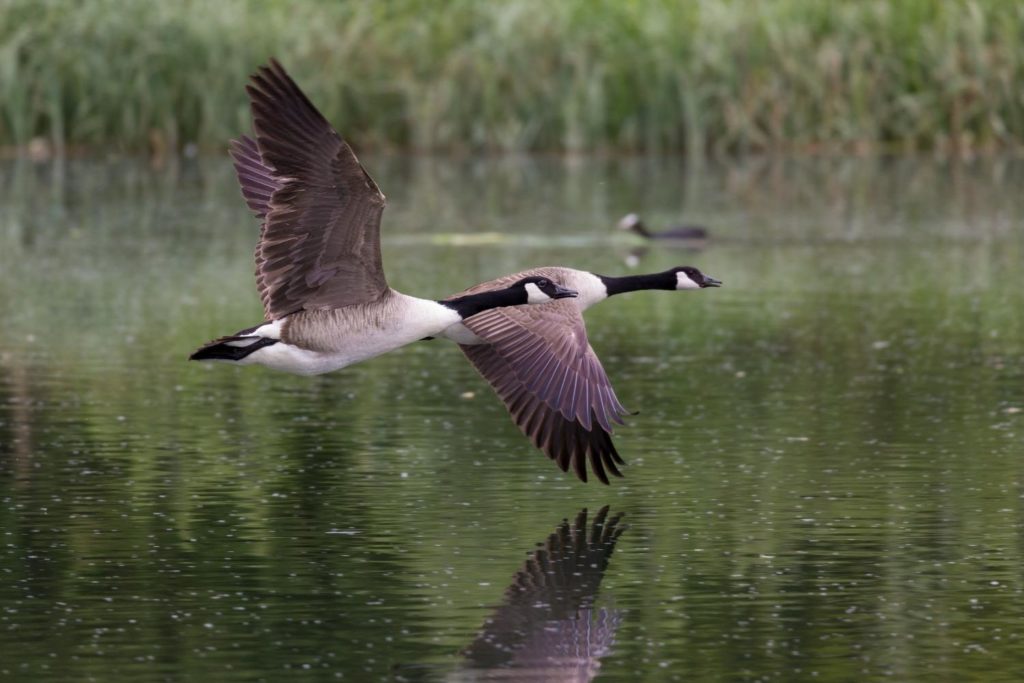
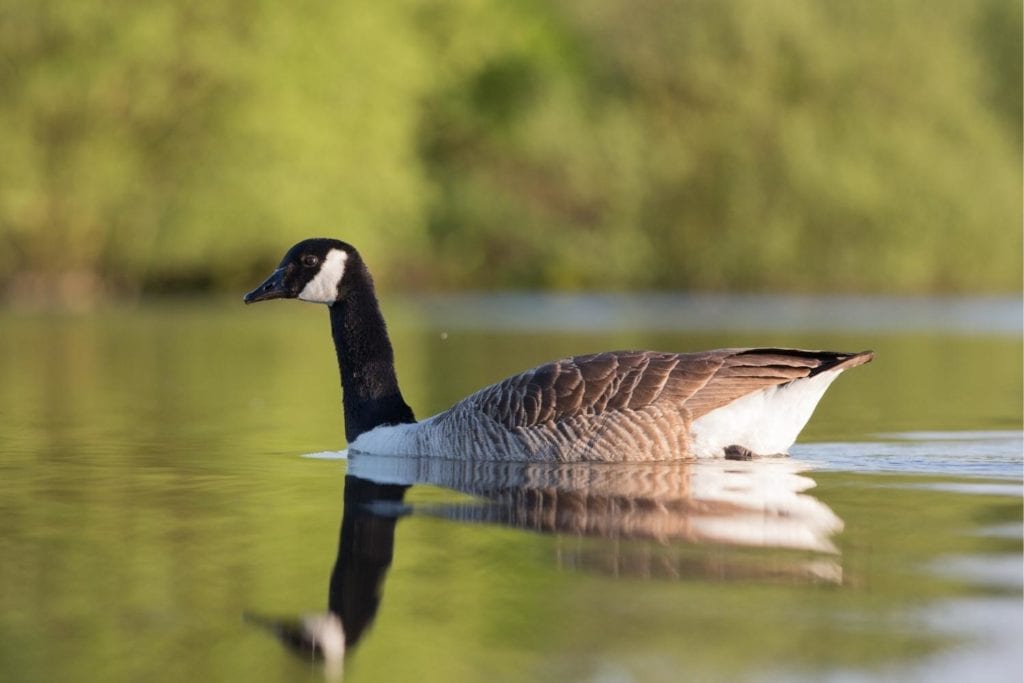
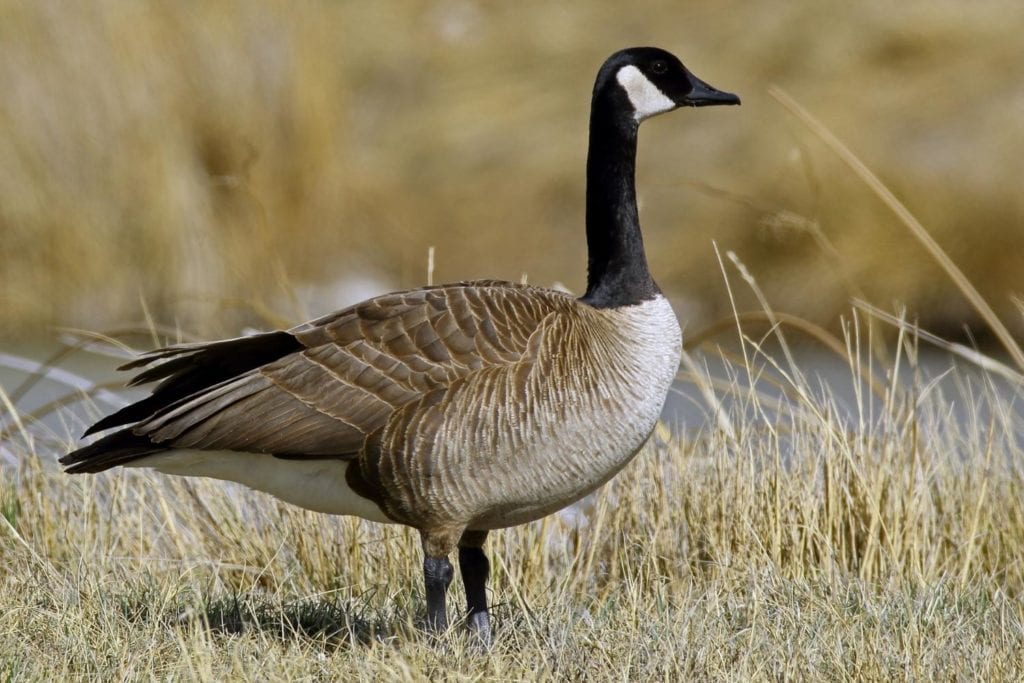
Classification:
Family: Anatidae
Genus: Branta
Description: Canada Geese are known for their long black necks. They have a thick white band at the base of their neck where their cheeks are. The body is a dark brown to black color, and the feet and legs are black.
Unlike most birds, Canada Geese actually have small teeth, or lamellae, on the edges of their bill. They use these teeth to cut things, like plants.
Diet: They are mostly herbivorous and feed mostly on grass like salt and Bermuda grass. They have also been seen eating things like corn, wheat, and rice.
Habitat: Canada geese can be found throughout most of Canada and the United States. It can also be found in some parts of Mexico.
They are not picky about where they live and can be found near rivers, lakes, bays, and marshes. You will also frequently find them in grass fields where they go in search of food. They avoid areas with tall grasses because they are unable to see predators.
Lifespan: About 10-24 years
Interesting Facts about Canada Goose:
- Canada Geese will fly as a flock in a v-formation because it helps them to fly longer distances while conserving energy
- Geese make a “honking” noise to communicate with each other, especially while flying
- They do not have many predators because they are large and will actively defend themselves when threatened
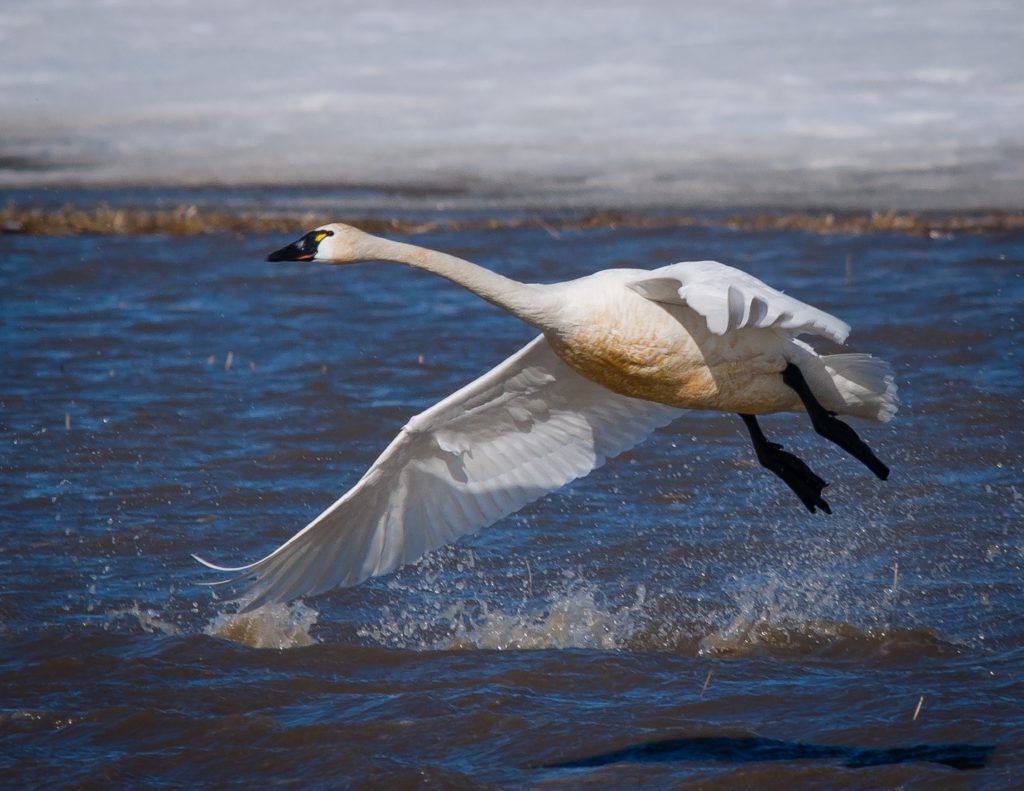
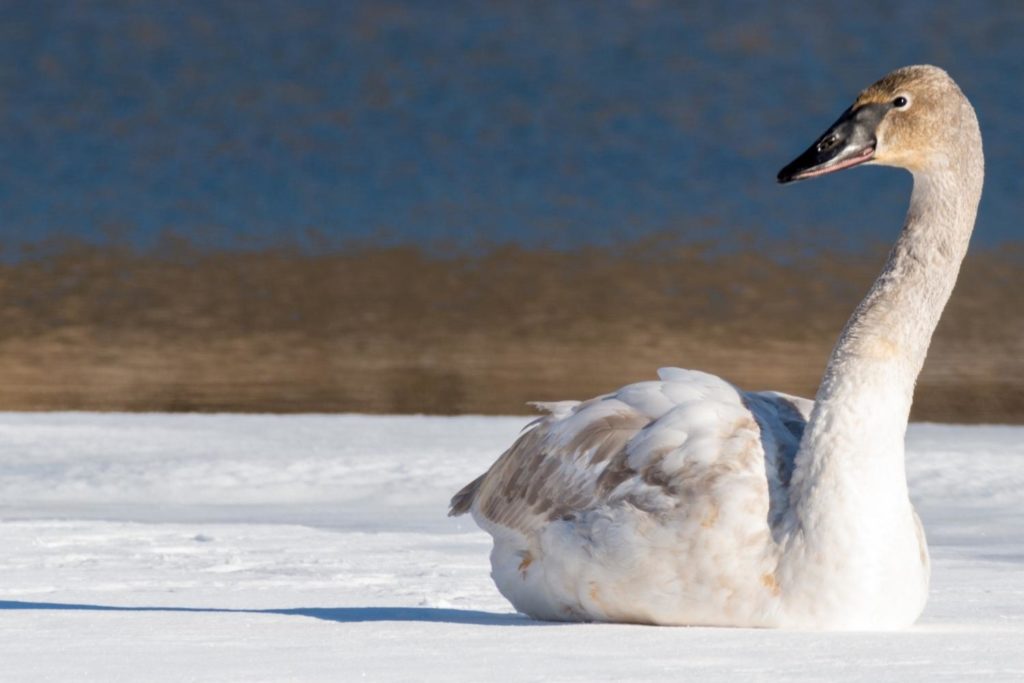
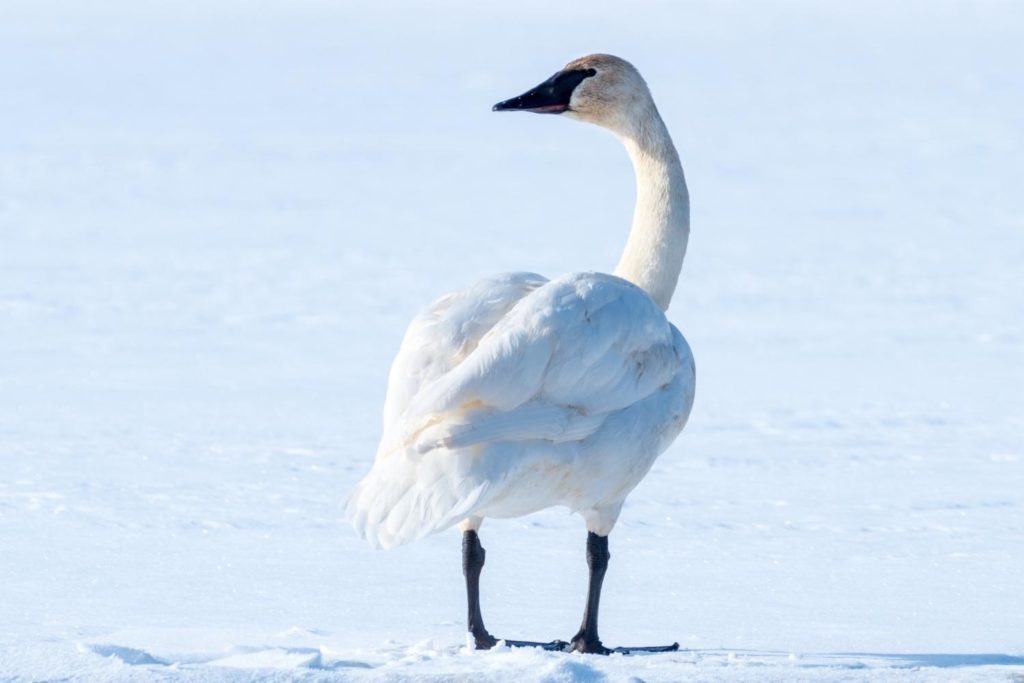
Classification:
Family: Anatidae
Genus: Cygnus
Description: Tundra Swans are very large birds with a wingspan of about 66 inches. The body is completely white, although the feet and bill are black. The neck is very long, but the head is small and rounded.
Diet: They are mostly herbivorous birds and will feed on tubers and roots of plants underwater. They have also been known to eat mollusks.
Habitat: Tundra Swans are found in arctic regions in northern Canada and Alaska. During winter, they will migrate south towards the Atlantic coast.
There are two populations of these swans. One will reside from the Chesapeake Bay south to North Carolina during winter. The other will travel to the Pacific coast to live from British Columbia to California.
You can find these birds across the Arctic tundra near saltwater bodies like bays, estuaries, and marshes. They can also be found in rivers, streams, ponds, and lakes.
Lifespan: About 15-20 years
Interesting Facts:
- The word “swan” is the same in English, German, and Dutch
- On land, swan species can move at speeds up to 22 mph/35 kmh
- Swans are seen a lot in mythology, symbolizing transformation
You may also like: Check out the 30 Different Species of Ducks You Must Know: With Images, Facts, and More!
Shorebirds
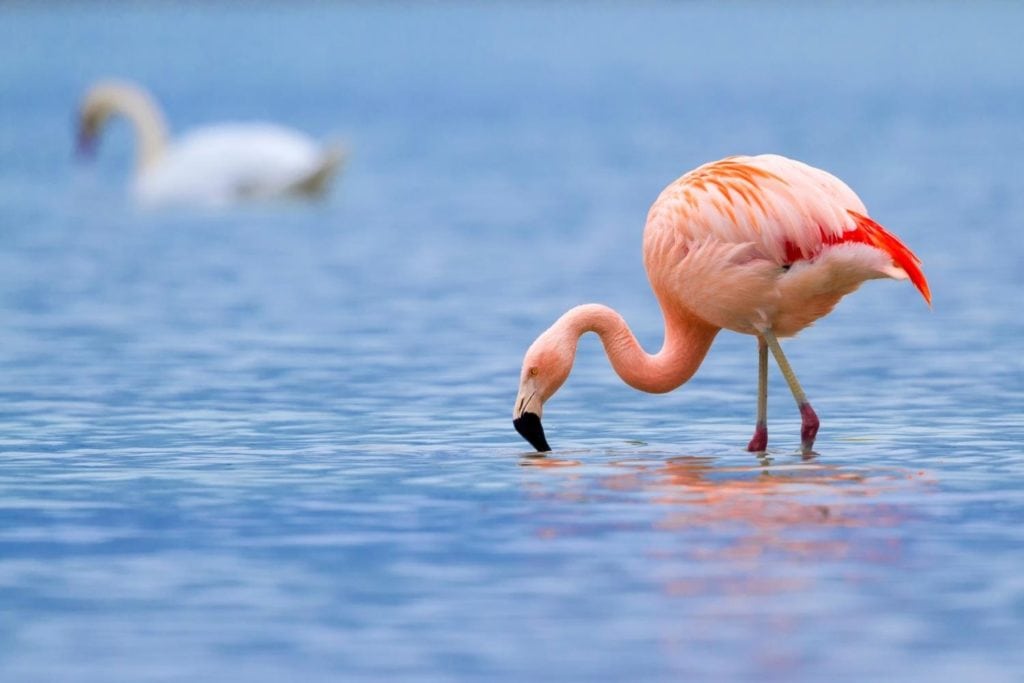
Shorebirds, or the order Charadriiformes, includes over 350 species of birds. To be considered a shorebird, they must live near the ocean, have long wings, strong webbed feet for walking and swimming, and waterproof feathers.
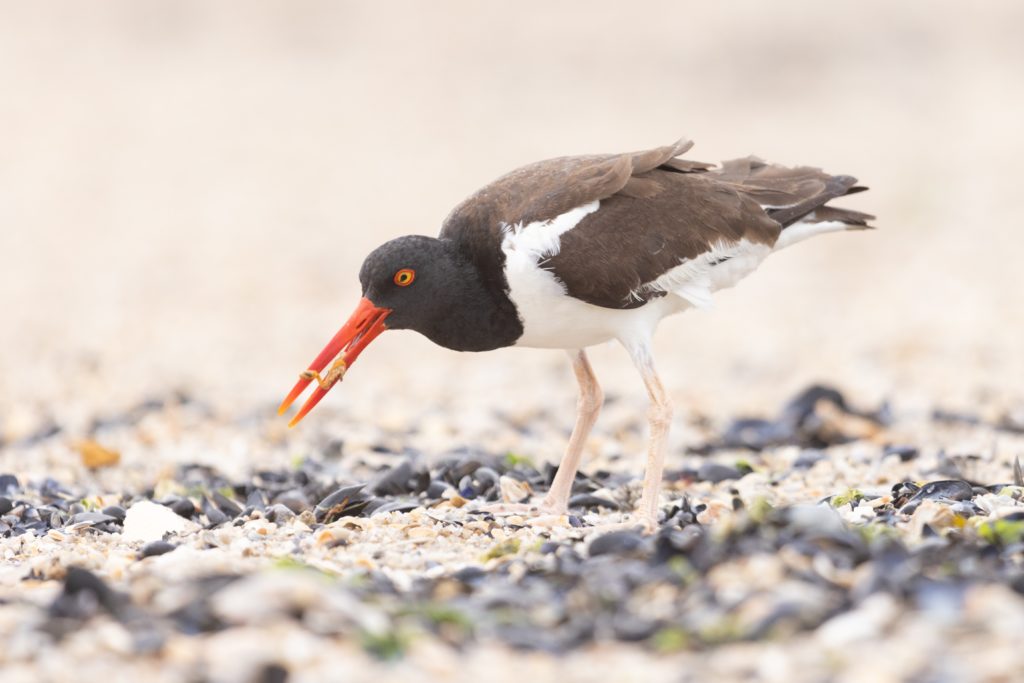
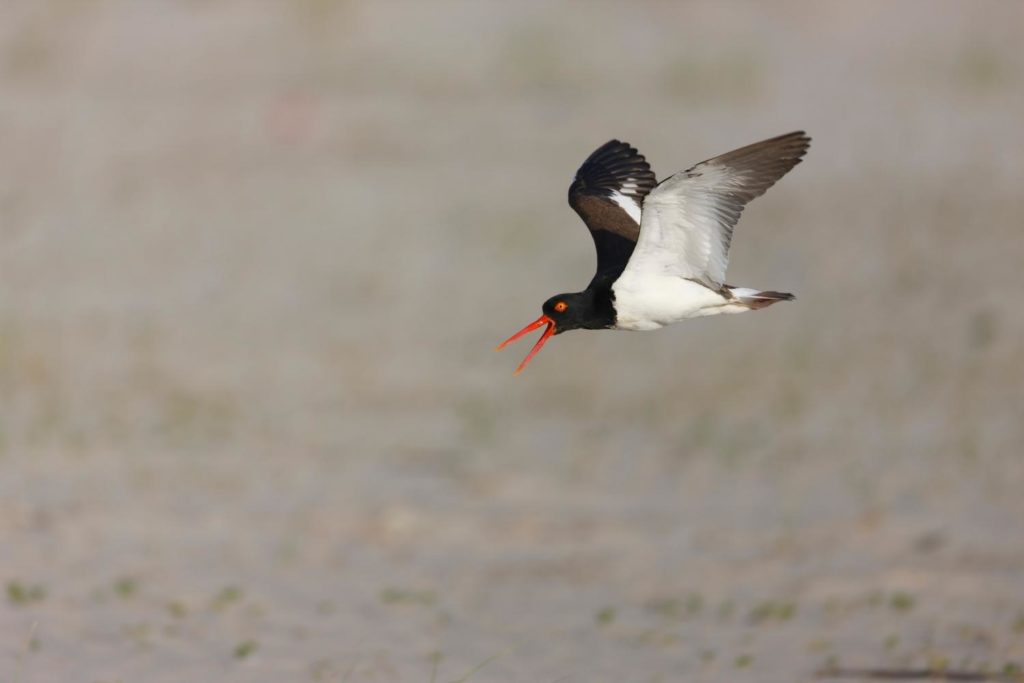

Classification:
Family: Haematopodidae
Genus: Pluvialis
Description: American Oystercatchers are large birds that have a long, bright orange bill. They also have very long legs that are light pink in coloration. Its back, wings, and head are black, but the underside is white. It also has stripes of white on its shoulders.
Diet: The reason that these birds have such long bills is so that they can break open the shells of bivalves like muscles and oysters. Although bivalves are their main food source, they’re also known to eat starfish, crabs, barnacles, and jellyfish.
Habitat: American Oystercatchers can be found along the Atlantic coast and the Gulf coast of the United States. They can be found as far north as Massachusetts, and are found as far south as Argentina and Chile. They’re also found along the Pacific coast from southern California down to South America.
They prefer areas on the coast that are sandy and rocky. They can also be found on mudflats or around marshes.
Lifespan: About 10 years
Interesting Facts:
- American Oystercatchers tend to run and walk more than they fly
- They are an indicator species meaning that they can give us insight into the environmental health of the locations they’re habitating
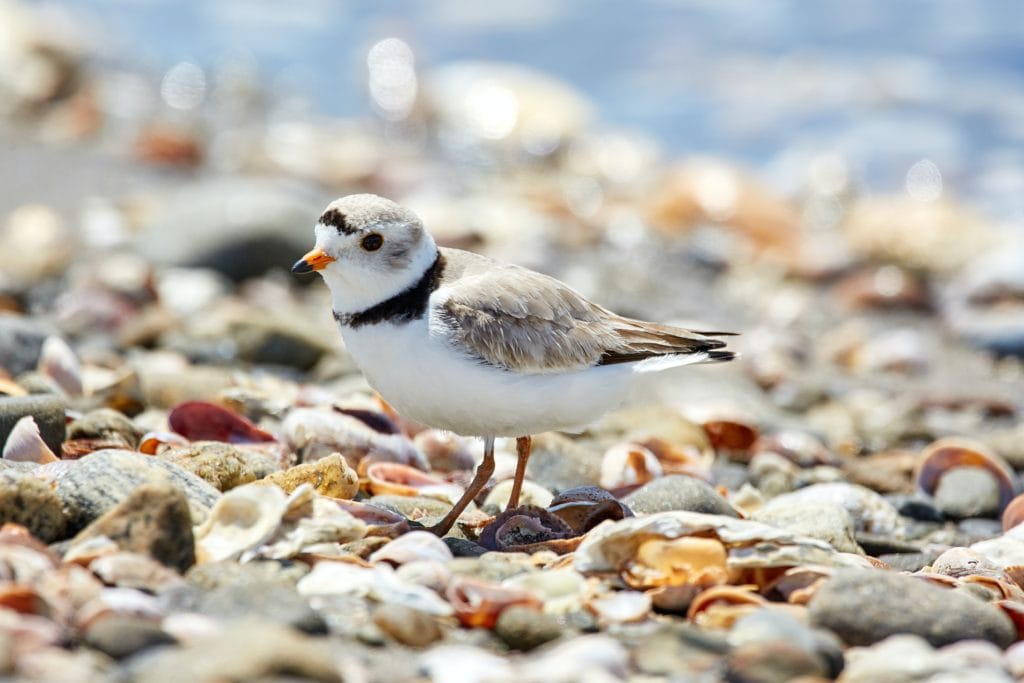
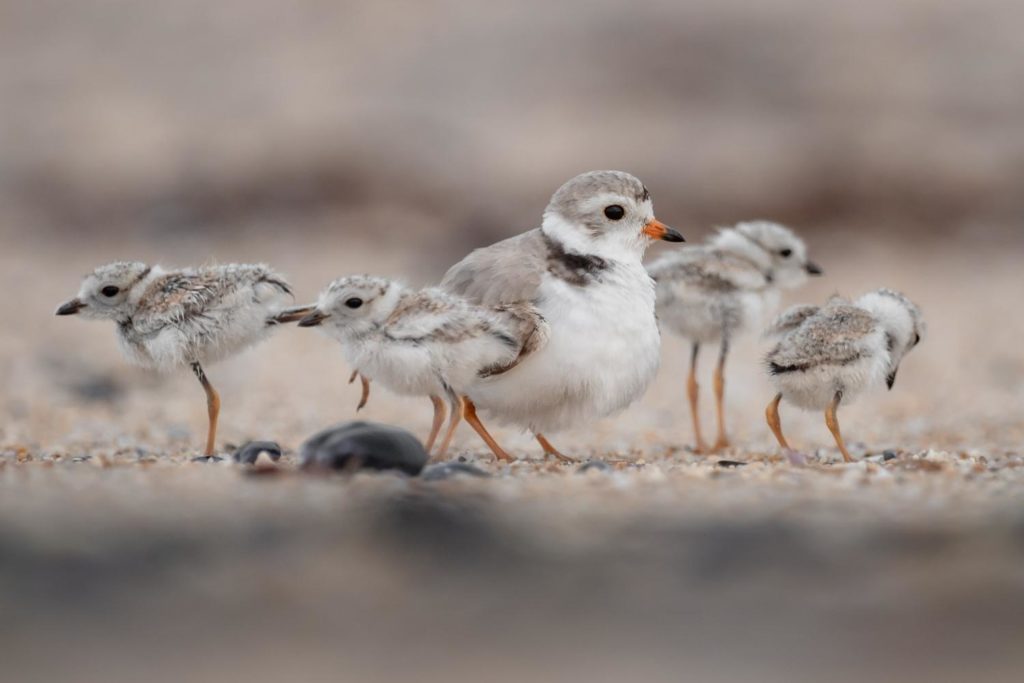

Classification:
Family: Charadriidae
Genus: Charadrius
Description: Piping Plovers are small seabirds that are sandy-brown in coloration on their backs, wings, and the tops of their heads. Their undersides and faces are white. Their beak is orange with a black tip, and they have a black band around their neck and over their eyes. Their legs are long and thin.
Diet: They feed on marine worms, fly larvae, beetles, insects, crustaceans, mollusks, and other invertebrates. They don’t really hunt for their food, but are more opportunistic scavengers. It will look for prey in the sand and quickly run to grab it when it spots it.
Habitat: Piping Plovers can be found in the center of North America from the Great Plains of Alberta, Canada, down to the northern Great Lakes. They are most commonly seen along the east coast and Gulf coast of the United States.
These birds prefer to spend time on sandy beaches hunting for food. They are also commonly found inland in sandy areas where it is more dry. You’ll see them near dunes, mudflats, lagoons, and salt marshes.
Lifespan: About 14 years
Interesting Facts:
- Piping Plovers are an indicator species that gives us an idea of how an ecosystem is doing
- They help control the insect and crustacean populations on beaches
- They create their nests in the sand above the high tide line
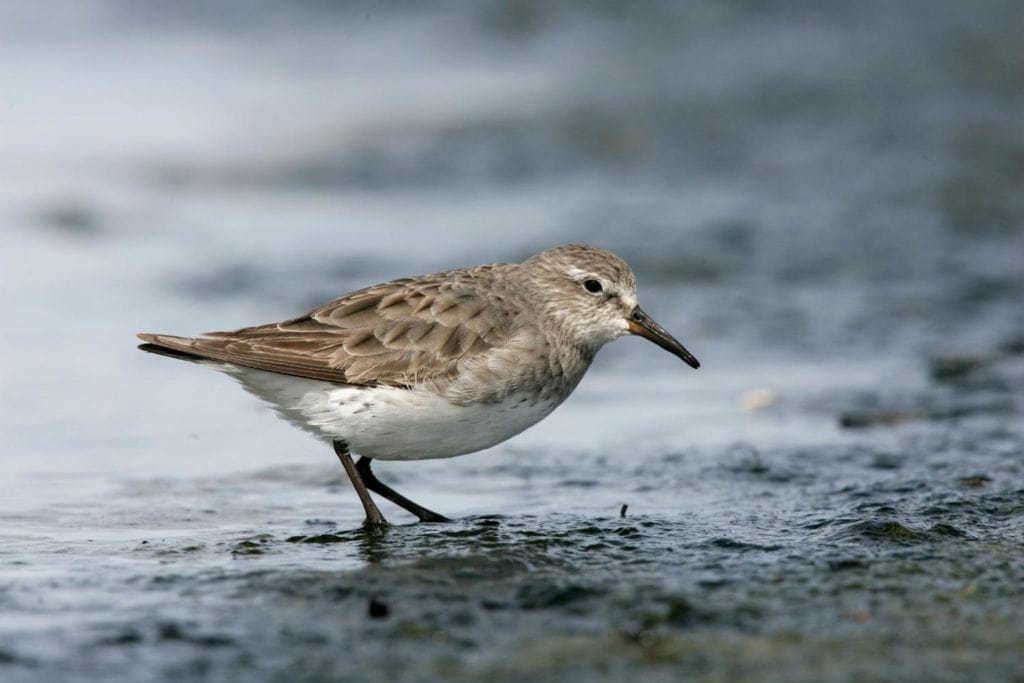
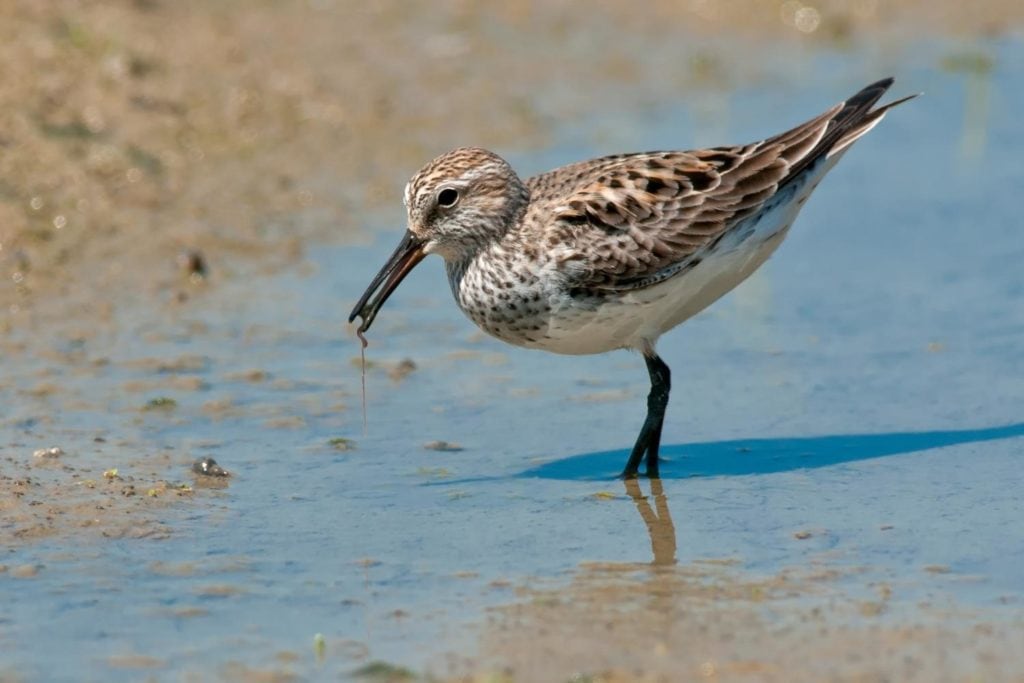
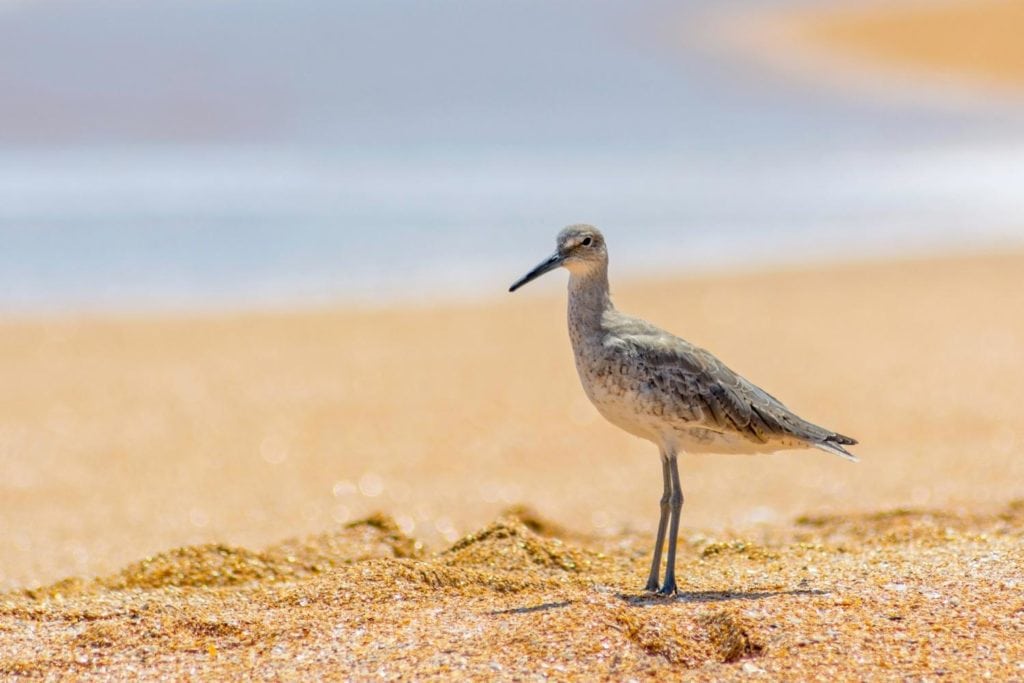
Classification:
Family: Scolopacidae
Genus: Calidris
Description: The White-Rumped Sandpiper is a small bird. Its back, wings, and head are a mottled light brown, dark brown, white, and black coloration. There are white bands over the bird’s eyes. The underside of the bird is a cream or white color. The legs are long and spindly, and they are black. The beak is also long, skinny, and black.
Diet: Their diet consists mainly of insects like beetles, grasshoppers, larvae, and spiders.
Habitat: White-Rumped Sandpipers can be found in the northernmost parts of Alaska and Canada. They are also found along the central and eastern portions of Canada and the United States. They can be found down the Atlantic coast of Mexico, Central America, and South America.
The main habitat of these birds is the tundra. When they migrate, they can also be found on mudflats, sandy beaches, flooded fields, and near rivers and lakes. They like areas with lots of vegetation and shrubs.
Lifespan: Up to 7 years
Interesting Facts:
- White-Rumped Sandpipers can swim, but rarely choose to
- Males will defend their territories and will fight in the air
You may also like: Learn the 15 Amazing Birds in Florida’s Beaches: Complete with Images, Facts, and More!
Seabirds
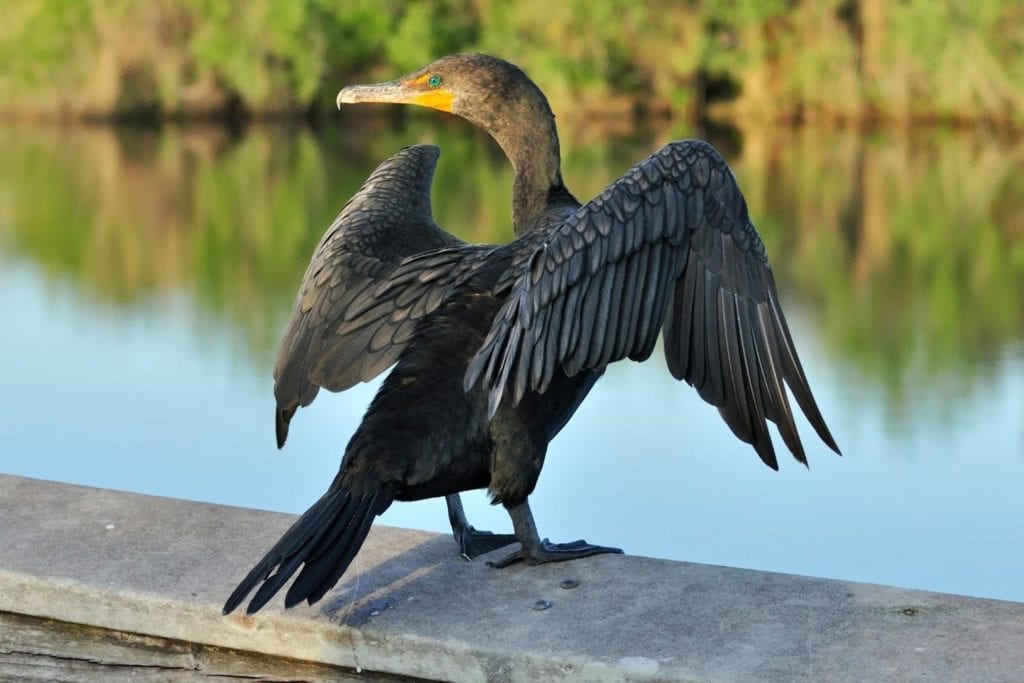
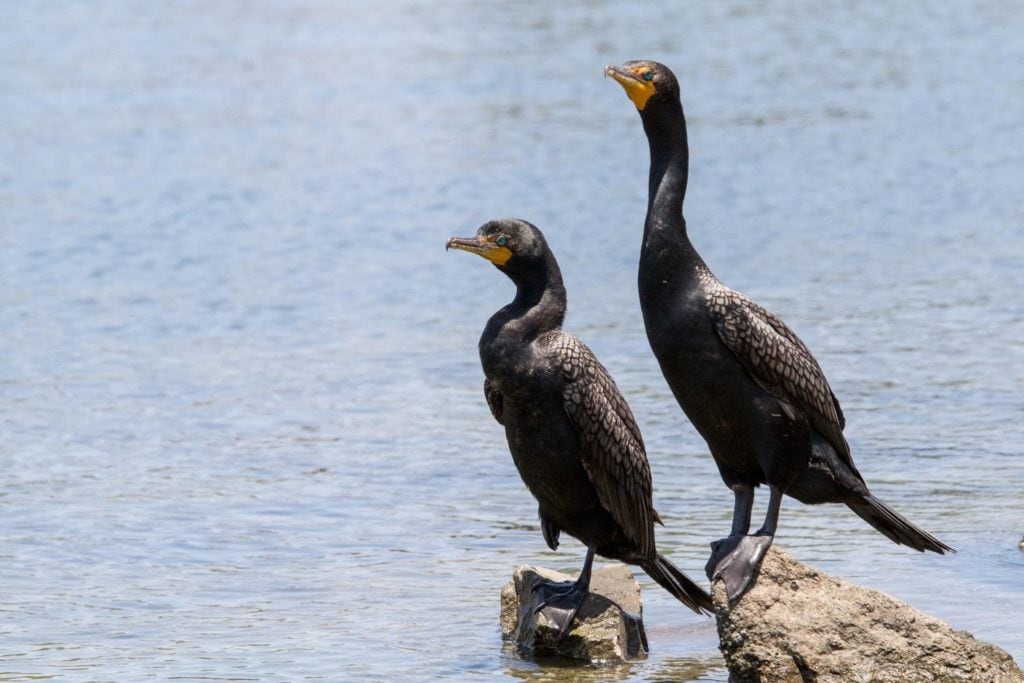
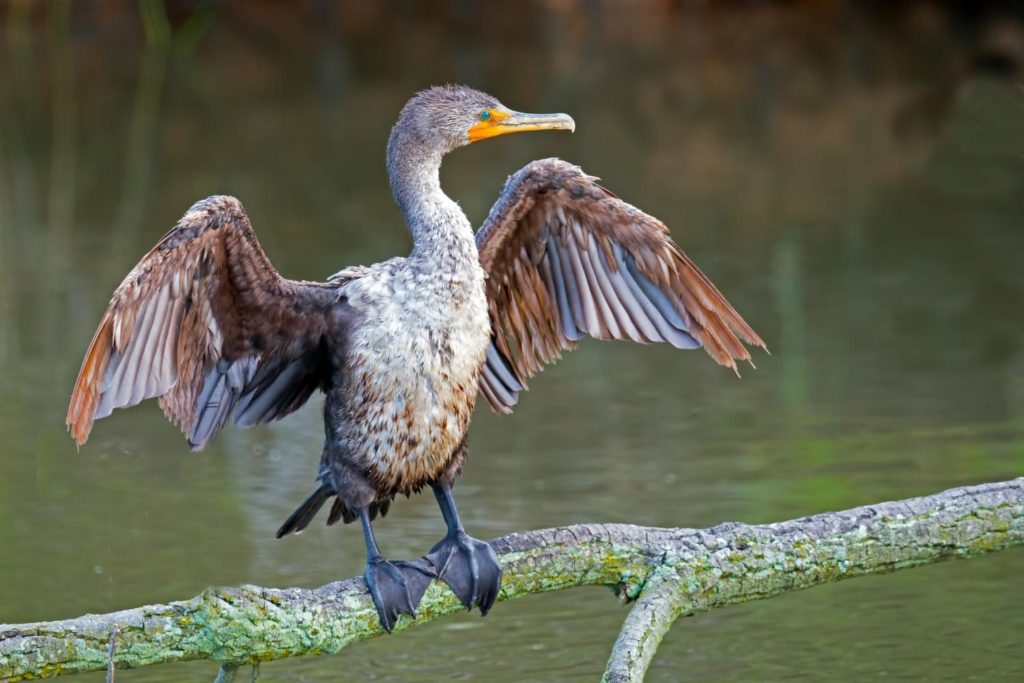
Classification:
Family: Phalacrocoracidae
Genus: Phalacrocorax
Description: Double-Crested Cormorants are one solid color with sleek, black feathers. They are large birds with a wingspan of about 4 feet/1.2 meters. The bill is slightly hooked, is orange, and has a throat pouch. Their tails are also quite long, and their black feet are webbed for swimming. The thing that makes these birds look unique is the tuft of feathers over their eyes.
Diet: Their diet consists of marine invertebrates and fish. To catch their prey, they will fly above the water and then dive into it. Once they catch the fish, they will throw it into the air before catching it again in their mouth.
Habitat: Double-Crested Cormorants can be found along the coasts of Nova Scotia and Alaska. They are also found from Mexico to the Bahamas, and along the coasts of southern New England.
These birds can be found in freshwater and brackish areas like lakes, rivers, bays, coasts, and swamps. They also like to have plenty of places to perch such as rocks, shipwrecks, sandbars, telephone wires, docks, or trees.
Lifespan: About 6 years
Interesting Facts:
- These birds are social; they breed in colonies, feed in groups, and migrate in groups
- After diving, to dry off, they will perch somewhere high with their wings spread out
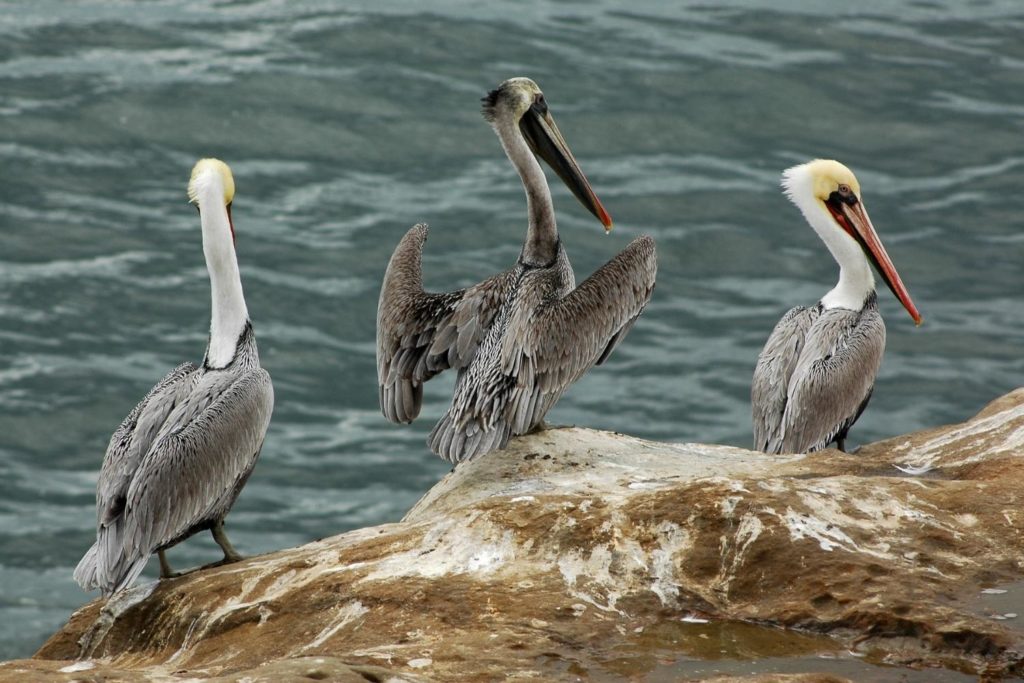
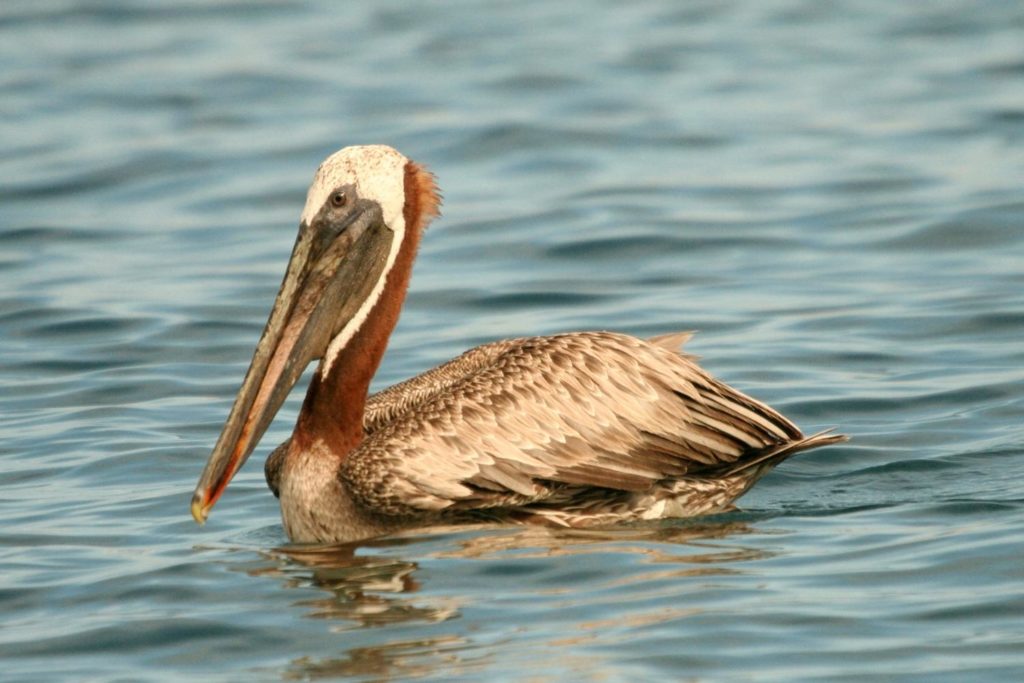
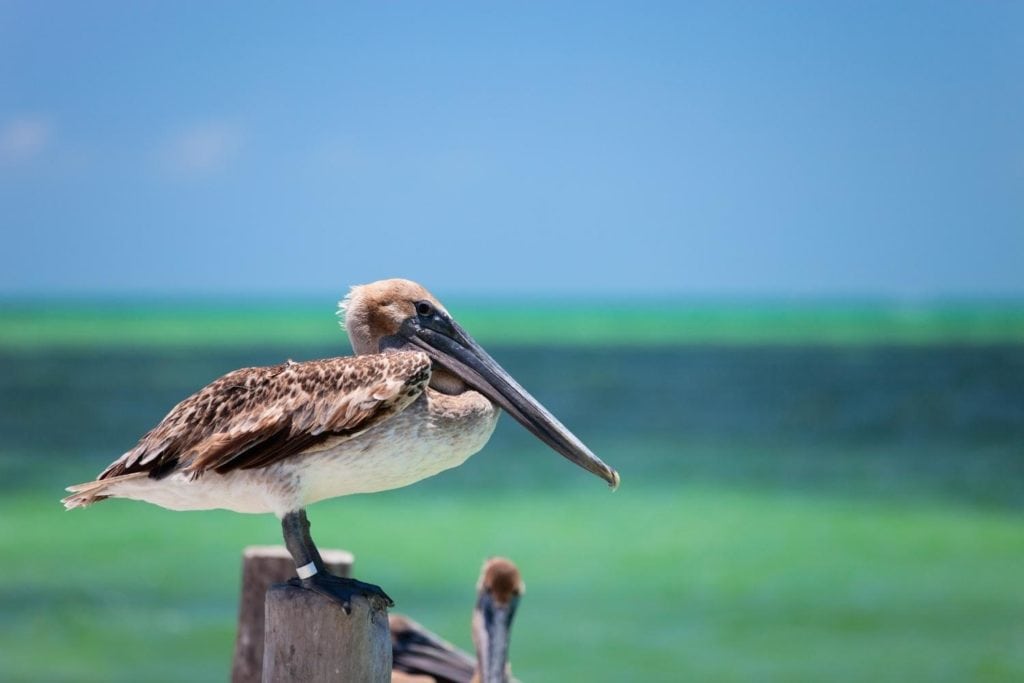
Classification:
Family: Pelecanidae
Genus: Pelecanus
Description: Brown Pelicans have dark backs and wings that are made up of brown and black feathers. The tips of the feathers are a lighter gray color. The necks are long and white, with fluffy tufts of orange at the crown of the head. The necks become brown over the breeding season. The beak is large, long, and brown.
Diet: Like the cormorant, the Brown Pelican catches its food by diving. The bill and the huge pouch are used like a net to scoop up water and fish. Some of their favorite fish include herring, mullet, menhaden, sheepshead, and silversides.
Habitat: Brown Pelicans are found along the Atlantic, Pacific, and Gulf coasts. They are found as far north as North Carolina and as far south as Venezuela on the Atlantic coast. On the Pacific coast, it can be found as far north as southern California and as far south as Chile. It can sometimes be found as far north as British Columbia and Nova Scotia.
They can be found along coastal areas near lagoons and sandy beaches. They will sometimes go near human-inhabited areas as well, like marinas. These birds never leave the coast, and will usually not be found more than 20 miles/32 kilometers from the coast.
Lifespan: Up to 10 years, typically
Interesting Facts:
- The Brown Pelican’s bill pouch can hold three times as much content as their stomach — almost three gallons of water
- Brown Pelicans are the only pelicans that catch their food by diving
- Gulls will sometimes try to steal fish right out of a pelican’s pouch
- Only 30% of Brown Pelicans survive their first year of life, and only 2% survive past 10 years of age — the oldest wild Brown Pelican was 43 years old
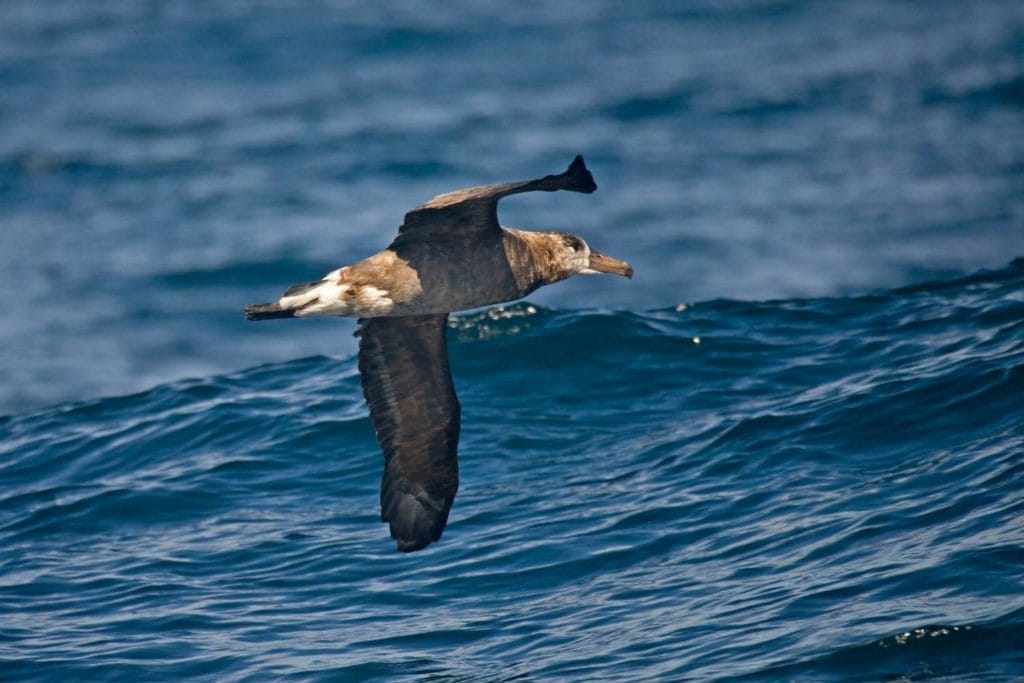
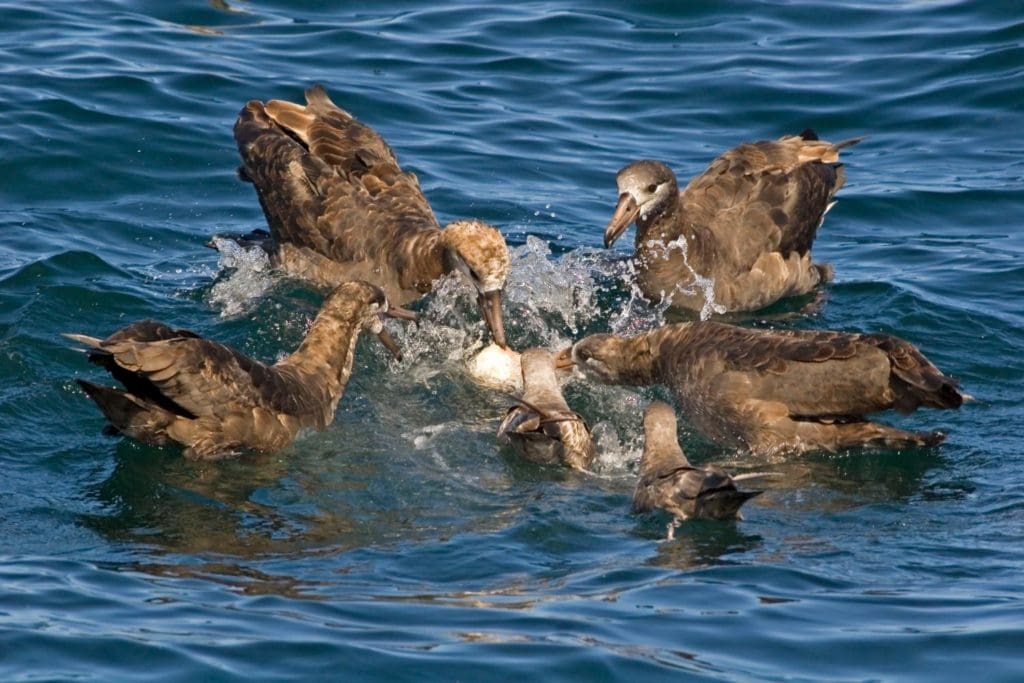
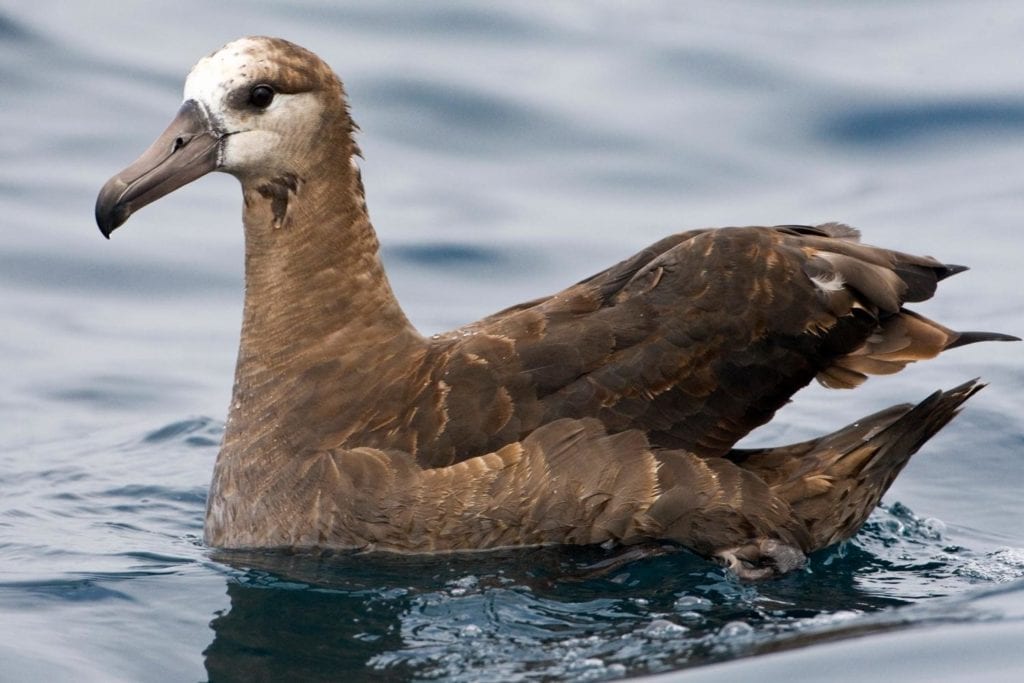
Classification:
Family: Diomedeidae
Genus: Phoebastria
Description: Black-Footed Albatross are exceptionally large birds with a wingspan of up to 7 feet/2.1 meters. Their bodies are a solid brown color, with their wings being a slightly darker brown. There are some white feathers around the eyes and base of the bill. The bill itself is somewhat long and brown with a curved tip. The feet, of course, are black.
Diet: Although these birds are large, they do most of their hunting by scavenging. They will often follow fishing boats to eat their leftovers. When they’re not doing that, they will scoop fish, fish eggs, and squid from the surface of the ocean.
Habitat: Black-Footed Albatross are found on islands in the mid-Pacific Ocean where they breed. They can also be found breeding along the Pacific coast of North America.
They are found flying across the open ocean and around islands off the coast of the northern Pacific. They spend most of their time flying over the open waters and will only come to land to breed and rest.
Lifespan: About 36 years
Interesting Facts:
- According to the myths of ancient sailors, albatross contain the souls of a sailor killed at sea — many sailors would still eat them despite this
- “Albatross” means “the diver” and comes from the Arabic word “al-qadus”
- An albatross almost never stops moving and can travel thousands of miles/kilometers a year
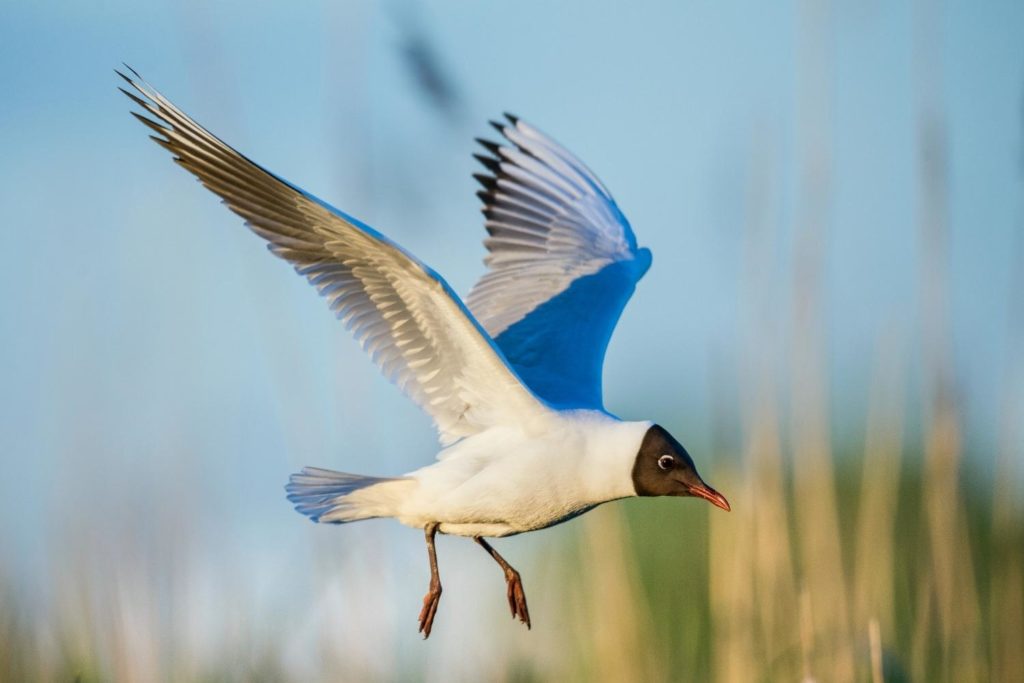
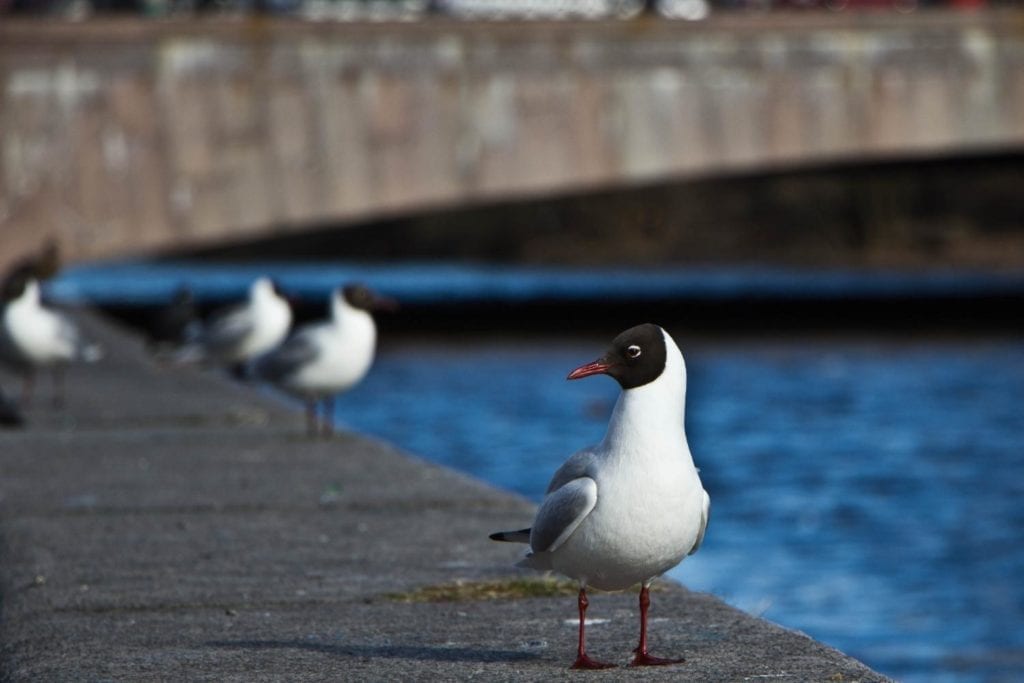
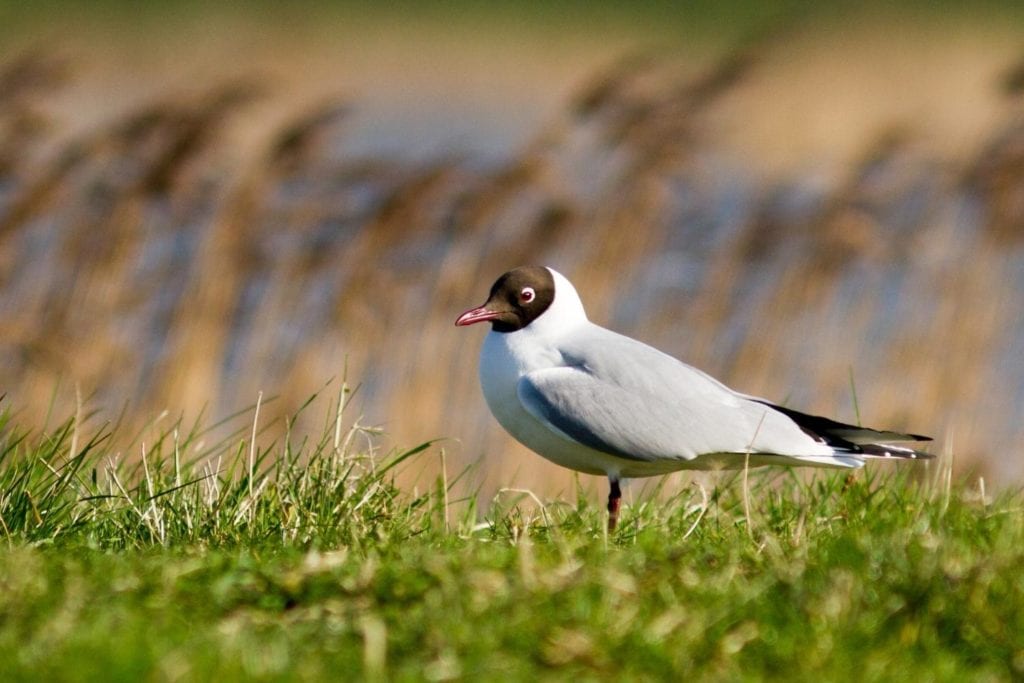
Classification:
Family: Laridae
Genus: Larus
Description: Black-Headed Gulls are named as such because their heads are made up of sleek black feathers. Their beaks are long, pointed, and also black. The tail is black, but the wings are a dark gray. The neck and underside of the gulls are white. The long, spindly legs and the feet are a light red. They have a wingspan of about 39-42 inches/91.4-106.6 centimeters.
Diet: These birds are omnivorous and will eat just about anything. Their favorite foods include insects, fish, and earthworms, but they will also eat carrion, seeds, berries, and garbage.
Habitat: Black-Headed Gulls are found in northeastern Canada, Greenland, Iceland, and northern Europe and Asia. They can also be found breeding in Africa and more southern parts of Asia. In the United States, they are found along the Atlantic coast over winter time.
They prefer to live in areas like lakes, rivers, bays, coasts, estuaries, and marshes.
Lifespan: Up to 18 years
Interesting Facts:
- These gulls have been known steal food from other gull and birds
- During the breeding season, males will congregate near the nesting colony, making up what is called “clubs”, waiting for the females to arrive
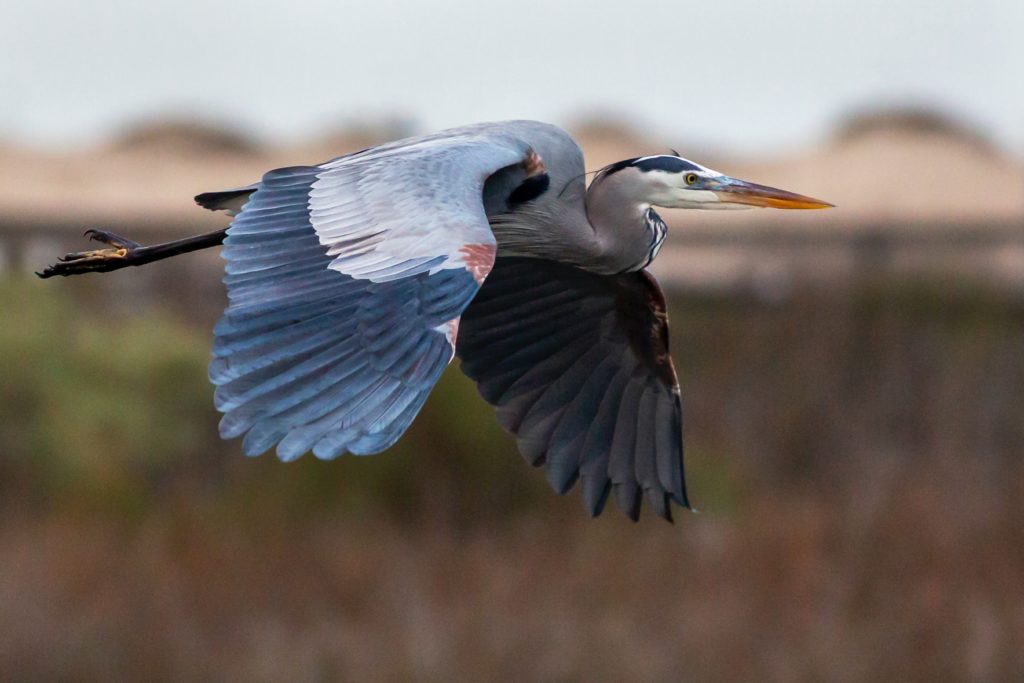
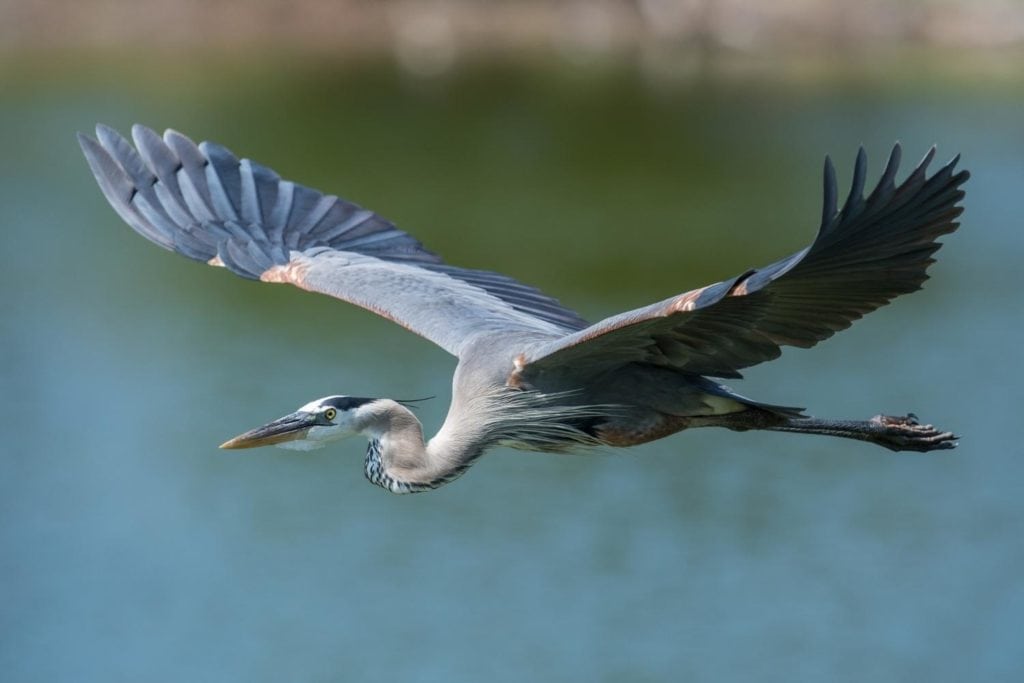
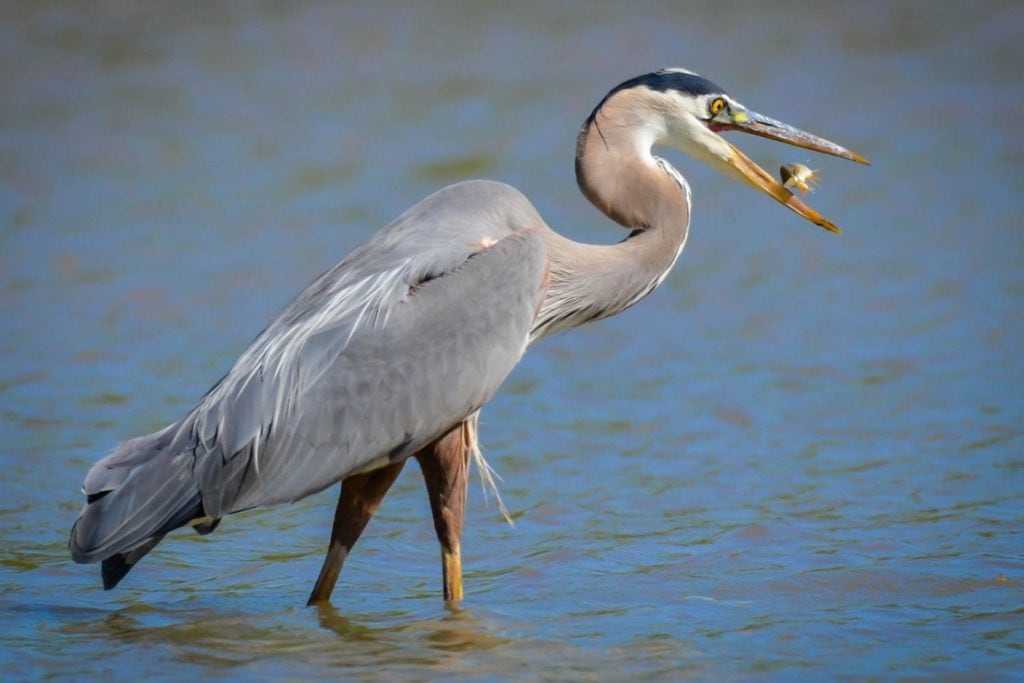
Classification:
Family: Ardeidae
Genus: Ardea
Description: Great Blue Herons are the largest herons found in North America. They have a wingspan of about 6 feet/1.9 meters. Their bodies stand about 3-4 feet/0.9-1.2 meters tall. The feathers of the wings, back, and neck are dark blue-gray. The head is white, but there is a plum of black feathers at the crown of the head.
The legs are very long, and are reddish-orange in color. The bill is very long and sharp. It is an orange and yellow color with a bit of black.
Diet: These birds are carnivorous and feed mostly on frogs and fish. They are also seen eating lizards, snakes, shrimp, crabs, dragonflies, and grasshoppers. They will also sometimes eat birds and small mammals.
The herons hunt by standing in the water. They will search the water from above, waiting for the prey to pass by. Then, they will quickly reach into the water and snatch the prey.
Habitat: The Great Blue Heron is found in Canada all the way south to the Caribbeans and Mexico when it breeds. During the winter months, it can be found a bit further north through Alaska and New England.
They prefer to live in ponds, lakes, rivers, coasts, and marshes. They need to live near a source of water, but they also need tall trees to rest and nest in. They will often rest in groups called “rookeries”, which requires a group of trees.
Lifespan: About 15 years
Interesting Facts:
- When Great Blue Herons fly, they move their heads into an S-shape
- Although Great Blue Herons are very large, they only weigh about 6 pounds/2.7 kilograms
- The oldest wild Great Blue Heron was 24 years old

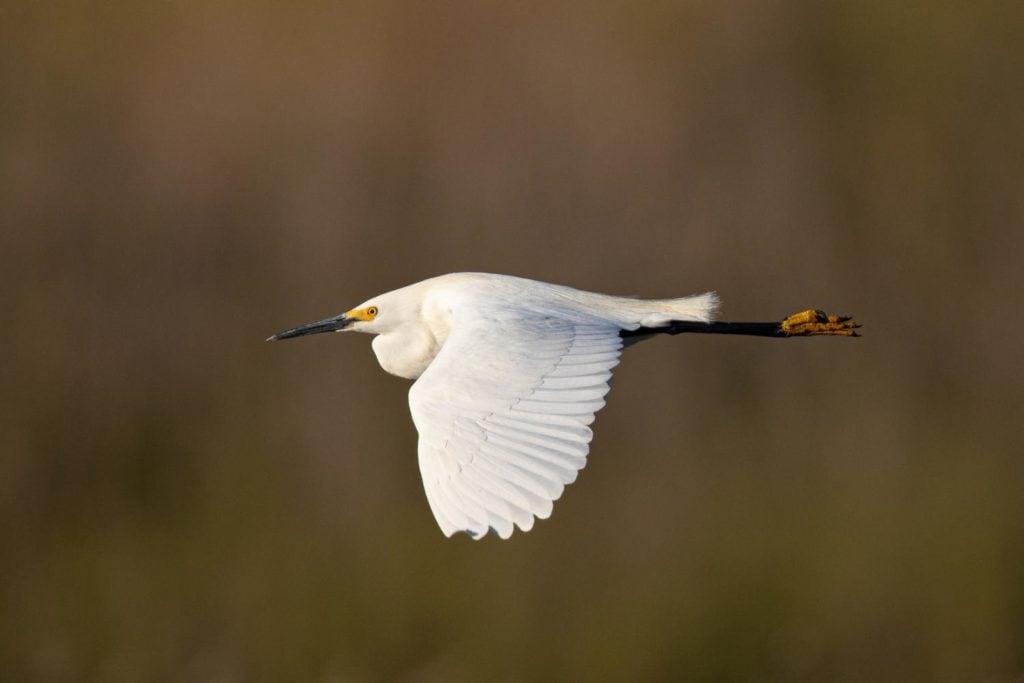
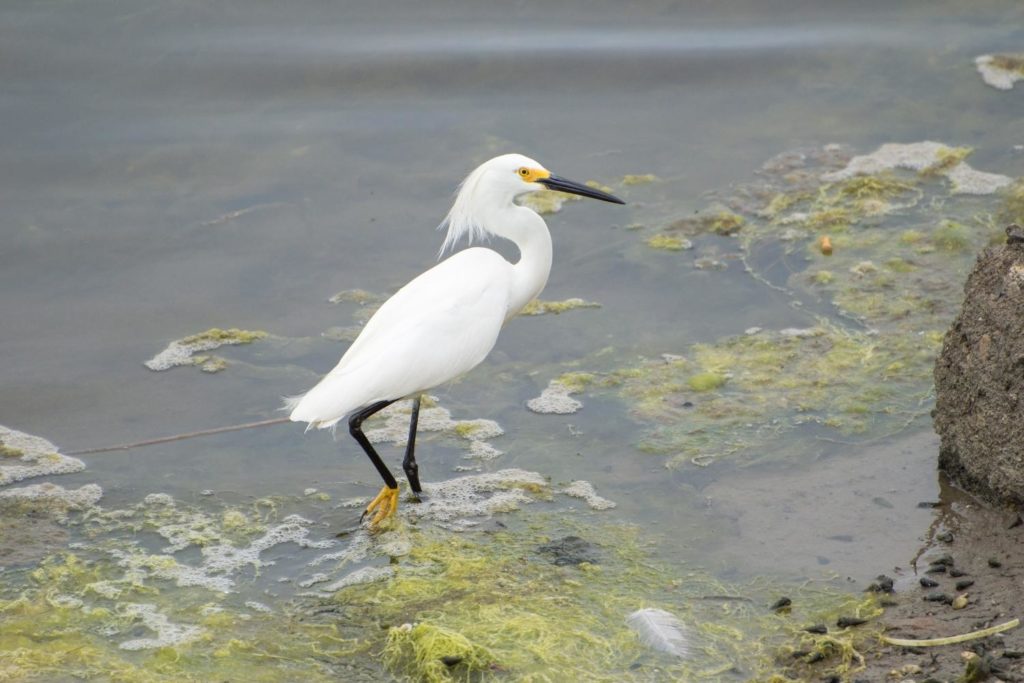
Classification:
Family: Ardeidae
Genus: Egretta
Description: The Snowy Egret is technically a kind of heron, it’s just much smaller than most herons. Unlike the Great Blue Heron, the Snowy Egret is only about 2 feet/0.6 meters in length, and the wingspan is about 3 feet/0.9 meters.
It is called a Snowy Egret because the feathers are all white. There is a yellow patch of skin around each eye. The long legs are black, but the feet are bright yellow. When they are breeding, they develop plumes on their head, neck and back. Also, the yellow feet turn bright red.
Diet: They are primarily carnivorous and their diet consists mostly of 25% crustaceans and 75% fish. However, they can also be seen eating insects, worms, snakes, frogs, lizards, and some aquatic vegetation.
Shallow water is essential for Snowy Egrets to find their food. They will run through the water to kick up their prey from the substrate. It may also choose to be inactive, simply waiting for the prey to swim by.
The egret will then snatch it up. It may also do a combination of these strategies by standing in the water and stirring the mud with their foot in place. Lastly, it may fly above the water and dive to catch its prey.
Habitat: Snowy Egrets can be found along the Atlantic, Pacific, and Gulf coasts when they are breeding. When they’re not breeding, you’ll find them in California all the way down to South America on the west coast. On the east coast, they can be seen from Virginia to the Caribbean.
You can see these birds in both freshwater and marine habitats. They live in ponds, swamps, marshes, mudflats, lagoons, mangroves, flooded rice fields, and along shores. They prefer to live near water bodies that are shallow because it makes it easier for them to find food.
Lifespan: Up to 17 years
Interesting Facts:
- Only 29.4% of Snowy Egrets survive past one year of age
- Snowy Egrets may be hunted by raccoons, Great-Horned Owls, and American Owls, among others
You may also like: 30 Types Of Seagulls: Exploring The Amazing Variety Of These Seafaring Birds
Flightless Birds
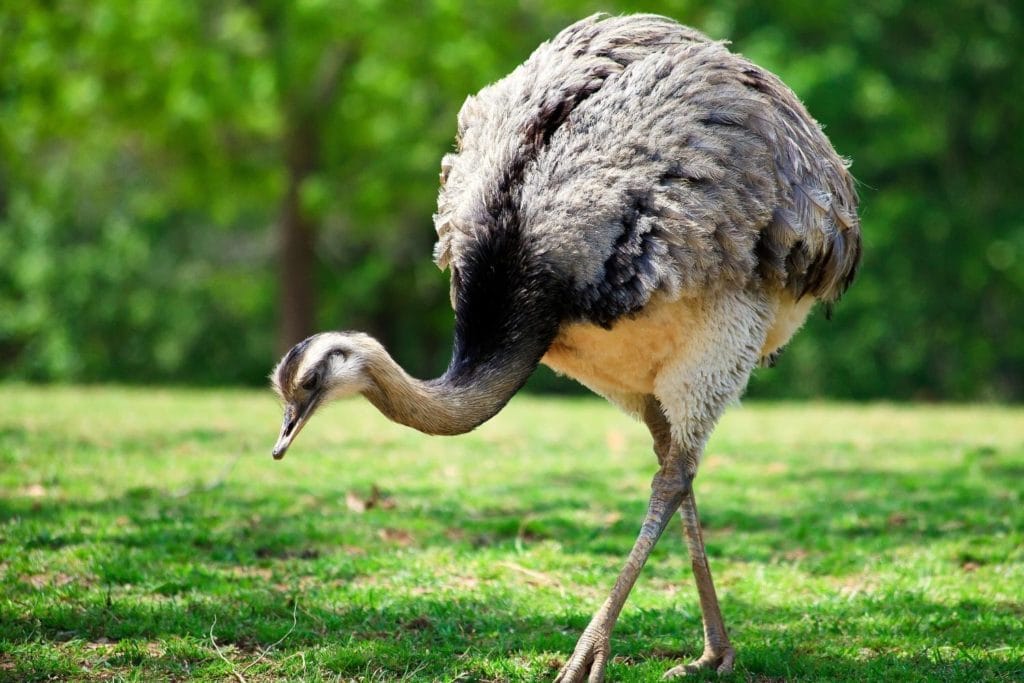
Flightless birds are classified into four different orders: Struthioniformes, Rhei-formes, Casuariiformes, and Apterygiformes. Some taxonomists group all flightless birds into a single order called Struthioniformes. To be considered a flightless bird, a bird must — of course — not be able to fly.
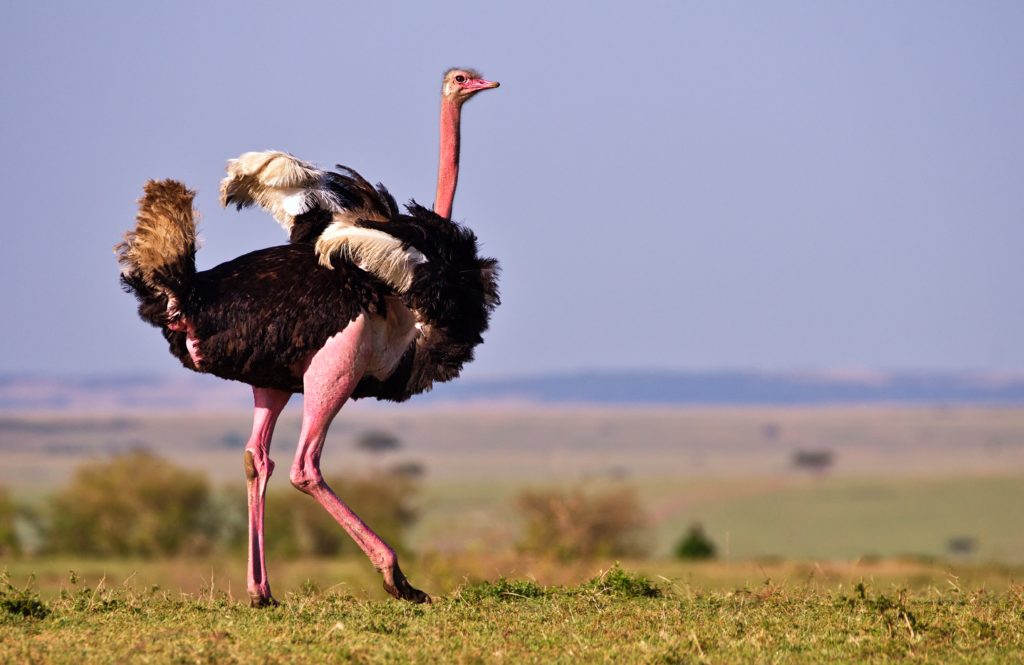
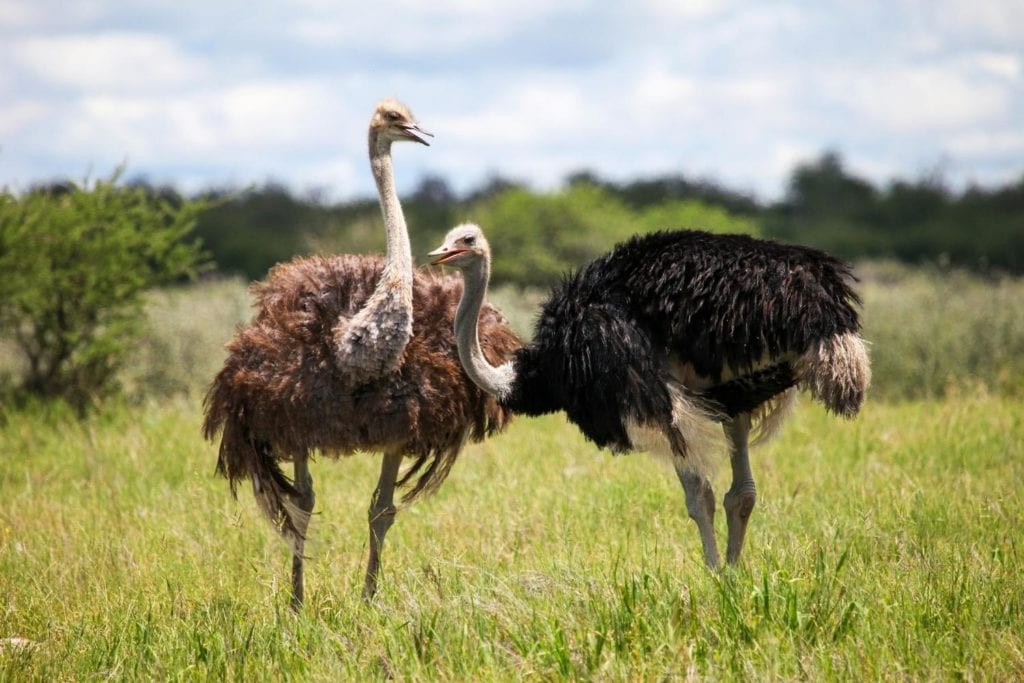
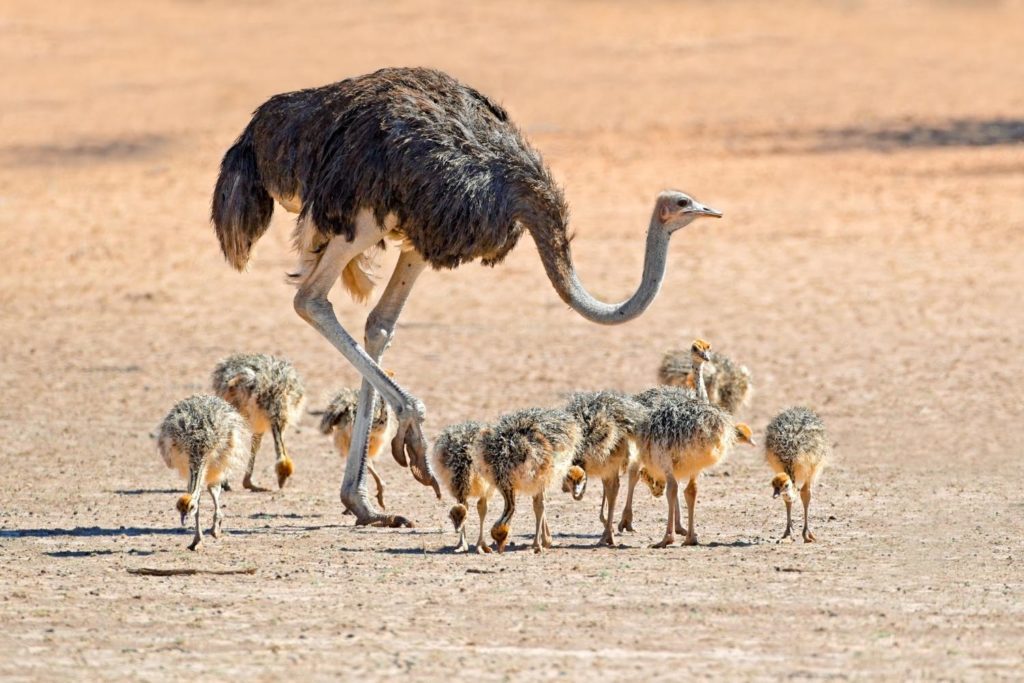
Classification:
Family: Struthionidae
Genus: Struthio
Description: Ostriches are very large birds, about 6.5 feet/2 meters tall. The males are black and white in coloration, while the females are grayish-brown.
Ostriches have barely any feathers on their neck heads or legs, and only have a short layer of down. The skin of the legs may be pink or brown. They have very long claws on their feet, and they have long and powerful legs to help them run quickly.
They look very similar to emus, but they are significantly larger. Ostriches only have two toes, while emus have three. Ostriches are also more herbivorous than emus who prefer meat.
They don’t have teeth, which means they have to swallow their teeth whole. To help them digest their food, they have three stomachs and very long intestines. They will even swallow stones to help grind up the food in their stomachs.
Because of their massive size, ostriches cannot fly. Instead, they use their wings for balance and courtship.
Diet: They are mostly herbivorous and will feed mostly on plant matter. However, they will sometimes eat carrion leftover from predators. Interestingly, these birds are very picky about what they will eat. They will only eat the seed heads from specific flowers and grasses.
Because they live in a very dry area, they can go for a long time without water. They can go days without any water, and can lose up to a quarter of its body weight in water before it’s forced to drink more.
Habitat: Originally, Ostriches were found in southwestern Asia, Africa, and the Arabian peninsula. Sometime in the mid 20th century, Ostriches were hunted almost to extinction. Today, they can only be found in sub-Saharan Africa.
These birds can be found in Savanna or grassland in central and southern Africa. These locations are typically very sandy and dry. There is usually brush in these areas for the ostriches to hide in. When there isn’t any brush, the birds will rely on their speed to escape predators.
Lifespan: Up to 50 years
Interesting Facts:
- Ostriches are the largest birds in the world
- They can run incredibly fast, up to 42 mph/67.5 kmh
- The ostrich’s eye is 2 inches across, making it the largest eye of any terrestrial animal
- They only have two toes
Classification:
Family: Apterygidae
Genus: Apteryx
Description: Great Spotted Kiwis are about 17.7-21.6 inches/45-55 centimeters. Their bodies are round and stout, but they have long bills. They have a collection of brown, white, and gray feathers over their bodies that make them look spotted. Unlike the bill, the legs are very short. Because these birds can’t fly, their wings and tails are significantly small for their body size.
An interesting thing about these birds is that they’re nocturnal, and their eyes are underdeveloped. To make up for this, their sense of smell is much sharper than that of diurnal birds.
Diet: These birds are omnivorous, and their diet is made up mostly of earthworms, beetles, and spiders. A small portion of their diet also consists of fruits and seeds.
Habitat: The Great Spotted Kiwi are native to New Zealand in northwest Nelson, the Paparoa Range, and the Arthur’s Pass-Hurunui district.
These birds prefer to live in hardwood forests, scrubland, beach forests, and grasslands. They like to hide in dense vegetation, within rocks, and in tree branches, roots, and in dead logs.
Lifespan: Up to 20 years
Interesting Facts:
- Kiwis are one of the oldest birds still living — its evolution began 30 million years ago
- They have a lower body temperature than any other bird species
- Kiwis are the only birds in the world with the nostril at the tip of their bill
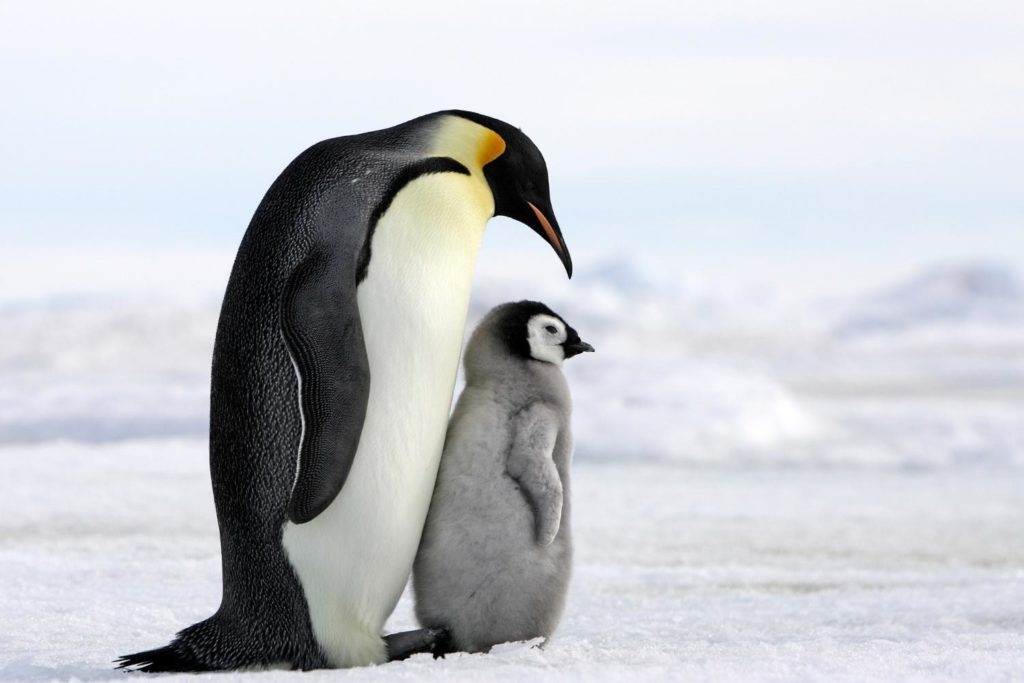
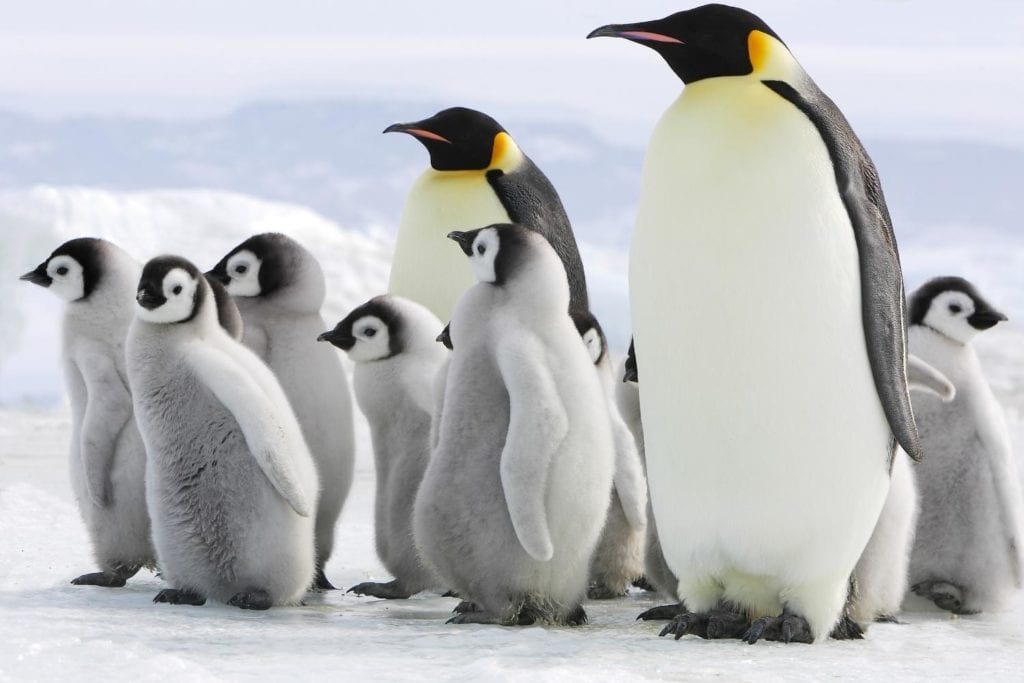
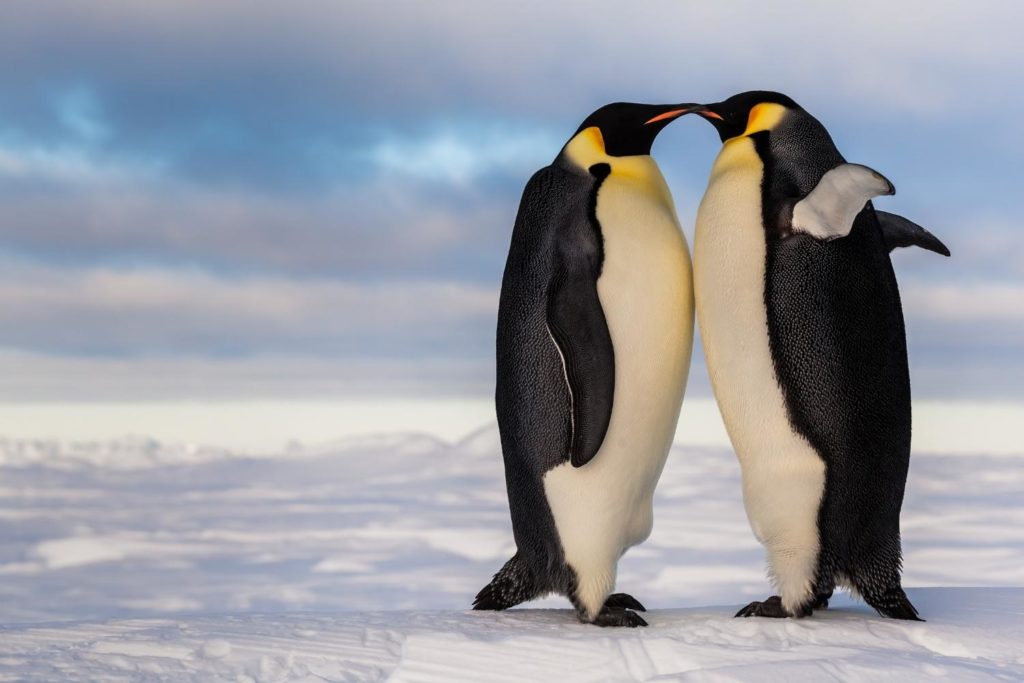
Classification:
Family: Spheniscidae
Genus: Aptenodytes
Description: Emperor Penguins are the largest sea birds that are found on Antarctica. Their wingspans can reach 29.9-35 inches/76-89 centimeters wide. As with most penguins, their bodies are black and white. Their wings are not usable, but hang stiffly by their sides.
The wings, back, head, and throat are all black. Their underside is white all the way up until their neck where the feathers become black. Near their ears, there is a section of feathers that is orange and yellow. These feathers go backwards from their ears, but stop around the shoulder area. There are also some orange and yellow spots on their heads and chests.
Diet: These birds are carnivorous, and their diet consists mostly of fish, mollusks, and crustaceans. Their tongues are rough and spiky which allows them to more easily catch fish.
These penguins will dive to catch their prey. They are capable of diving 1,640 feet/500 meters at once and can hold their breath for up to 15 minutes. However, they rarely travel this far or deep because it puts them at higher risk of predation. Instead, they prefer to stay near the surface.
Habitat: Emperor Penguins are found in Antarctica and its surrounding sub-Arctic islands. When they are breeding, they are found closer to the coastlines. They are occasionally found on Tierra de Fuego which is the southernmost portion of South America, although they do not stay here long.
These penguins live only in Antarctica and its surrounding islands, and they are used to frigid temperatures of -40-32 degrees Fahrenheit/-40-0 degrees Celsius. With the wind, temperatures can feel as low as -76 degrees Fahrenheit/-60 degrees Celsius.
When they’re breeding, the penguins will make their way to the coastlines where the ice is thick. Other times of the year, they are found closer to the open ocean. They prefer ice zones that are packed seasonally because it gives them plenty of access to the water.
Lifespan: About 15-20 years
Interesting Facts:
- Emperor Penguins can swim at speeds up to 12.4 mph/20 kmh
- The Southern Giant Petrel is the source of 30% of Emperor Penguin chick deaths
- Emperor Penguins breed during the harshest, darkest, and coldest months of the year
You may also like: Learn the 14 Birds Species in Pennsylvania You Shouldn’t Miss: Complete with Images, Facts, and More!
Landfowl
Landfowl, or the order Galliformes, is a group of birds made up of over 300 species. To be considered landfowl, a bird must have a thick, heavy body and rely on ground feeding for its meals.
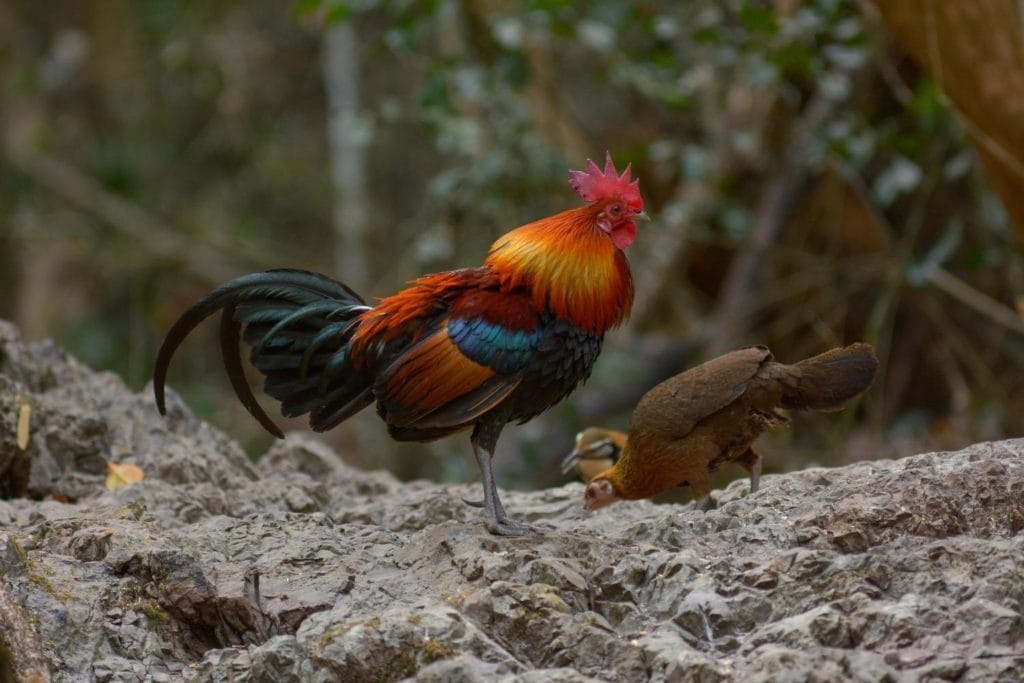

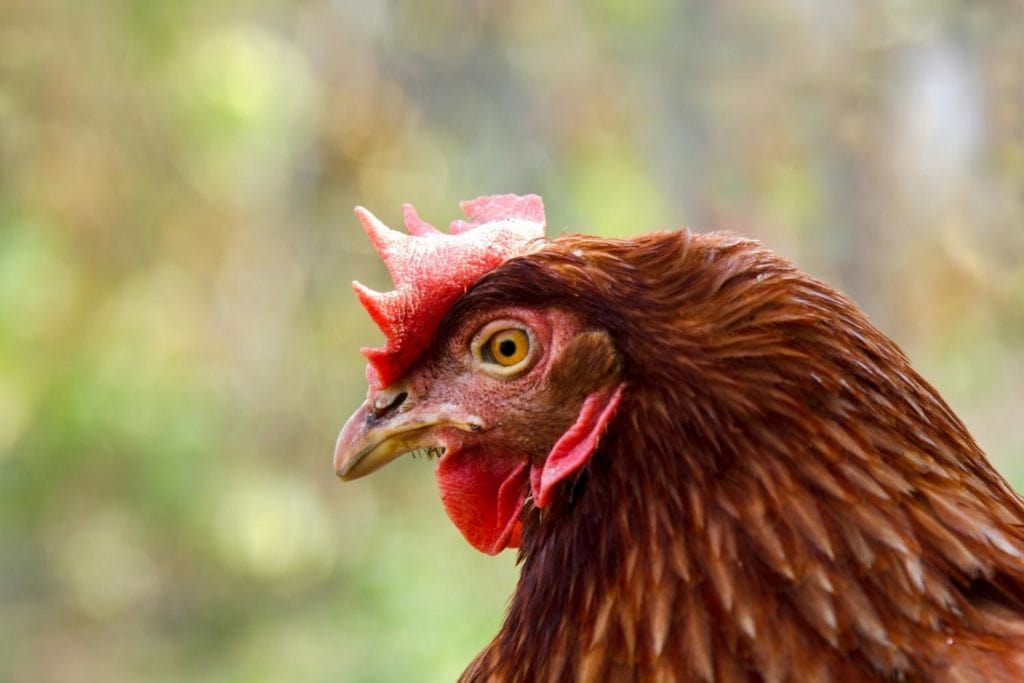
Classification
Family: Phasianidae
Genus: Gallus
Description: Wild chickens, or Red Junglefowl, are colorful birds. They may be gold, red, brown, orange, gray, and green. There is a white patch of feathers on either side of the chicken’s head where the ears are located. Their wingspan can reach 17.7-23.6 inches/45-60 centimeters in length.
The wild Red Junglefowl tend to be much more colorful than their domesticated cousins. Today, through breeding, there are hundreds of different kinds of chickens. They come in all different sizes and colors. Some chicken breeds are better suited for meat and egg laying, while others are kept mostly for their appearance.
Despite their being hundreds of breeds, there are a few things that characterize a chicken as a chicken. They have fleshy, lobed wattles that hang underneath their bills. They also have similar fleshy combs at the tops of their heads. They also have long tails that are positioned high above their back in an arch.
Diet: These birds are omnivorous, feeding on things like corn, grass, worms, grains, and other insects. In captivity, they mainly receive chicken feed that mostly consists of grains and their byproducts.
Habitat: Chickens were originally native to southeast Asia and the jungles of India. However, since they’ve been domesticated, they can be found almost everywhere.
In the wild, chickens tend to live in secondary forests that are very thick. They will roost up in trees and shrubs where they’re protected from predators. However, near dawn and dusk, they prefer open habitats where they search for food.
In captivity, they are provided with similar habitats. Most people will purchase a chicken coop where their birds can rest, but they will come outside during the day to feed in the grass.
Lifespan: About 2-4 years
Interesting Facts:
- Chickens were first domesticated about 10,000 years ago
- They are the most domesticated fowl on earth
- About 50 billion chickens are harvested every year for meat and eggs
- Chickens can produce eggs year round with artificial lighting
- Chickens can’t fly well and will usually only fly when they feel threatened
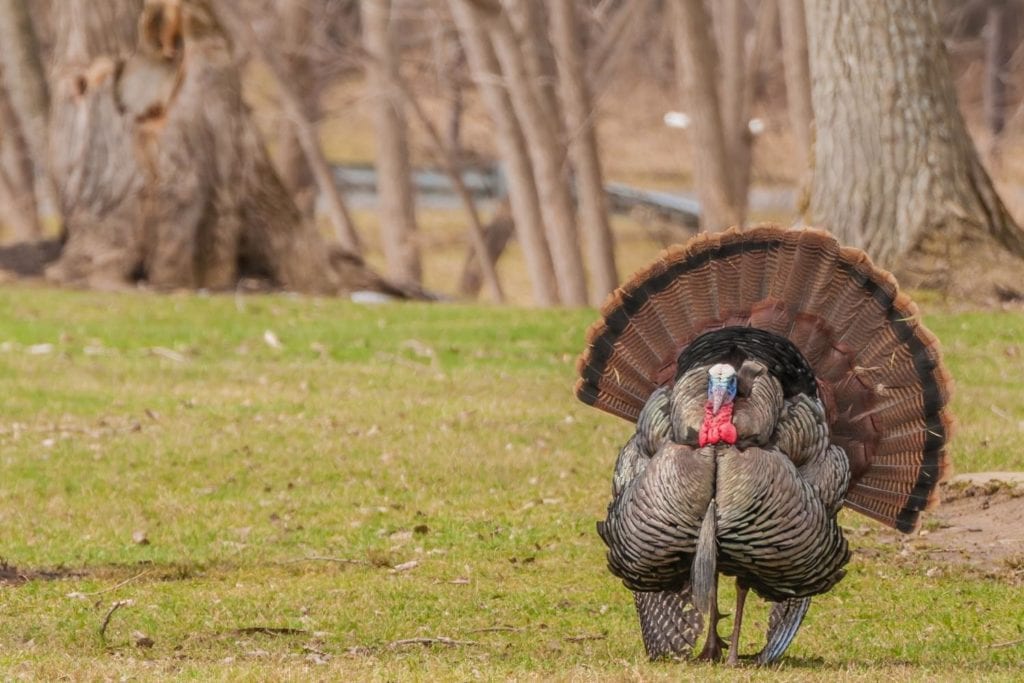
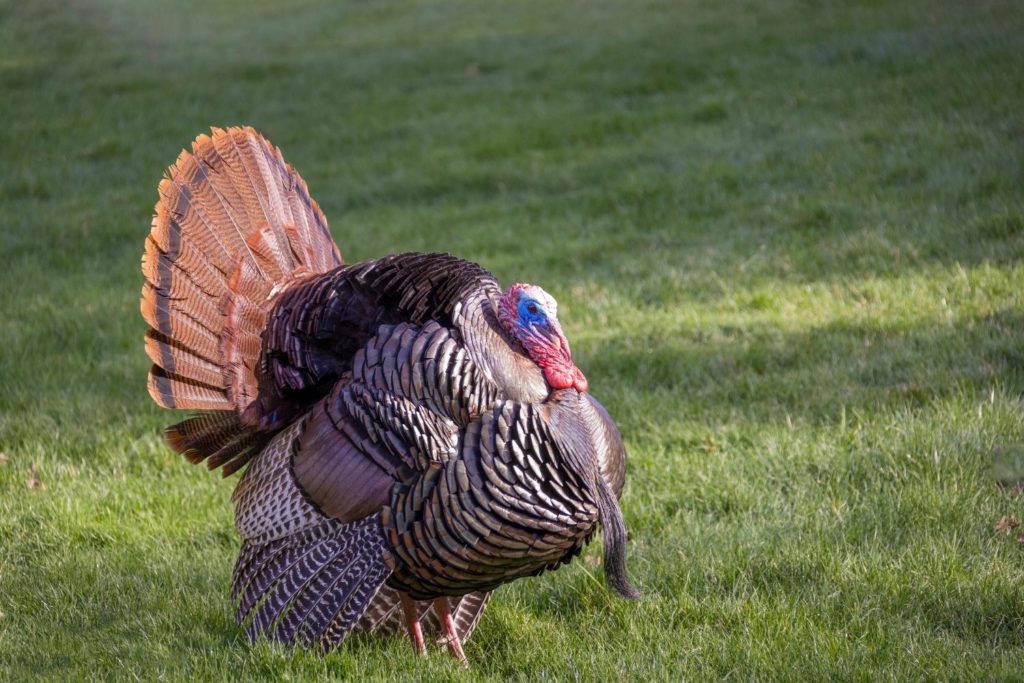
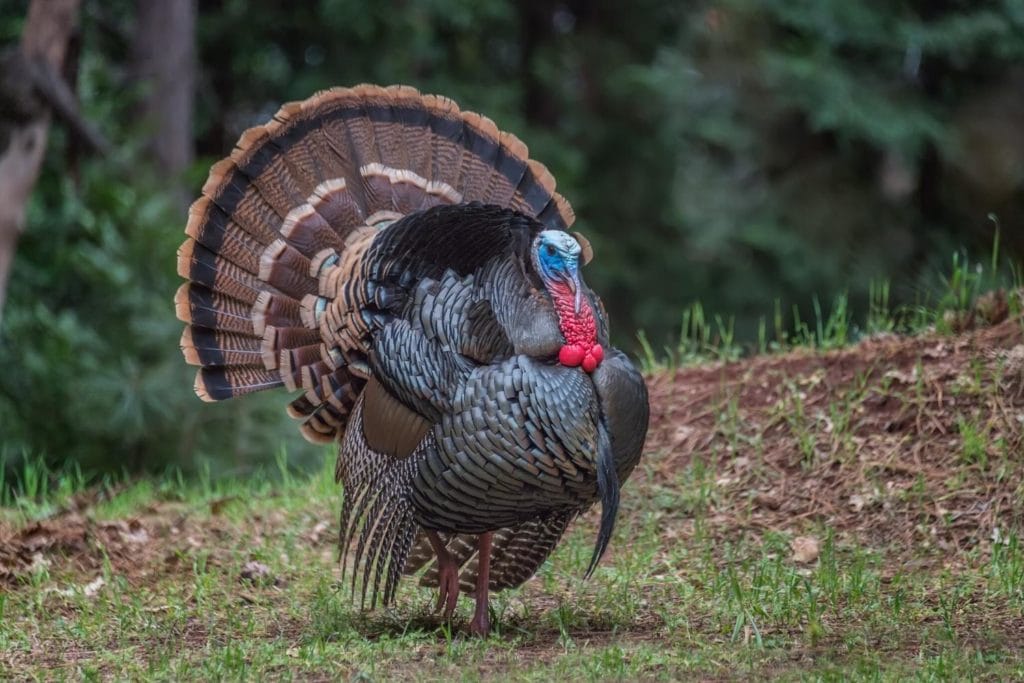
Classification:
Family: Phasianidae
Genus: Meleagris
Description: Wild Turkeys are large birds that live on the ground. Their tails are very recognizable because they’re large and shaped like a fan. Their feet are short, as well as their wings. Because of this, they are not good flyers. Their neck is long and bald, and their bill is small and curved downward.
You can tell the males from the females because the males have a beard on their chest. In other words, this is a large tuft of feathers. Their breast feathers are black at the tips, and they have a red wattle hanging from their neck and chin. They also have spurs on their legs.
The females are more subdued, their breast colors being brown, gray, or white instead of black. They don’t have any spurs, and they don’t have a wattle. The head is gray, and there are feathers on the neck, unlike the males.
Diet: These birds are omnivorous and can be seen eating fruit, seeds, nuts, insects, and even salamanders. Similar to chickens, they will search for their food on the ground, scratching at the dirt to locate the food.
Habitat: Wild Turkeys are found all throughout the eastern United States to the southern tips of Canada. They can be found as far south as northern Mexico and as far west as Arizona.
There are some isolated areas further west of Arizona where these birds can be found because they were artificially introduced. Interestingly, they have also been introduced to New Zealand and Germany.
These birds prefer to live in hardwood forests with nearby clearings like fields, orchards, and marshes. Similar to chickens, they will roost in trees and shrubs at night, but will scavenge the ground during the day for food.
Lifespan: About 1.3-1.6 years
Interesting Facts:
- The Wild Turkey almost became the national symbol of the United States instead of the Bald Eagle
- Although not common, they can live for up to 13 years
- You can tell a wild turkey’s gender by its feces: a male’s droppings will be shaped like “J”, while a female’s will be shaped like a spiral
- Males are the only ones who “gobble”
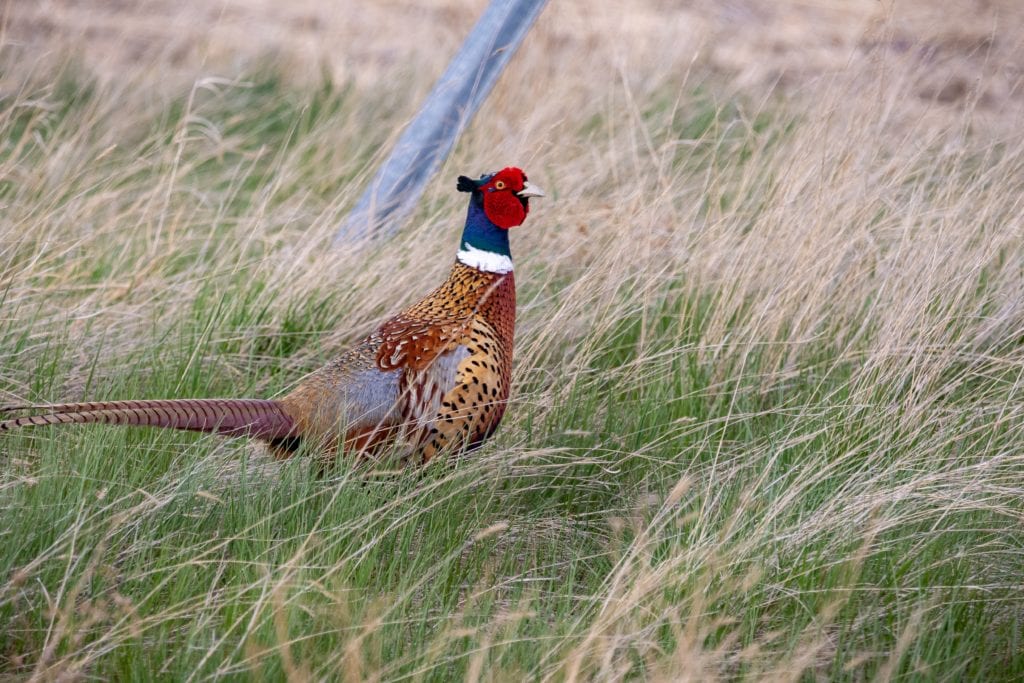
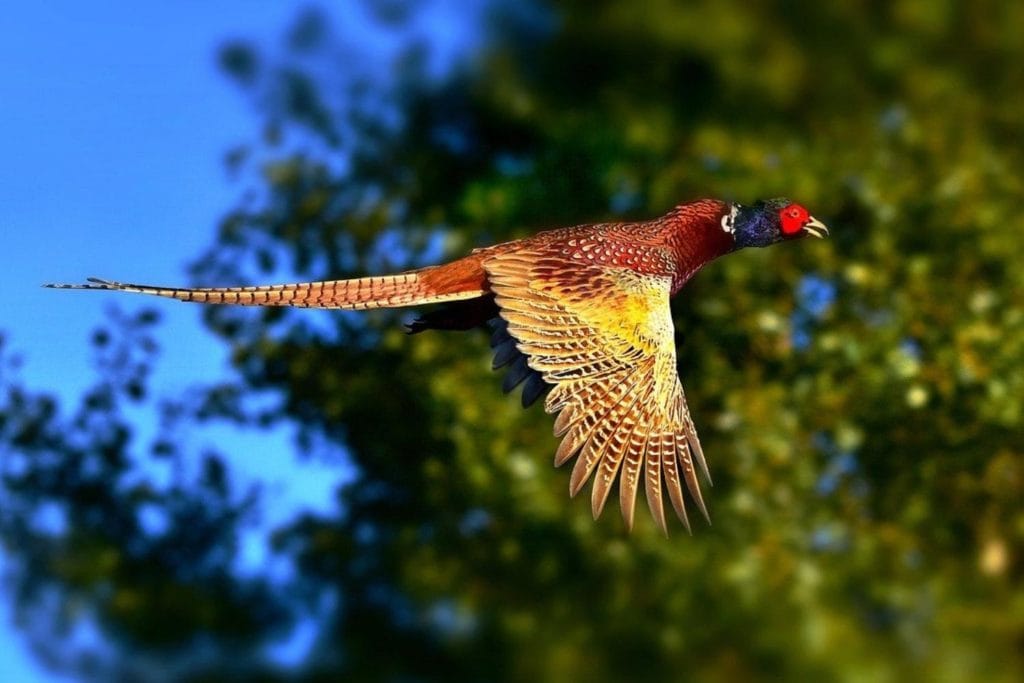
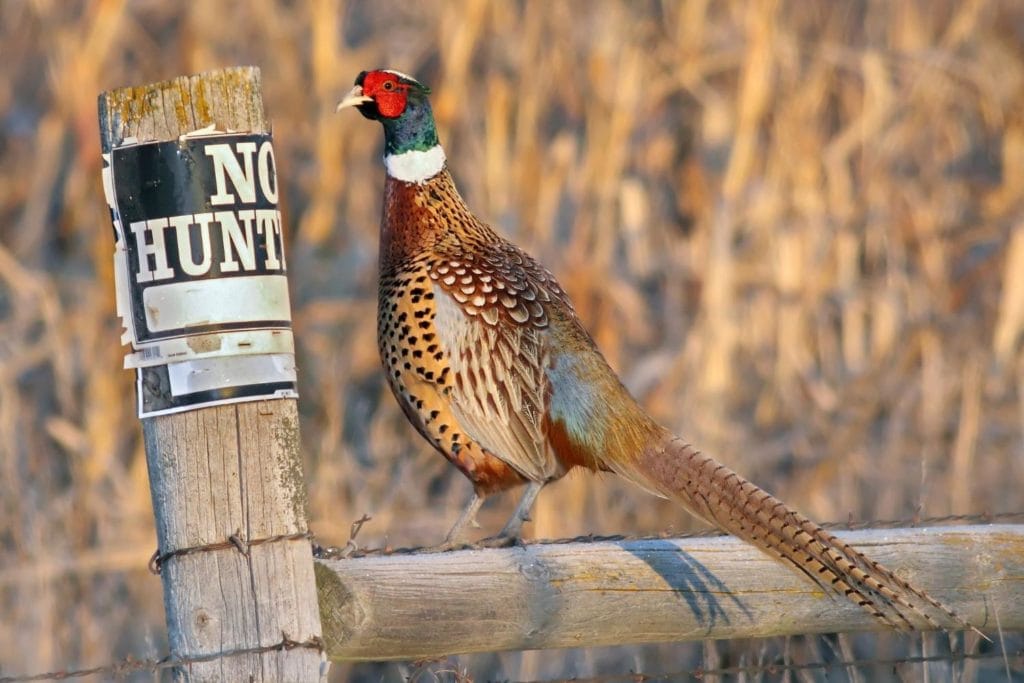
Classification:
Family: Phasianidae
Genus: Phasianus
Description: Ring-Necked Pheasants have pear-shaped bodies, but their heads are very small. To accompany their small heads, they also have very long, thin tails.
The males and females can be told apart because the males are much more colorful. Their plumage has lots of different colors, their eyes are rimmed with red, and their tails are barred. Many of these birds also have a white “ring” around their neck which is where they got their name.
The females, on the other hand, are more subdued. Their colors are more mottled browns. They do have the long, thin tails that the males have, but theirs is not barred.
Diet: These birds are omnivorous and will eat seeds, berries, grains, insects, and other small invertebrates. Like turkeys and chickens, Ring-Necked Pheasants are ground-dwelling birds. They will scratch in the dirt looking for their food.
Habitat: Ring-Necked Pheasants are native to Eurasia from the Caspian Sea, across to central Asia, China, Korea, and Japan. It was later introduced to Europe, New Zealand, Australia, Hawaii, and North America.
In North America, these birds can be found as far north as southern Canada, and as far south as Virginia. It can be found all the way west to California and as far east as the east coast.
Pheasants can be found living in grassland habitats and within farmland. They prefer areas that are more open, but still use high grass, ditches, hedges, and trees to hide themselves. However, they are generalists, and can be found in alpine forests and rainforests as well.
Lifespan: About 11-18 years
Interesting Facts:
- Ring-Necked Pheasants don’t fly well
- They bathe in dust
- Pheasants taste like chicken, but are a bit sweeter
Others
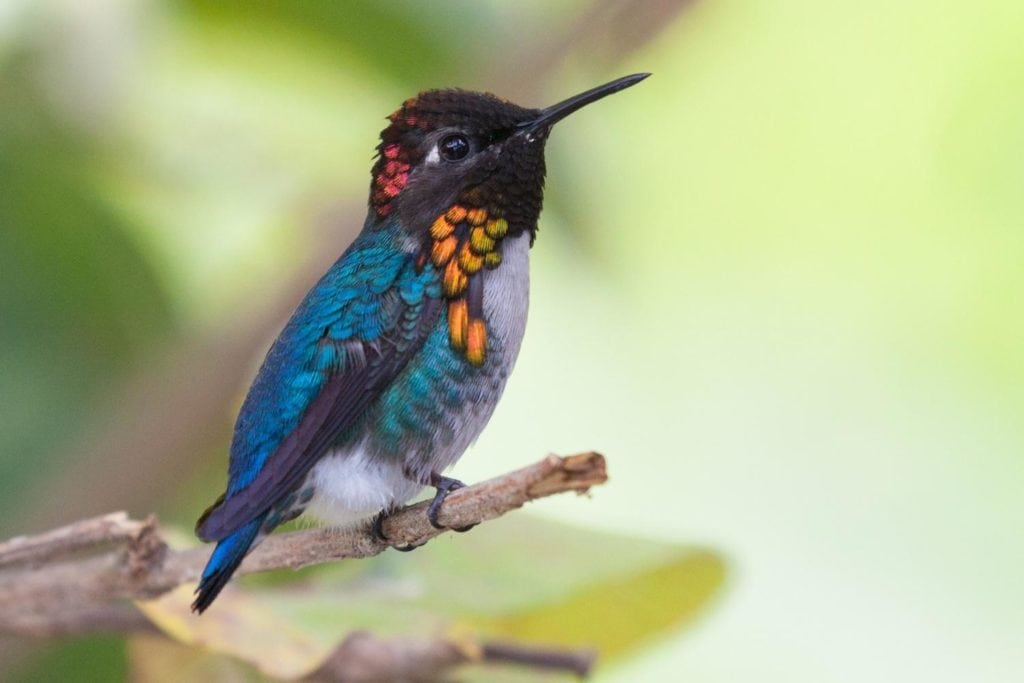
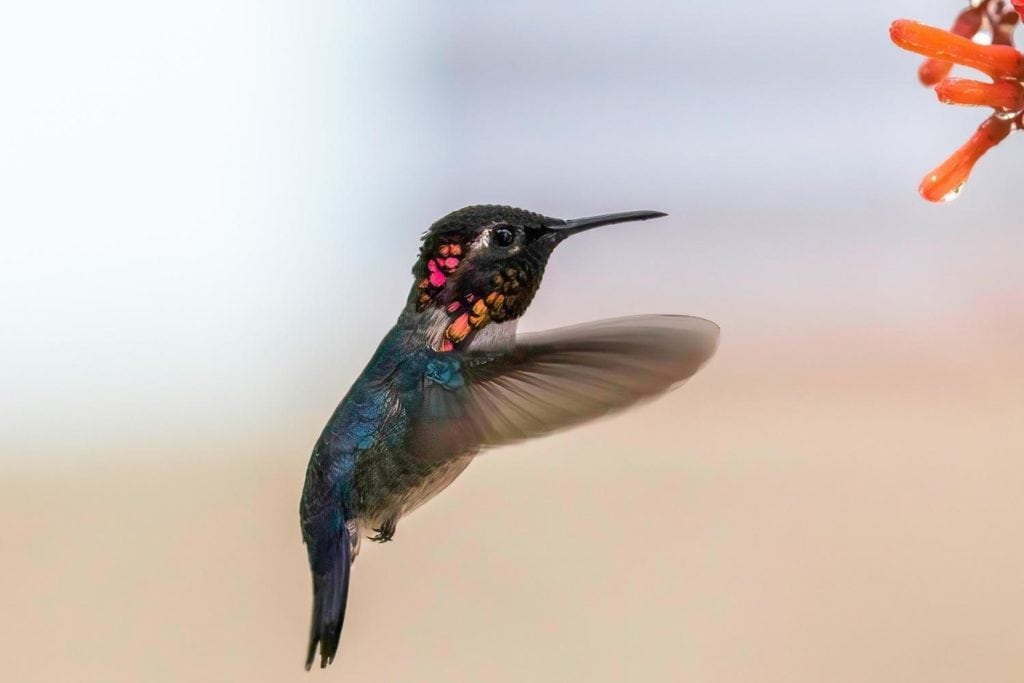
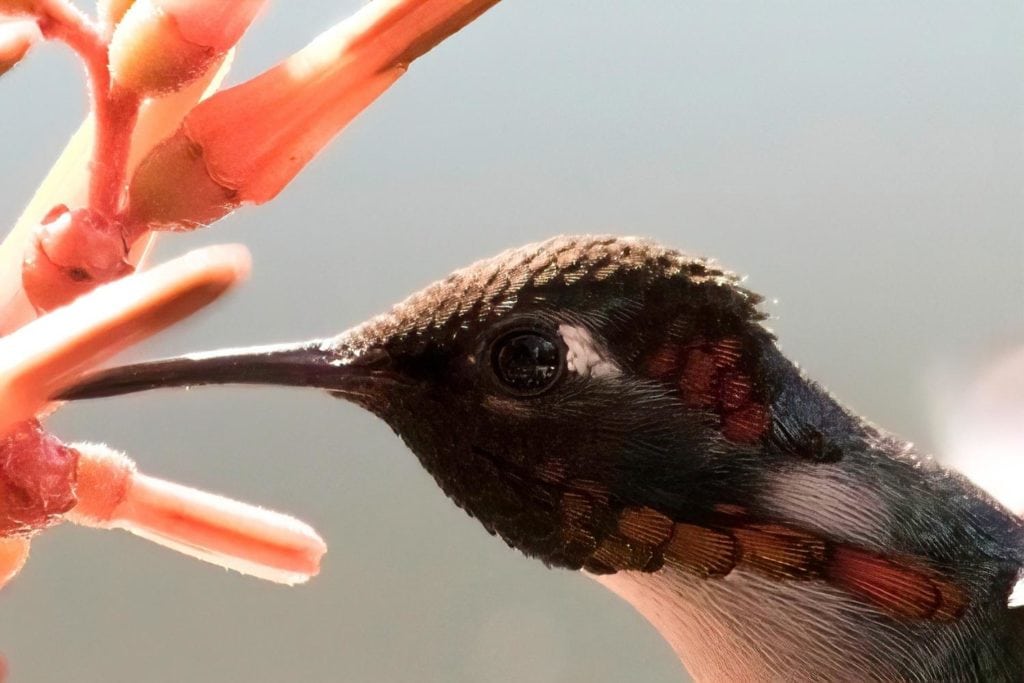
Classification:
Family: Trochilidae
Genus: Mellisuga
Description: Bee Hummingbirds are the smallest birds in the world. Males will grow up to 2.1 inches/5.5 centimeters, while females may grow up to 2.4 inches/6.1 centimeters. Their wingspan is about 1.2 inches/3.25 centimeters.
Their bills are shorter and straighter than other hummingbird species. Their feathers are very bright in coloration. Their throat feathers, in particular, are iridescent. The muscles that they use to fly are adapted to allow them to hover in place and make up 22-34% of their entire body weight.
Diet: These birds feed mostly on nectar from flowers and have a specialized tongue that allows them to do so. The tongue is very long and is protractile. However, they also use their beaks to find spiders and other insects within the flowers. They will eat their weight in food every single day.
Habitat: The Bee Hummingbird is native to Cuba. They can be found throughout the entire island as well as Isla de la Juventud — the largest island off the southern coast of Cuba. Occasionally, these birds can be spotted in Jamaica and Haiti.
These birds live in Cuba which has a subtropical climate. There are no extreme weather changes throughout the seasons, so it is a great environment for these hummingbirds. They like to live in areas with the plant Solandria Grand Flora which is where they get most of their nectar.
They prefer low altitudes over high and are most commonly found in coastal and inland forests, in valleys, in gardens, and in swamps.
Lifespan: Up to 10 years
Interesting Facts:
- Bee Hummingbirds spend more of their lives flying than any other bird species
- Hummingbirds are able to fly backwards and can make quick stops mid-air — this helps them out maneuver predators
- Bee Hummingbirds can fly at speeds up to 25-30 mph/40-48 kmh
- Hummingbird eggs are only about 0.5 inches/1.27 centimeters in diameter
You may also like: Learn the 344 Amazing Types of Doves All Around the Globe: With Images, Facts, and More!
Extinct Birds
To be considered extinct, an entire species must no longer be found on the planet. A species can also be considered “functionally extinct”, where the species still survives, but they have such a severe decline in population that they no longer play a role in the ecosystem.
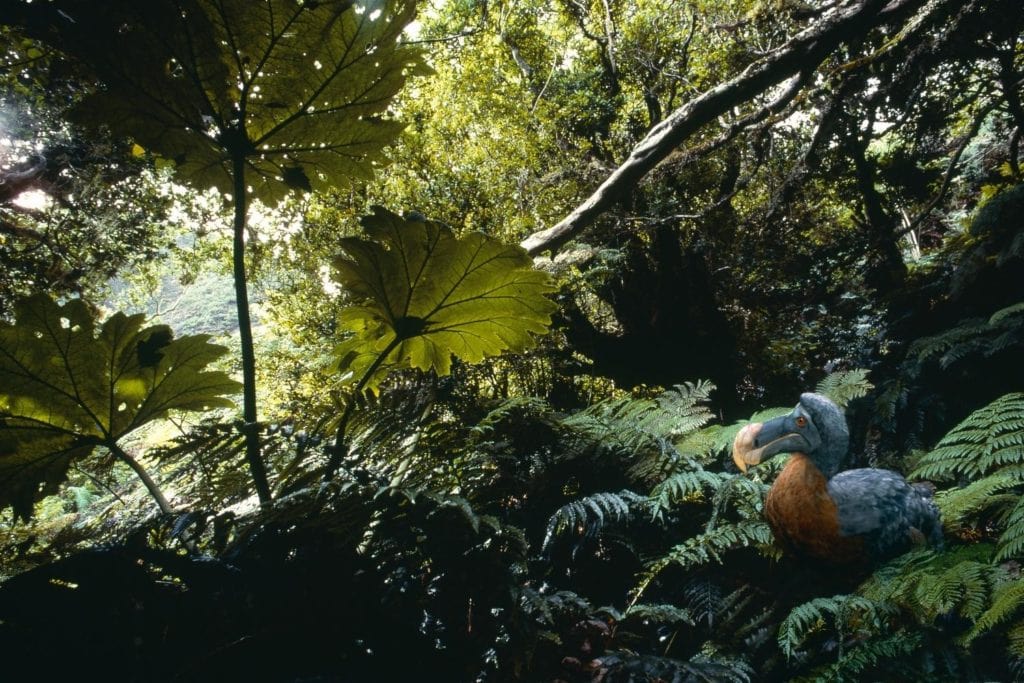
The Portuguese discovered the island of Mauritius in 1505. This was the home of the Dodo Bird, and up until this point, it was the perfect habitat because it had no natural predators. The Portuguese frequently made stops on the island to trade spices, but they posed no threat to the Dodo Bird.
It wasn’t until 1598 that the Dodo Bird was actually documented by a Dutch explorer by the name of Wybrand Van Warwijck. Over the next 100 years, the Dutch began to colonize the island and introduce non-native animals like pigs, monkeys, and rats.
The Dodo’s had no natural predators on the island, so they didn’t know how to defend themselves. Unfortunately, this left them easy prey for both the humans and the animals they introduced.
The Dodo’s were quickly killed off through hunting and the introduction of new diseases. By 1681, there were no Dodo Birds left.
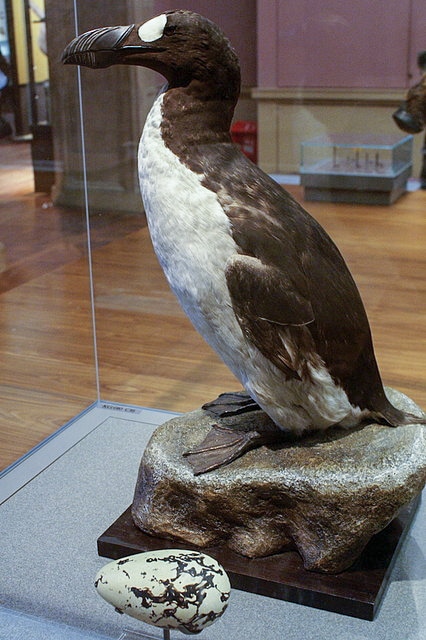
The Great Auk was a large flightless bird found in the British Isles. Although they were flightless, they were not made for land. They were great swimmers, but were very awkward and cumbersome on land. Because of this, they were very easily hunted.
Humans prized the Great Auk for its meat, feathers, and oil. Humans hunted them extensively for their resources, and they were in rapid decline by the mid 1500s. By 1794, the birds were almost extinct, so the British government stepped in, banning the killing of the birds for their feathers.
However, this intervention was too-little-too-late. The people refused to stop killing the Great Auk. In fact, the rarer these birds became, the more valuable they became, and the more likely they were to be hunted.
One of the last Great Auks was captured in 1840 by Scottish sailors. As they were traveling with the bird, they became trapped in a great storm. They were superstitious and believed the Great Auk had brought on the storm. Consequently, they stoned the bird to death for witchcraft.
Even more tragically, the birds were eradicated in 1844 on a hunting expedition. Two men were hired to go to Eldey Island to capture the only two remaining Great Auks. Not only did they capture and strangle these birds, but they also stepped on and destroyed the egg they were incubating.
Passenger Pigeons were a very common source of meat in the 19th century United States. By the 1850s, there were thousands of people working in the industry of commercial hunting. Unfortunately, the pigeons would fly together in large flocks which made them easy targets for hunting.
With the production of railroads, the hunting only increased. This is because trains allowed for fresh meat to be transported across the country.
At one point, it was thought that one meat processing plant was killing 18,000 Passenger Pigeons every day.
Besides hunting, the pigeon populations suffered from habitat destruction. When settlers came to America, they destroyed much of the habitat. This destruction ramped up in the 19th century when humans destroyed much of the country’s forests.
Eventually, so few Passenger Pigeons were left that they could not properly stimulate proper breeding habits. Their small flocks were also left unable to compete with other species.
By the year 1900, Passenger Pigeons were extinct in the wild, and there were few kept in captivity. The last Passenger Pigeon, Martha, died at the Cincinnati Zoo in 1914.
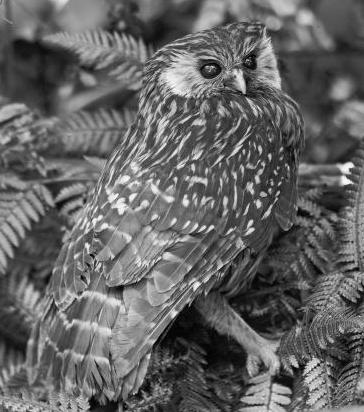
The Laughing Owl was native to New Zealand and became extinct in the early 1900s. The last owl that was seen was found dead in 1914. However, it’s believed that they may have existed into the 1930s because locals reportedly heard their calls.
The owls actually lived peacefully with humans, but their demise came about when humans introduced non-native species to the area. Laughing Owls used to nest on the ground which led to them quickly becoming prey to cats, weasels, goats, and rats.
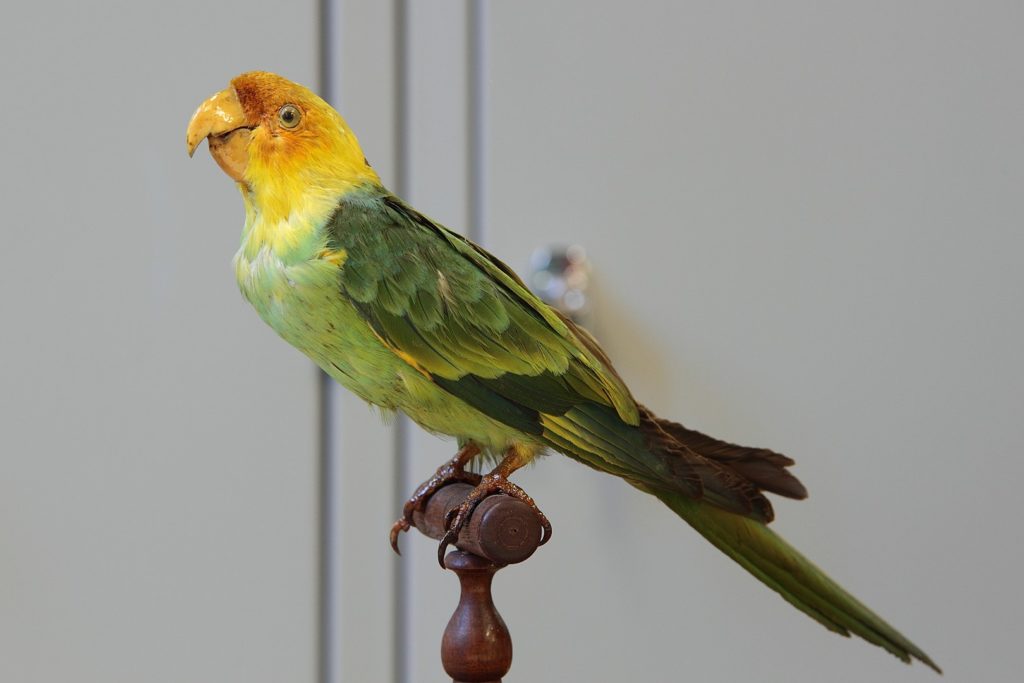
The Carolina Parakeet was unique because it was the only parrot species native to the eastern United States. It was found as far north as southern New York and Wisconsin, and was found as far south as the Gulf of Mexico.
Unfortunately, the last wild bird was eradicated in 1904 in Okeechobee County, Florida. The last surviving member of the species died at the Cincinnati Zoo in February of 1918.
Researchers did not know at the time that the birds were now extinct. They believed that some of the species had been smuggled out of the country and were still living elsewhere.
The extinction of these birds was brought on by a number of things. Loss of habitat was a huge contributor as humans made more room for agriculture. Farmers also killed them in large numbers because they believed them to be pests. The birds were often hunted for their feathers which were used to decorate hats.
The birds were commonly kept as pets at the time, but unfortunately, most owners did not try to breed them.
You may also like: Discover the 19 Adorable Penguin Species: Complete with Images, Facts, and More!
FAQ
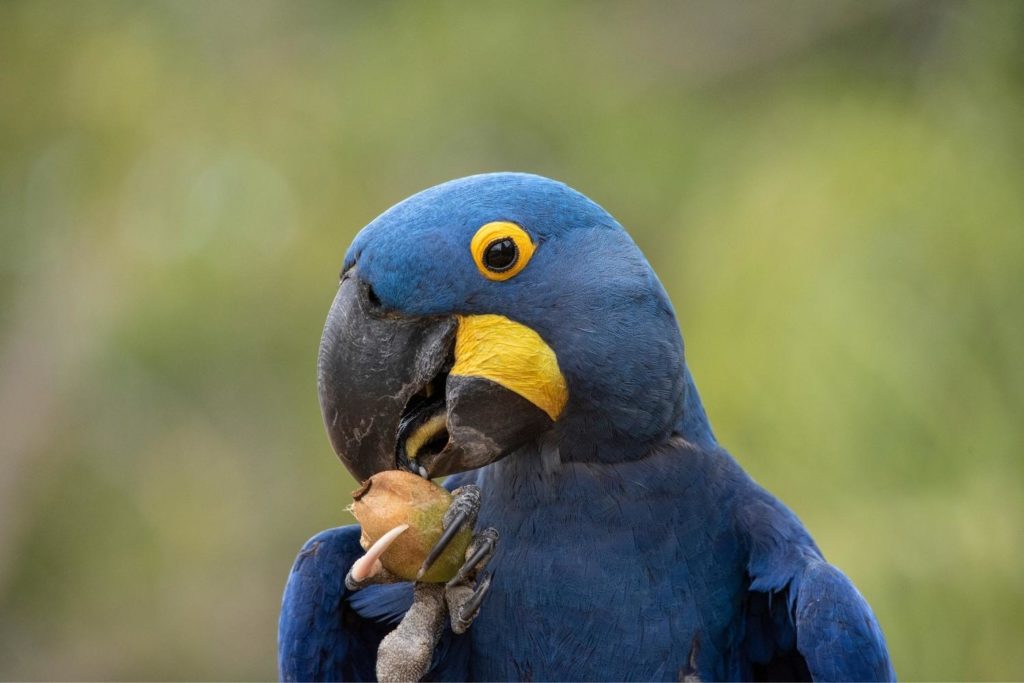
The short answer to this question is that no, birds are not mammals. Although, they do have a few similarities. Instead, birds are classified as Aves.
The way that animals are classified into certain groups is dependent mainly on their physical characteristics, both inside and outside the body. Birds simply have too many differences from mammals.
Let’s start with the similarities. Birds and mammals do have some significant similarities that lead to people getting them confused. These include:
- Birds and mammals are both warm blooded: they can maintain a constant body temperature
- Birds and mammals are both vertebrates: they have a backbone and a skeletal system made of bone
- Both birds and mammals have 4-chambered hearts that contain white and red blood cells
- Birds and mammals must both eat according to their body weight
- Both birds and mammals must stay active, even during the colder months
Now, let’s cover the differences. Here are the key ones:
- Birds have feathers, most mammals have hair or fur
- Birds have hollow bones that allow them to fly, mammals bones are solid
- Birds have beaks, mammals have teeth
- Birds lay eggs, mammals give birth to live young
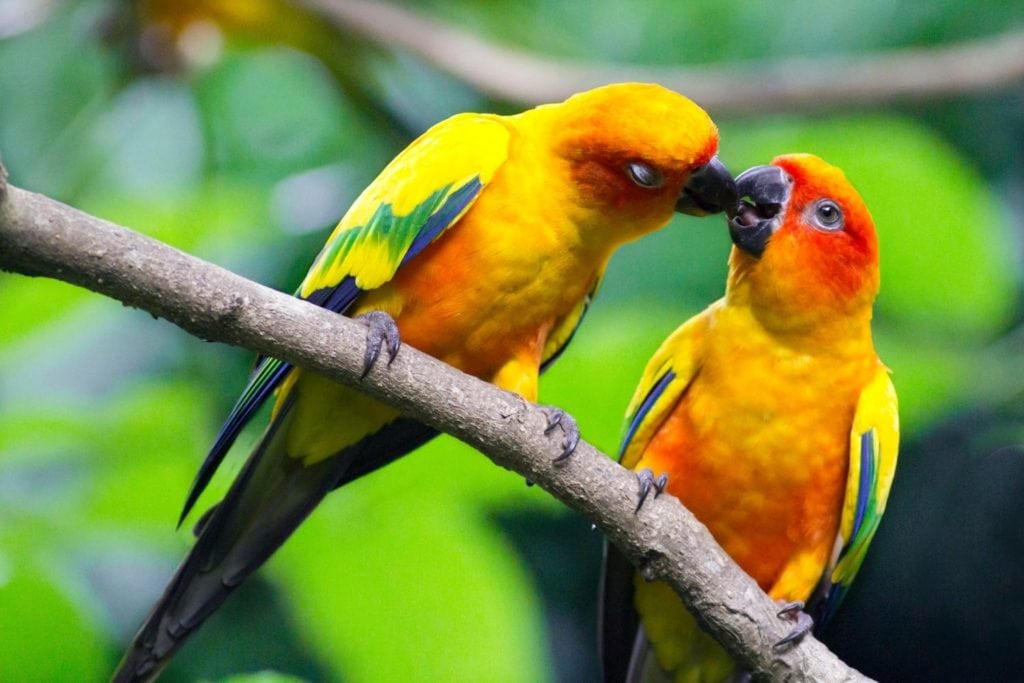
So, we’ve determined that birds are not mammals. This means that their reproductive systems are not the same, either.
Both male and female birds have an opening called a cloaca, or a “vent”. The cloaca is used as an exit for their waste as well as the exit for their eggs. Typically, you can not see the cloaca. However, during the breeding season, the cloaca may swell so that it protrudes somewhat out of the body.
Now, like mammals, male birds have testes and female birds have ovaries. The males hold the sperm within their cloaca until they’re able to mate. The females will receive the sperm which then fertilizes their ova and creates an egg.
When the birds are ready to mate, they will first court each other. This may be done with singing, dancing, showing off their plumage, or performing special flights.
Once a partnership has been established, the actual mating can occur. Usually, the male will take his spot on top of the female. He will physically stand on her back, but she will usually hunch over or lay down to make it easier for him.
Then, the female will move her tail to the side, and the male will tuck his tail under hers. This allows for both of their cloacas to touch, and they will rub them together for the transfer of sperm.
The actual mating process may only take a few seconds, or could take several moments. The two birds are also likely to mate multiple times throughout a couple weeks.
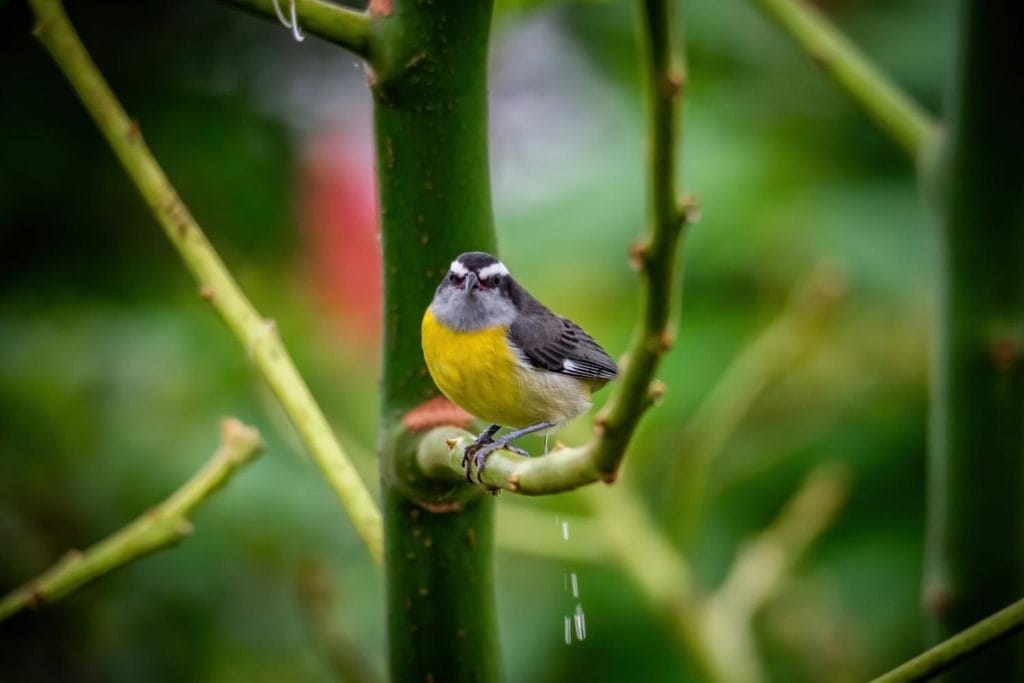
Unlike what you’d think, this isn’t a simple “yes” or “no” question. To understand the waste production of birds and whether or not they actually “pee”, you need to know how their bodies work.
In mammals, waste is separated into solids and liquids. Unprocessed food makes its way out of the body through solid waste, or feces. Liquid waste, or urine, has been filtered out of the blood to maintain healthy levels of chemicals in the blood.
Technically, birds do pee, but it doesn’t look exactly like liquid waste. In mammals, the solid and liquid waste is separate and exits the body from two separate locations.
In birds, the solid and “liquid” waste both leave the body from the cloaca. Birds do have a urinary tract like mammals, but the urine does not come out on its own. Instead, it combines with the solid waste before leaving the cloaca.
You may think that this combination of wastes would make a bird’s waste extremely runny. However, it’s a bit more complex than that. The reason that I put “liquid” in quotations in the paragraph above is because birds don’t really create urine or any form of liquid.
Urine consists of several different substances and leaves the body as a liquid. Uric acid, on the other hand, is simply a component of urine. Birds create uric acid, but not urine. Because of this, a bird’s “pee” leaves the body as a type of solid combined with the poop.
Interestingly, you can usually tell these fecal and uric acid components apart. Most bird poop will have a white center with a ring of brown around it. That brown ring is mainly fecal matter, while the white center is the uric acid.
Why do birds eliminate waste this way? This answer is simple: it makes them lighter, making it easier to fly. Flying requires a ton of energy. The more weight you have to carry around, the more energy you’re going to use. Liquid has a lot of weight.
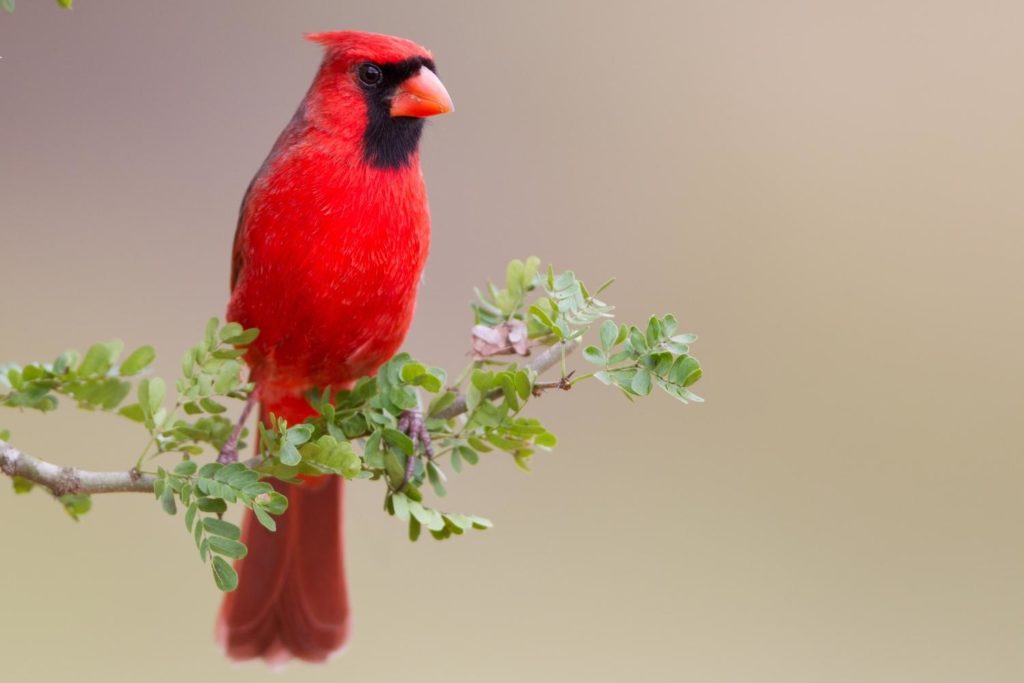
It’s likely that you’ve noticed that in most bird species, the males are more colorful than the females. But, have you ever wondered why that is?
Charles Darwin came up with the idea that species will retain the traits that better help them survive. Traits that are not necessary to survival or are detrimental to survival will eventually be phased out. This is the process of natural selection.
Now, there is a similar process called “sexual selection”. Darwin says that these are traits that will help the survival of an individual of only one sex. Males will usually have one of two features related to sexual selection: those that act as weapons (i.e. antlers or tusks), or those that are ornamental (i.e. feathers).
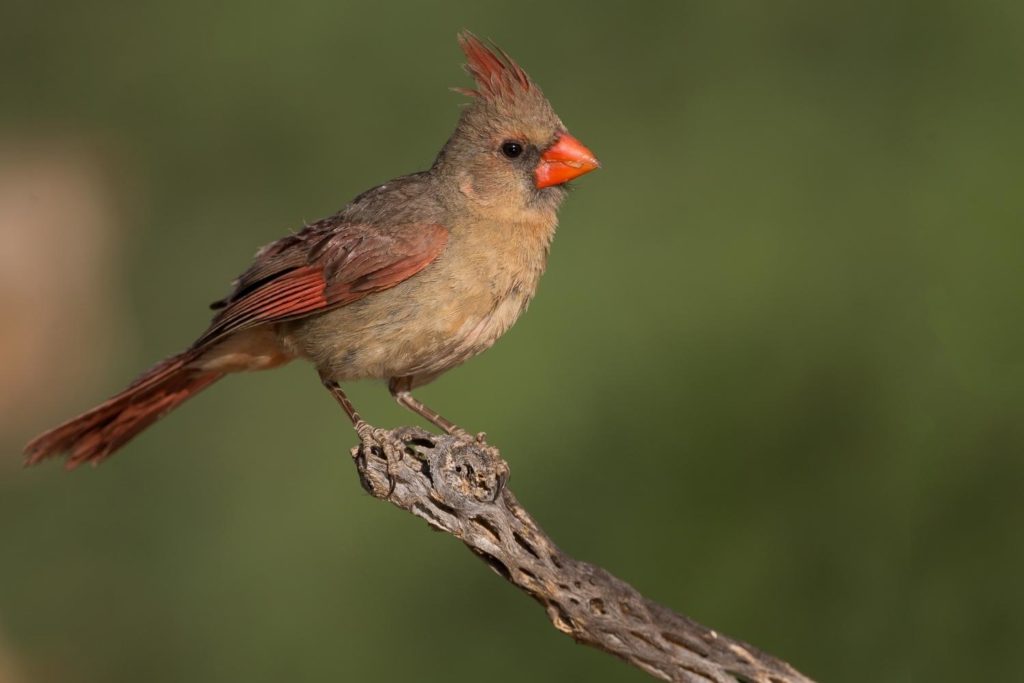
Researchers believe that male birds tend to be more colorful than female birds because it helps their survival. Female birds seem to prefer the more colorful males and will only choose to mate with them. This is likely because a brightly colored male bird is an indication that he is healthy and strong. These are traits that the female would want to pass on to her offspring.
On the other hand, males are not typically picky about their mates because there aren’t usually a lot of options. Reproduction on the female’s part takes a lot more work and energy than on the male’s. This results in there being less females than males, so the males have to compete with each other for a mate. This is why those bright, beautiful colors are not necessary for females.
Bright colors are not only used by males to attract females, though. They will also use their bright colors to compete with other males. They use the colors as an intimidation tactic to claim their territory or resources. Bright colors suggest that the male is healthy and strong which will deter other males from wanting to fight.

Maybe you have pet birds and don’t want to bring smells into the home that will bother them. Or maybe, you dislike birds, and they’re becoming a nuisance in your backyard. Either way, you’ll be interested to know which smells birds hate the most.
Here is a short list of bird’s most hated smells:
- Bird gel
- Cayenne pepper
- Chili
- Essential oils
- Garlic
- Vinegar
Using smells as a bird repellent around your yard can be effective. They are kinder than other bird repellents that people use such as spikes and netting, and they’re often more effective than decoys.
Scents can be placed in locations that are hard to reach, they don’t make any noise, and they often smell good to us as humans.
There are many birds around the world that can mimic sounds, but did you know that some birds can talk? Okay, not really, but they sound like they do. Just like most birds can mimic sounds, there are some species that can mimic speech.
Most commonly, these bird species are kept as pets, and that’s how we know they can “speak” so well.

African Gray Parrots can talk and seem to be able to understand some language as well. It just takes a bit of learning. Unlike many birds who can only speak singular words, African Grays can speak whole sentences, and seem to have more emotional and self-awareness than other birds.
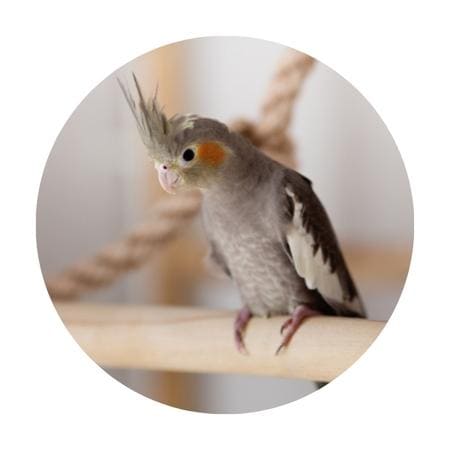
Cockatiels can talk as well, but they can’t pick up the words and sounds as quickly as African Grays. Simple, one syllable words are best. Unlike some birds who pick up speaking easily, you’ll more than likely have to teach your cockatiel to talk. This takes patience and lots of training sessions.
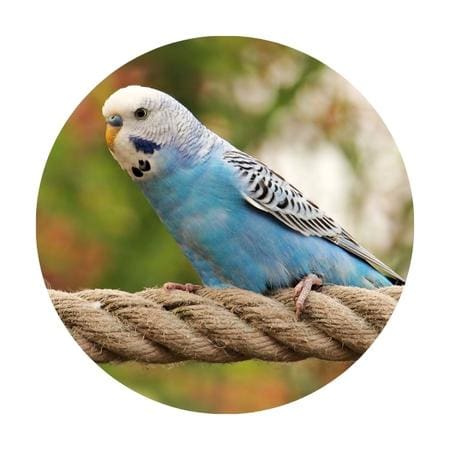
Parakeets are very smart birds as well that can be trained to speak. They are a bit quicker than cockatiels, and are likely to pick up words even without training. Unlike African Grays, parakeets don’t seem to understand any speech and will simply mimic words at random.
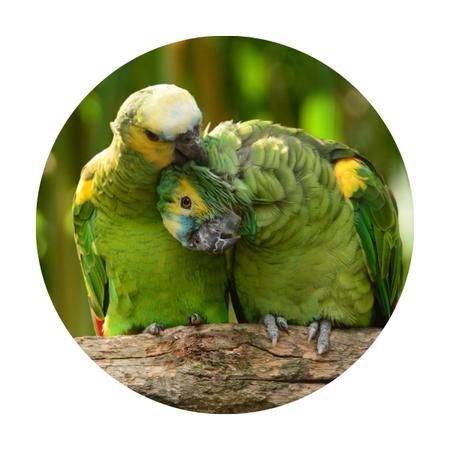
Amazon Parrots are also very intelligent birds, but like cockatiels and parakeets, it’s better to start with easy words. Also, they aren’t likely to speak if they aren’t happy.
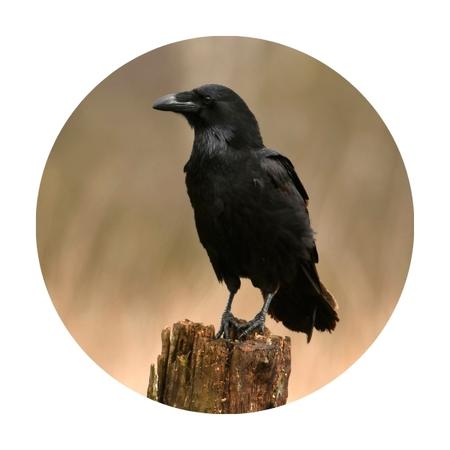
Ravens are incredibly intelligent creatures and have been known to mimic human speech. Not only that, but they’ve even been known to mimic the sounds of other animals like foxes and wolves! They have also been known to mimic many random sounds that they hear like cars, bells, or squeaking.
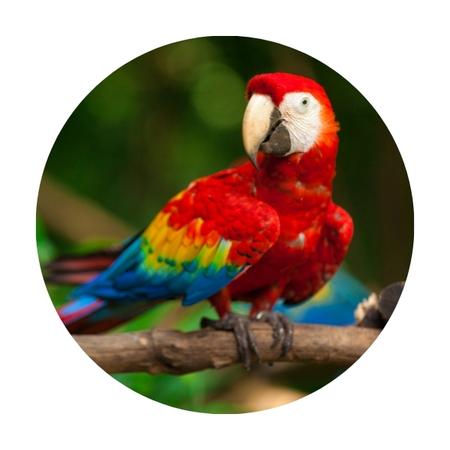
Macaws are one of the most popular talking birds because of their large size and bright colors. They are also one of the loudest and most talkative birds on this list. Like some humans, Macaws simply talk because they like to hear themselves talk. You may hear them mimic words, or squawk and chatter.
A wide variety of birds call America their home, inhabiting the horizons of the continent. Discover more bird species in different states in the links below:
You may also like to read the different animal categories some of the bird species belong to:





